

5 Must-Visit Costa Rica Volcanoes

Home » Things to do » 5 Must-Visit Costa Rica Volcanoes
One of your first thoughts upon imagining Costa Rica should be volcanoes. The country contains over 60 which are considered extinct or dormant plus six which are still active. There is an array of activities all centered around their impressive and imposing heights. The heat from magma that has risen close to the surface has resulted in hot springs whose mineral water is a draw for spa enthusiasts. The slight changes in altitude create a hotbed of biodiversity seen nowhere else in the world, drawing tourists and scientists alike. If you’re planning a trip to Costa Rica and need to see a volcano, don’t miss our list of the top Costa Rica volcanoes to visit for the ultimate thrill.
Arenal Volcano
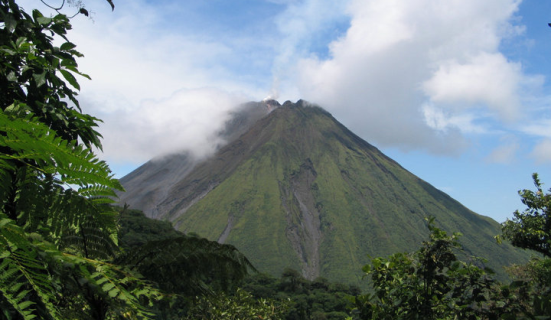
Without a doubt, however, the most popular of Costa Rica’s volcanic giants is Arenal. Located in the northern part of the country, it towers over the surrounding fertile landscape, surrounded by plantations producing the best coffee in the world. The symmetrical cone-shaped Arenal Volcano erupted in the past an average of 41 times a day. While it currently slumbers, Arenal and the surrounding area are a great base for adventure touring.
Poás Volcano

Poás Volcano is one of the most popular destinations in the Central Valley . It is one of the world’s largest active volcanoes, with sulfuric emissions, active fumaroles, and two crater lakes. The northern lake, called the Laguna Caliente (hot lagoon) is one of the world’s most acidic lakes, in direct contrast to Lake Botos, the southern, which is cold, clear, and surrounded by the beauty of the cloud forest. Poas Volcano closed back in April 2017 as the result of volcano eruptions but has since reopened.
Related Article: Poás Volcano National Park Guide
Rincón de la Vieja Volcano

Rincón de la Vieja Volcano
The largest and arguably most temperamental volcano in the Guanacaste region is the Rincón de la Vieja Volcano. Her temper trickles into the surrounding national park in a series of volcanic hot springs, waterfalls, and bubbling mud pools. Legend has it that a wise old medicine woman lived on the slopes of the mighty volcano until her death. Her presence was so strong in the region that the volcano now bears her name, literally translating to “the corner of the old lady.”
Related Article: Rincon de la Vieja National Park Guide
Irazu Volcano
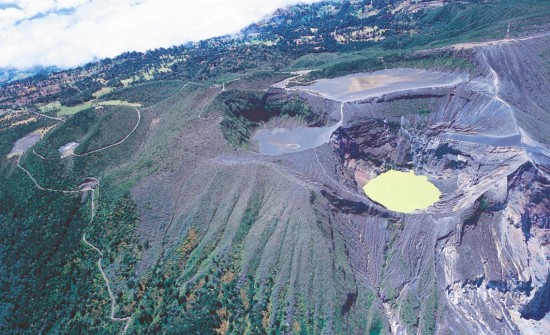
The Irazu Volcano is located in the Central Valley near the capital city of San Jose . Irazu has two main craters, one containing a green-tinted lake. The craters are easily accessible from San Jose by a road that leads straight up to the summit craters. Although the volcano’s summit is usually cloud-covered, Irazu is the tallest active volcano in Costa Rica at 11,260 feet tall. The smaller of the two craters is Diego de la Haya.
Turrialba Volcano
The Turrialba Volcano, also near San Jose , can be a little difficult to get to. The hike to the top, where motorized vehicles are not permitted, can take between 1 and 3 hours. The surrounding park sees fewer tourists than others in the country and the trails tend to be more rustic and challenging. However, the incredible views throughout the park are well worth the work!
At this time, travelers should not visit Turrialba Volcano due to volcanic activity.
Costa Rica Volcano FAQ:
You deserve a vacation planned by experts., us headquarters, costa rica office.
Barrio La California, Calles 27 & 29, Ave 2, Ed #2798 Oficina #8 San Jose, Costa Rica 10104
READ OUR REVIEWS

- DESTINATIONS
- THINGS TO DO
- PLAN YOUR TRIP
Privacy Overview
This is a necessary category.
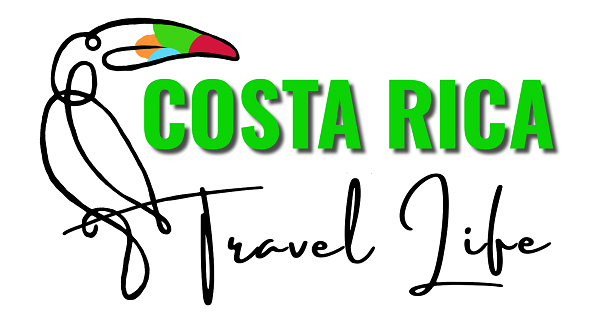
Home » Travel Planning and Inspiration » 7 MUST-VISIT Volcanoes in Costa Rica
7 MUST-VISIT Volcanoes in Costa Rica
By Author Costa Rica Travel Life
Posted on Published: June 16, 2022 - Last updated: April 4, 2024
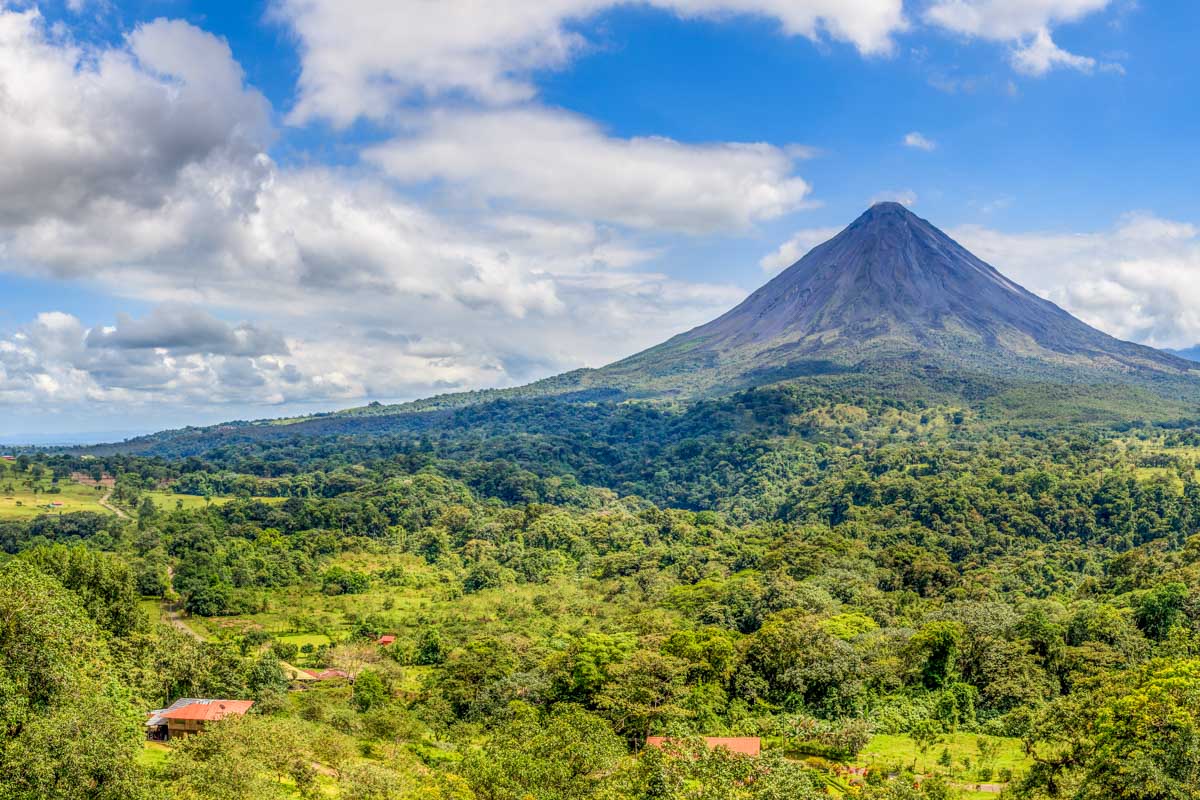
This blog may contain affiliate links. Read our disclosure policy for more info.
Costa Rica is quite the destination for volcano lovers (like myself.) In fact, there are 66 well-identified volcanoes here, five active and another 61 dormant or extinct. With that said, there are believed to be over 200 volcanic structures in the country, with many still undiscovered and hidden by dense rainforests. Pretty cool, right?
All of these volcanoes run along the center of the country, on what is known as the Central American Volcanic Arc . This area has the greatest density of volcanoes of anywhere else in the world and stretches from Mexico to Panama.
The five active volcanoes, and most popular, in Costa Rica include Poas, Arenal, Rincon de la Vieja, Irazu, and Turrialba. The sixth is Miravalles, but it’s not that popular to visit.
In this blog, I will detail the seven must-visit volcanoes in Costa Rica. I will share with you my personal opinions on why you should visit each one as well as cover how to get there, how much tickets cost, and some other helpful tips like when to go and what guided tours are the best-rated !
It’s your complete guide to Costa Rica’s best volcanoes!
Best Volcanoes in Costa Rica
1. poas volcano .
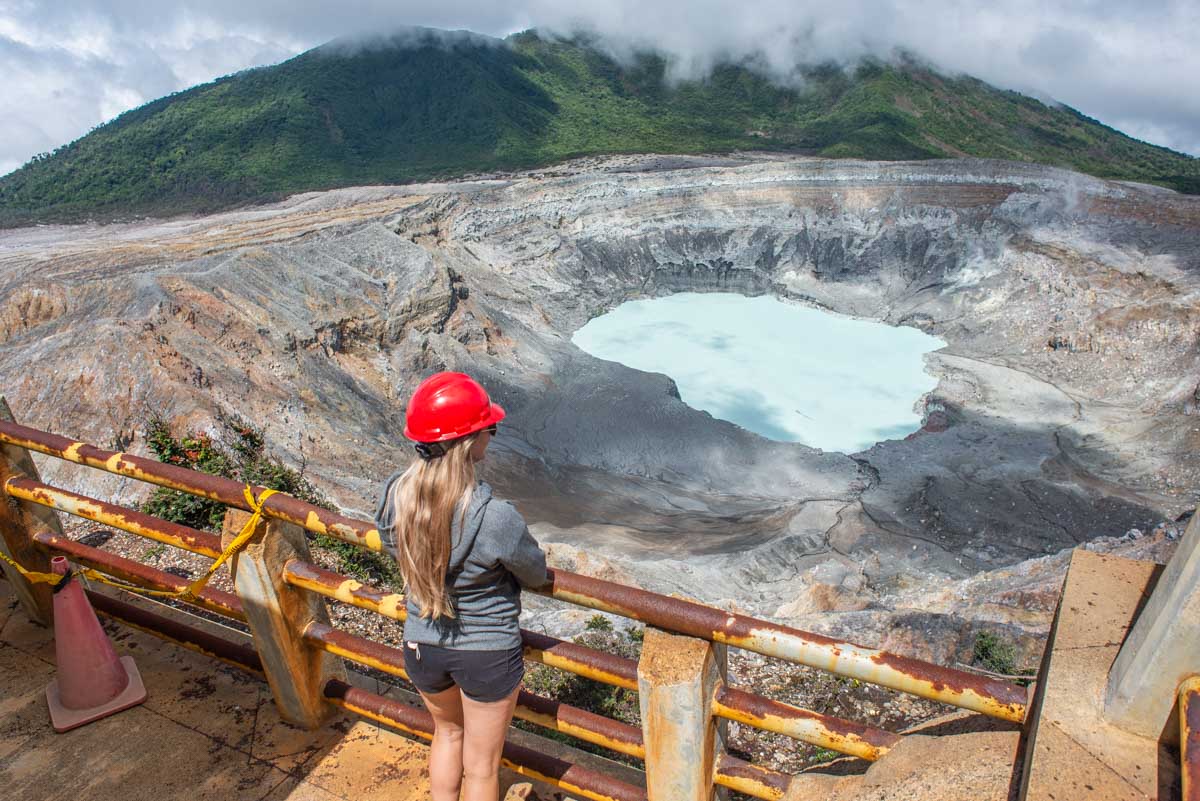
The super-active Poas Volcano is just an hour and a half drive from the center of San Jose. It towers over Parque Nacional Volcán Poás at 2,697 meters (8,848 feet)! Would you believe it’s erupted 39 times since 1828!
This volcano is most well-known for its blue acid lake, which is, in fact, one of the biggest craters in the world! It’s quite a sight to see this massive crater in person – it’s a whopping 1.5 km (0.9 miles) in diameter. It’s no wonder this is one of the top attractions in Costa Rica !
For the best view of the crater, pick a sunny day and start climbing as early as possible to avoid the clouds that tend to cover the volcano in the late afternoon. This is my top tip for Poas Volcano because I learned this the hard way – the first time climbed all the way up, only to see nothing but clouds!
After arriving at the volcano, you’ll enjoy a short brief and safety video about the volcano and what to do in an emergency. After, it’s time to hike to the volcano. The hiking trail to the observation deck over the crater is only short and mostly along an access road which takes around 15 minutes. Once at the crater, you can stare into the volcano and take a look around for about 20 minutes.
Poas Volcano National Park is open every day from 8 am to 3:30 pm, and tickets cost $15 USD for adults and $5 USD for children (there are discounts for nationals.) You MUST book your ticket online in advance via the SINAC website because not only are a limited number of tourists allowed per time slot to the crater, but they do not sell them at the entrance. During peak season, the early morning time slots book up days in advance. Note, if you book a guided tour , entrance tickets are often already included.
To get to Poas Volcano National Park, renting a car is best – especially considering it’s just a 2-hour drive from San Jose. Our favorite company to use in Costa Rica is Discover Cars . With your own car, you can take your time at the crater, go on some hikes and even visit some traditional villages close to the entrance to the park, such as Varablanca and Fraijanes.
If you love strawberries like me, then you’re in luck because this area of Costa Rica is famed for its delicious strawberries. On your drive to the volcano from San Jose, you will come across some roadside stalls selling large varieties of these berries. You can also pick up other unique delicacies from vendors like the area’s famous Palmito Cheese!
If you don’t have a car, it’s best to book a guided tour. You can check all of our recommended Poas Volcano tours here or go ahead and book this tour, which leaves San Jose at 8 am and includes your entrance fee to Poas National Park. What’s great is that if you book this particular tour, you can skip the typically long lines at the volcano.
If you want to combine two of the best attractions near San Jose into one day, then consider booking this full-day tour which visits the volcano as well as La Paz Waterfall . It departs from San Jose and is 12 hours in duration.
Related Read: Check out our top safety tips for visiting Costa Rica !
2. Arenal Volcano
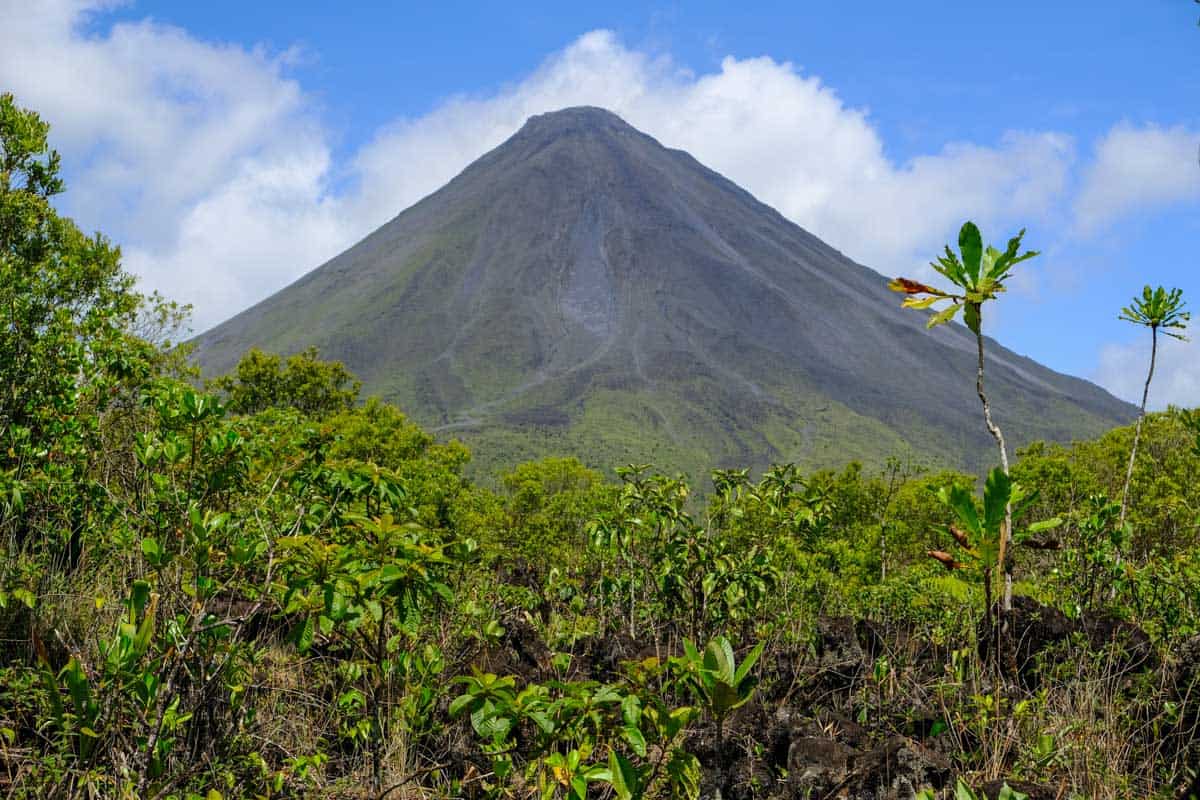
A 3-hour drive from San Jose is the 1,657-meter (5,436 feet) tall Arenal Volcano; it’s considered an active volcano and last erupted in 2010. Before this, Arenal was considered the most active volcano in Costa Rica and had a major eruption in 1968. It’s illegal to climb to the top of Arenal, but many people still make the 10 to 11-hour hike!
If you plan to drive here from San Jose, it’s best to leave early in the morning so that you can take your time. If you have time, stop at the Arenal Lagoon, which is a lovely place to relax, or tick off some of the hot springs in the La Fortuna area off your list.
With that said, the closest town to Arenal is La Fortuna, which sits only 15 minutes from the entrance to the park. La Fortuna is a popular place to visit in Costa Rica and is home to plenty of things to see and do!
Within La Fortuna town, there are plenty of vantage points of the volcano. But, as is the case with many other volcanoes on this list, clouds can often cover the summit, especially later in the day, making it invisible. It’s best to avoid the area during the rainy season, which is from May to November – if seeing Arenal is important to you, then aim to visit in February!
If you’re keen to get a good look at the volcano (or hike up it, which I don’t recommend as it’s illegal), it’s best to spend a few nights in the town of La Fortuna , which is the gateway to the National Park. Luckily, there are loads of great hotels in La Fortuna , as well as fantastic places to eat .
Exploring the park is quite an adventure, and you can explore around the volcano’s base. You can experience the park on your own and hike one of the many hiking trails there. The great thing about the trails is that there are different viewpoints of the volcano to be enjoyed along the way. There’s even a section where you can see where lava from the last major eruption flowed down its side.
I visited Arenal Volcano National Park on a guided tour simply because I love hearing all about the area from a knowledgeable guide. This specific tour is a great option as it includes all your fees, water, transport, and a guide. If you’re short on time, you should consider booking a combination tour. This full-day tour visits Arenal and La Fortuna Waterfall , a butterfly garden, Maleku Indian village, and the free hot spring river.
As mentioned, Arenal Volcano is located within Arenal Volcano National Park. The admission is $15 USD for adults and $5 USD per child, and the entrance to the park is from 8 am to 4 pm.
3. Chato Volcano

UPDATE: The last part of the hike up Chato Volcano, although accessible (the lodges will still let you access the trail for a fee), is now illegal to use. The area has been closed to try and preserve the landscape from extreme erosion. This means that hiking the trail all the way is no longer a responsible thing to do and should be avoided. You can still access the bottom part, as it is not part of the closure.
Chato Volcano (or Cerro Chato) is also located in the La Fortuna district and is 1,140 meters (3,740 feet) tall. It’s the smallest volcano by height on this list. It’s only a short drive from La Fortuna and actually sits right next to Arenal Volcano. It’s an inactive volcano and is last estimated to have erupted over 3,500 years ago!
Unlike Arenal, hiking up Chato Volcano is completely legal. This hiking trail can be rated as either moderate or difficult, depending on the weather, and leads to a breathtaking turquoise crater lake. You can swim in this 500-meter-wide lake (1640 feet), which is a great option on a hot day!
It should take most people between 3 and 4 hours to hike up and down again, but my advice is to start the hike before 10 am so that you can take your time at the top and you’re not hiking back in the dark. If it’s raining, I don’t advise hiking this trail!
There are two routes up to the top of Chato Volcano; the first is the ‘locals’ way to the top, which starts from the Green Lagoon Lodge near the La Fortuna Waterfall entrance . This is the most convenient option for those without a car, but because the trail is no longer maintained it’s not recommended in the rainy season as sections of the trail can get washed out, and it’s hard to navigate. Green Lagoon Lodge charges $10 USD to use their entrance, which also gives you pool access, shower facilities, and parking.
The second route to the top starts from Arenal Observatory Lodge . This is much further from La Fortuna town (over 30 minutes drive), but the trail is more maintained (but still in no way easy.) The lodge charges $12 USD to enter the trail, and that doesn’t include access to any facilities.
The route to the top is up to you, but personally, I took the second option. From what I have heard, it was a great choice!
4. Irazu Volcano

In the province of Cartago, you will find the Irazu Volcano . This is Costa Rica’s highest volcano at 3,432 meters (11,259 feet), and it’s still active, having last erupted in December 1994. It’s located not too far from San Jose, at an hour and 20-minute drive, which means it’s a popular day-trip option from San Jose . Irazu is, without a doubt, one of the most popular volcanoes to visit in Costa Rica !
Irazu’s summit is most well-known for having several craters, including the huge main crater and the Diego de la Haya crater.
What’s great about Irazu is that you don’t have to hike all the way to the summit; you can drive to the main parking lot at the top and access the main crater via a short and easy trail. It’s just 3 minutes each way, and you can see some unique plant and bird life along the way.
Once you reach the main crater, you will be awed – it’s a whopping 1,050 meters (3,445 feet) in diameter and over 300 meters (984 feet) deep! In the rainy season, there’s a green lake at the bottom of the crater, while in the dry season, you can see evidence of old lava flows.
To the right of the main crater, along the trail, is the smaller Diego de la Haya crater which is 690 meters (2264 feet) in diameter and is a unique bright green color.
You can take the public bus to the main parking lot at Irazu from downtown San Jose, which will take approximately an hour and 40 minutes (without traffic) and is operated by Buses Metropoli. The bus departs at 8 am and heads back to San Jose at 12:30 pm. I’ve personally not done this as I had a rental car.
At the main parking lot, there are toilet facilities and a small shop selling snacks, drinks, and some souvenirs. There are also some picnic benches here.
The entrance to the national park is $15 USD; you must reserve your tickets online on the SINAC website in advance. The opening hours are from 8 am to 4 pm.
This half-day tour to the volcano is a great option if you prefer a guided tour. It includes transportation to/from San Jose and snacks! You will have 3 hours at the volcano as part of this tour. On the way back, it will also stop to tour the Basilica de Los Angeles, in Cartago, the Costa Rican Cathedral of la “virgencita” the patron saint of Costa Rica to whom the Costa Ricans pay homage every August during its pilgrimage.
Another great option is this 7-hour guided tour which includes a few hours at the volcano and also visits the city of Cartago and the Basilica of the Angels. Lunch and pick-up from your hotel in San Jose are also included in the price.
5. Rincon de La Vieja Volcano
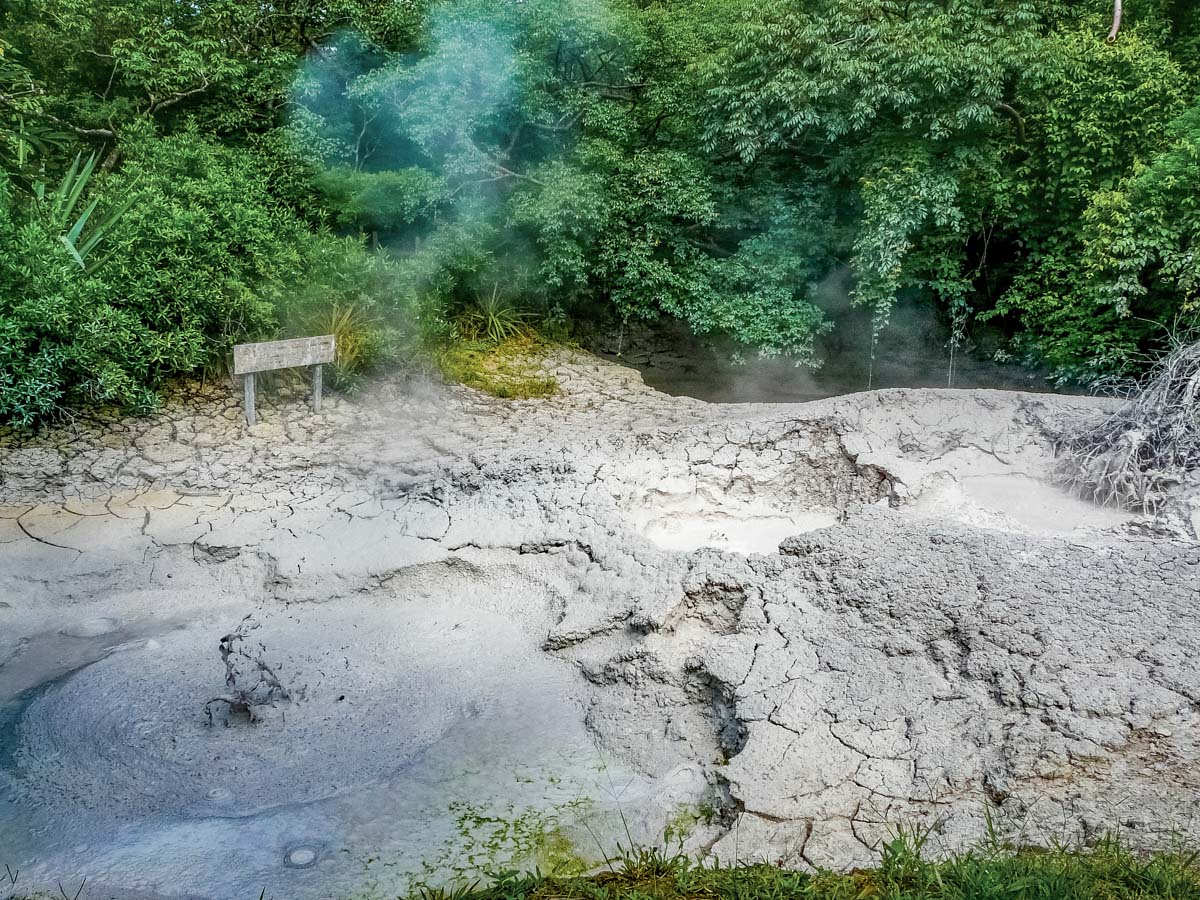
The Rincon de la Vieja Volcano is 1,916 meters (6,286 feet) tall and is one of the most-visited volcanoes in Costa Rica. It is located within the Rincon de la Vieja National Park , an hour’s drive from the city of Liberia in the province of Guanacaste . This national park is interestingly also home to another volcano, the dormant Santa Maria Volcano. The Rincon de la Vieja Volcano is indeed active, and the last large eruption here was in 1998. In fact, 1-2 small volcanic events occur here daily!
The Rincon de la Vieja National Park is a whopping 35,000 acres in size and is also home to the Rio Negro Hot Springs, waterfalls, and hiking trails. It’s undoubtedly one of the best National Parks in Costa Rica . As well as that, there’s an awesome adventure center here that offers horseback riding, ziplining, and tubing !
Directly translated from Spanish, Rincon de la Vieja means ‘the old woman’s corner’ and is named so by the native tribe who believe a witch at the top of the mountain causes it to bubble and steam (like a cauldron!)
While you can explore this volcano independently, tours are quite popular here.
There are some great hiking trails within the park; I recommend the short 20-minute trail to the Las Pailas (boiling mud pots) – a cool feature of the area where the mud is so hot it bubbles in small pools! Another good hike is the Catarata La Cangreja trail (about 3 miles/4.8 kilometers each way) which leads to a beautiful waterfall. There are also guided hiking tours, such as this tour , on offer.
As I mentioned, the closest city to the Rincon de la Vieja Volcano is Liberia (just an hour’s drive away), and booking a full-day adventure tour from the city is one of the best ways to explore the volcano. This 6 to 8 hour tour is a great option as it includes a guided hike along the Las Pailas loop trail, where you can see bubbling mud pools and spot spider monkeys and iguanas. As well as that, you will visit Oropendola waterfall and Rio Negro hot springs. Lunch in Curubande Village is also included in the price.
Rincon de la Vieja National Park is just over two hours’ drive from other popular tourist towns like Playa Flamingo and Tamarindo . This tour from both towns is highly recommended and is 8 to 10 hours in duration. This tour is less about the adventure activities on offer here and more about exploring the national park.
Rincon de la Vieja National Park is open Tuesday to Sunday (closed Mondays) and costs $17 USD for adults and $5.60 USD for kids – if you don’t have a tour booked.
6. Tenorio Volcano
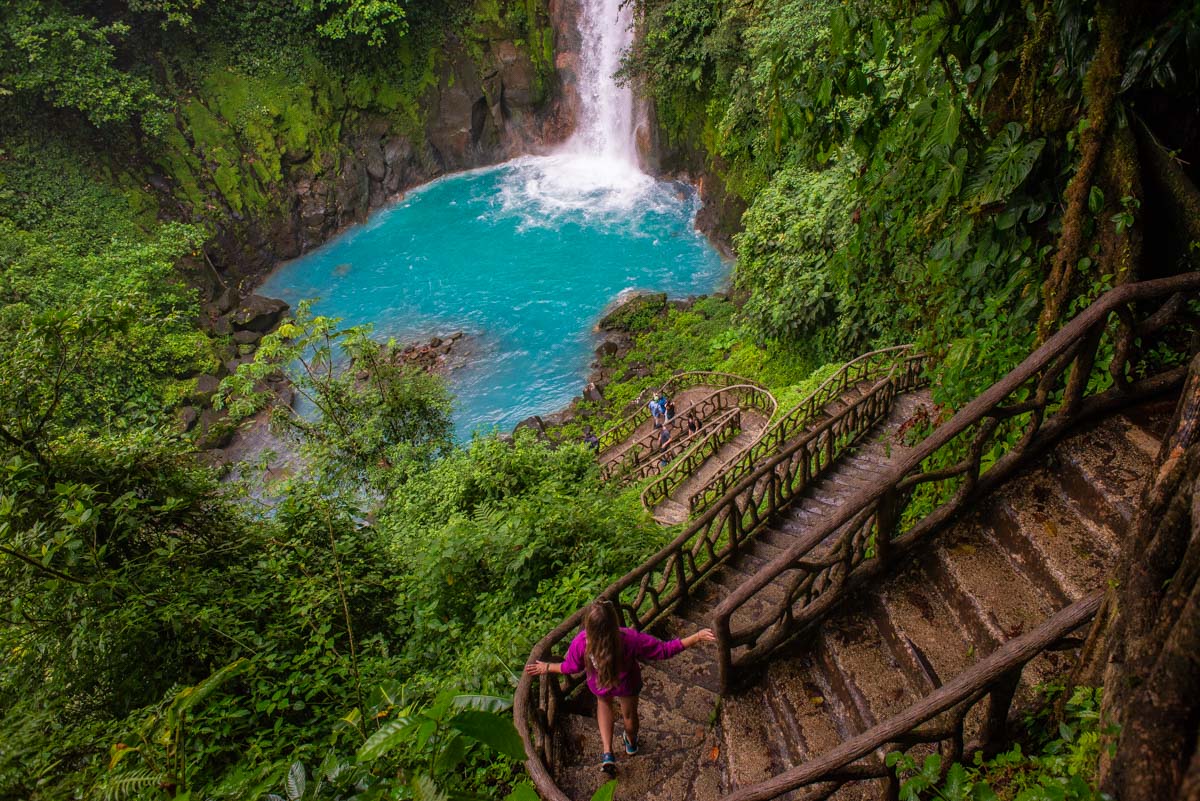
The inactive Tenorio Volcano is 1,916 meters (6,286 feet) tall and is located within the national park of the same name – the Tenorio Volcano National Park in Guanacaste Province. The national park is most well-known for being the home of the Rio Celeste waterfall – one of the best waterfalls in Costa Rica .
Visitors to the park have increased massively since 2019, and as a result, there are visitor quotas in place, meaning only a limited number of people can visit here every day. No more than 500 people are allowed in at one time, and no more than 1,000 per day. For that reason, it’s important to arrive early.
The summit of the volcano is closed to the public, but special permission can be granted to climb to the top in some circumstances. If you did go to the top, you would see a large walled crater and a lake, as well as an abundance of wildlife (most likely thanks to the lack of visitors.)
To be honest though, the reason to visit Tenorio is for Rio Celeste and not the volcano itself. In fact, the top attraction, and one of the best things to do in Costa Rica , is the highly-trafficked out and back hiking trail within the park that travels along Rio Celeste.
The trail passes by some of the most beautiful natural attractions in Costa Rica, like the aforementioned Rio Celeste Waterfall. Also to be seen along this 5.5 km (3.5 miles) trail is La Laguna Azul, a bright blue lagoon; Los Borbollones, a section of the river where you can see volcanic bubbles; and El Tenidero, the point where the two rivers that cause the blue color meet. The trail is relatively easy, besides one steep set of stairs that leads to the viewing platform of the waterfall.
Tenorio Volcano is one hour and 40 minutes from Liberia, one hour and 25 minutes from La Fortuna, and 3.5 hours from San Jose.
This 8-hour full-day trip from La Fortuna is a good option if you don’t want to make your own way to the park. It includes a guided hike where you can spy on wildlife like monkeys and birds. Lunch in the park is included in the price.
I personally visited on my own and had a fantastic time. We left La Fortuna before 7 am to get through the gates just after they opened and got to enjoy the waterfall without the crowds. I highly recommend this!
The park is open every day (including weekends and holidays) from 8 am until 4 pm. However, the last entry is at 2 pm. If you have a rental car, keep in mind that parking at any of the car parks at the entrance is $3.50 USD per car. The Tenorio Volcano National Park entrance fee for adults is $12 USD and $4 USD for children. You pay the fee on arrival with card, no cash is accepted.
There are restrooms and restaurants at the entrance to the park and fresh coconuts for when you finish the trail!
7. Turrialba Volcano

Turrialba Volcano National Park in the Cartago Province is believed to be one of the least-visited areas in Costa Rica, despite being home to one of the most active volcanoes in the country – Turrialba Volcano. Turrialba is explosively eruptive, having had two major eruptions as recently as 2016 and 2017. It’s the second tallest volcano in Costa Rica (behind Irazu) at 3,340 meters (10,958 feet)!
Increased volcanic activity in January 2022 resulted in the National System of Conservation Areas (SINAC) temporarily closing the park to the public. A reminder that although volcanoes are fun to visit, they still pose a danger to visitors.
Turrialba isn’t as developed as the other national parks on this list, and the official road into the park is only paved for the first 10 km (6.2 mi). With that said, the unpaved sections are in good condition.
A 10.5 km (6.5 mile) hiking trail (out and back) leads you to the summit, and it’s considered a moderate hike, so a reasonable level of fitness is required. It should take most people under 3 hours to complete this trail. At the top of this volcano is a world full of unique Costa Rican wildlife like giant toads, toucans, and howler monkeys within a unique cloud and rain forest. So the adventure getting here is well worth it, in my opinion. You can also spot several old lava flows on the trails here.
Turrialba Volcano is a two-hour and 15-minute drive from San Jose and only 10 km (6.2 mi) from the popular Irazu Volcano, which I mentioned earlier. The entrance to the park is $12 USD per adult and $5 USD for children. It is open from 8 am to 3:30 pm daily.
It’s important to point out that anyone wanting to hike the trail MUST be led by an accredited guide. This is why tours are very popular.
If you’ve limited time in Costa Rica, then this full-day tour which includes a visit to both Irazu and Turrialba , is ideal. This 10-12 hour tour departs from San Jose and also includes a guided coffee tour! Coffee tours in Costa Rica are a must (the coffee is world-famous!) so this is a nice add-on.
Getting Around Costa Rica
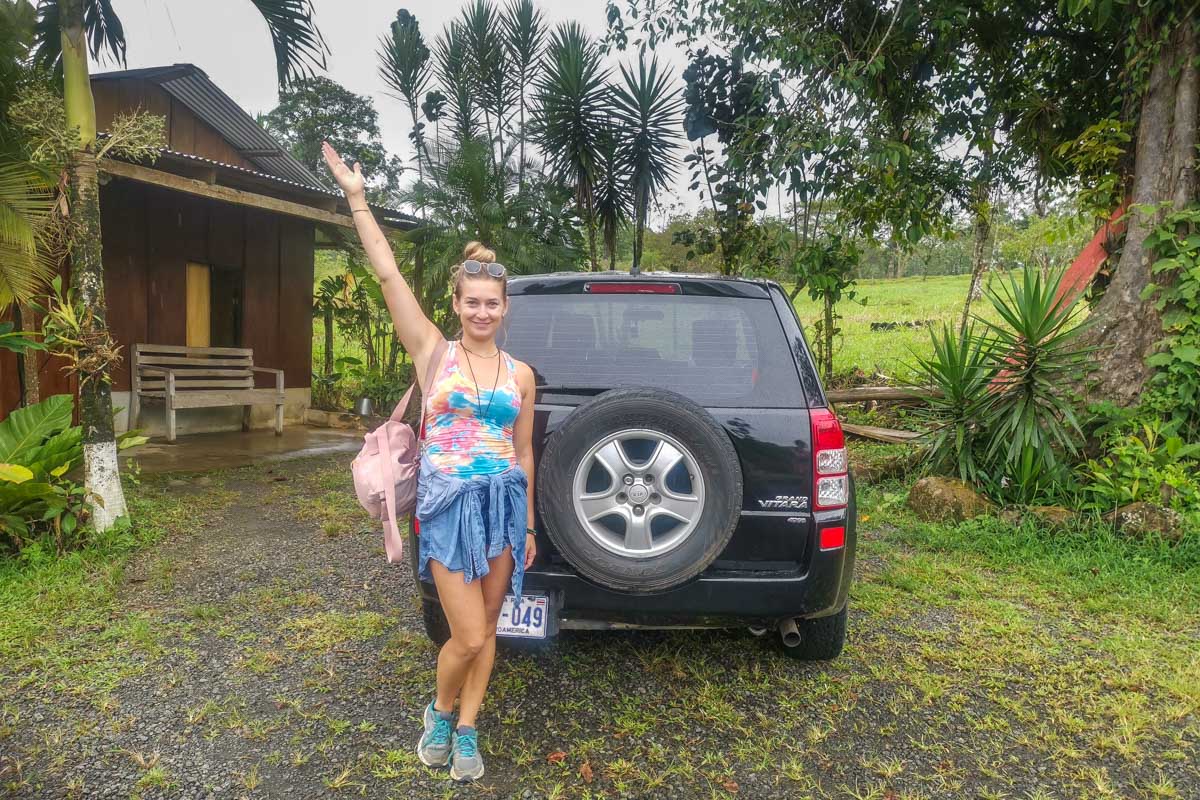
How you choose to get around Costa Rica is one of the biggest decisions you’ll make when planning your holiday here! How you do it depends on your budget, travel style, and comfort level.
Renting a Car
Without a doubt, the number one way to explore Costa Rica is in a rental car. We book rental cars on the Discover Cars website as we have had good experiences with them in the past.
One of the things you need to watch for when renting a car in Costa Rica is the mandatory insurance that the government requires you to have. There are a lot of very cheap rentals that don’t include this mandatory insurance (TPL) in the original booking price, but there are also ones that do. To avoid additional surprise charges when you pick up your rental car, be sure to rent a car that includes the mandatory insurance when you book.
Thankfully, on Discover Cars it’s easy to tell apart the companies that include the mandatory insurance and those that don’t. The trick is you can’t pick any car on their website. In the picture below, you can see this rental car, with pick up in Jaco, includes the TPL. That means the mandatory insurance is included in the price. Any cover you get above that is extra.
Of course, I still suggest getting the full coverage offered by Discover Cars, which covers you even more.
You can browse cars on Discover Cars here .

Book Shuttles
If renting a car isn’t in your budget, you don’t feel comfortable driving in Costa Rica , or you just don’t like driving, shuttles are the next best option. There are hundreds of shuttle routes available all over the country, and they are very affordable.
Shuttles in Costa Rica are specifically for tourists and often include pick up and drop off at your selected hotels and airports. The drivers also speak some English, and the vehicles have air conditioning. You’ll also be guaranteed a seat when you book a shuttle (which isn’t the case with the public bus system.)
To get the best price, use the website Bookaway . They compare all the offers and prices of shuttle companies in Costa Rica so you get the best price! Honestly, we have saved so much money using Bookaway!
You can search for shuttles online on Bookaway here.
Lastly, you can use the public bus system. On short journeys, such as from San Jose to La Fortuna or Uvita to Manuel Antonio, this system is great. However, the longer the journey the more hassle and time spent on a bus. It’s undoubtedly best to save the public bus in Costa Rica for short and straightforward trips!
The public buses are definitely the cheapest way to get around Costa Rica, but they are not always very reliable and schedules often change without notice and delays are to be expected. The buses can also be very crowded and hot – so just be prepared!
It’s also good to speak some Spanish if you plan on riding the public bus since most drivers and ticket booth operators don’t speak English.
The BEST Things to do in Costa Rica

While there are so many fun things to do in Costa Rica , a couple of specific attractions and activities stand out amongst the rest. They are:
Explore Volcanoes
There are some impressive (and beautiful!) volcanoes that you’ll want to check out while you’re here.
Poas Volcano is known for its bright blue crater lake. Poas Volcano is most commonly visited on a day trip from San Jose. This Poas Volcano tour from San Jose is one of the best you can do since it also includes a visit to the La Paz Waterfall Gardens as well as a coffee farm.
Arenal Volcano is also one of Costa Rica’s top attractions. Arenal Volcano is located closest to the town of La Fortuna. You can book this full-day tour from La Fortuna that takes you to the volcano to hike, the famous La Fortuna Waterfall and even a hanging bridge – it’s a full day of adventure!
Chase Waterfalls
La Fortuna Waterfall is one of our favorite waterfalls in all of Costa Rica. You can easily visit it on this full-day tour in La Fortuna that also visits hot springs.
Rio Celeste is another beautiful waterfall that is famous for its bright blue water. Rio Celeste is a popular attraction to visit from Guanacaste Province and this particular tour includes transport from there. Alternatively, you can book this tour from La Fortuna or this tour from San Jose .
See the wildlife
Costa Rica is the place for wildlife lovers! One of the best places to see lots of animals in their wild habitat is at Manuel Antonio National Park . With the help of a guide you will see plenty of birds, monkeys, and even sloths! This particular tour is super popular and also has amazing reviews, so you really can;t go wrong.
There are also lots of wildlife rescue centers around the country that are worth visiting. The Jaguar Rescue Center in Puerto Viejo is one of our favorites as well as Rescate Wildlife Rescue Center in San Jose where you can book this private tour.

If you’re planning a vacation to Costa Rica and just have to see a volcano, then I hope this list has helped you narrow down which ones to see. Those were 7 must-visit volcanoes in Costa Rica, but of course, there are lots more for you to explore – Costa Rica is known for its volcanoes, after all.
Thanks so much for reading. I hope you enjoyed reading our guide to the best Volcanoes in Costa Rica. If you did, then be sure to browse around and check out more of our in-depth guides, such as:
The best time to visit Costa Rica
Ultimate guide to the Nicoya Peninsula, Costa Rica
21 best beaches in Costa Rica
Click here to see more results

FOR YOU, FOR FREE: 17 years' worth of firsthand Costa Rica trip planning and travel advice compiled into hundreds of articles, plus exclusive discounts. Created by a Costa Rican and a four-time published Costa Rica guidebook author. Welcome, amigos, and as we say in Costa Rica, pura vida!
Our 2023 Moon Costa Rica guidebook (third edition)
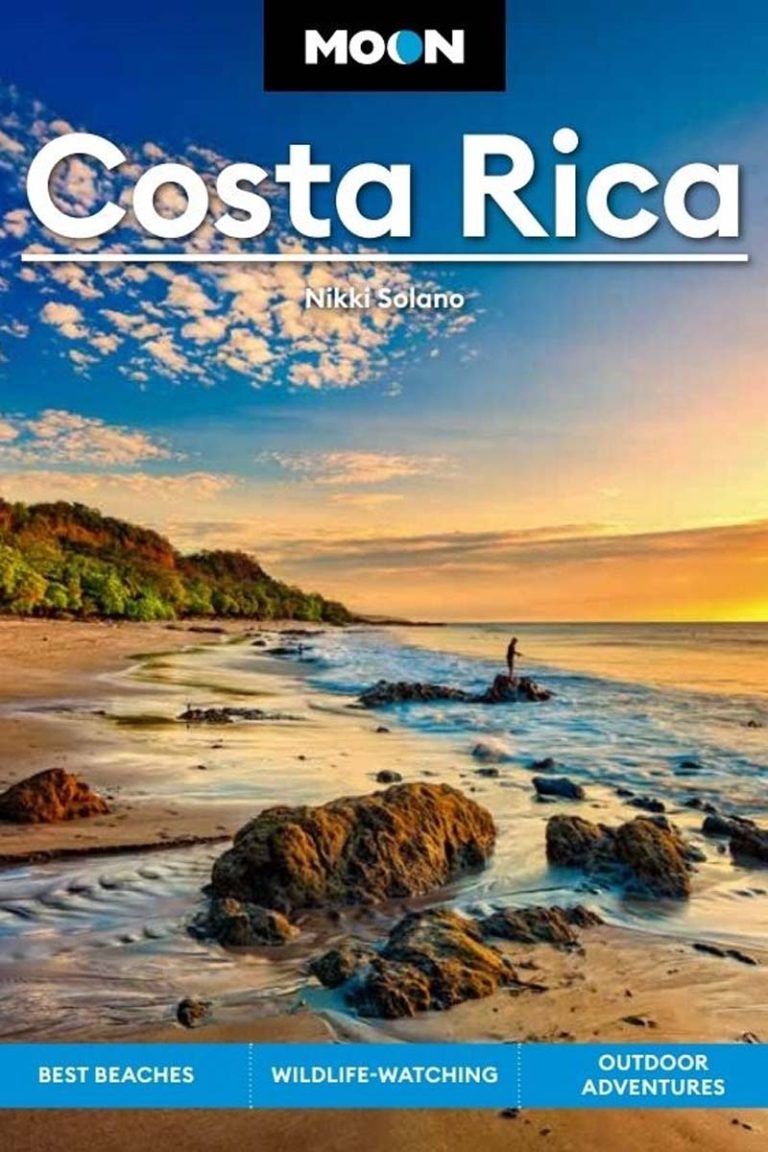
Our 2022 Moon Best of Costa Rica guidebook (first edition)
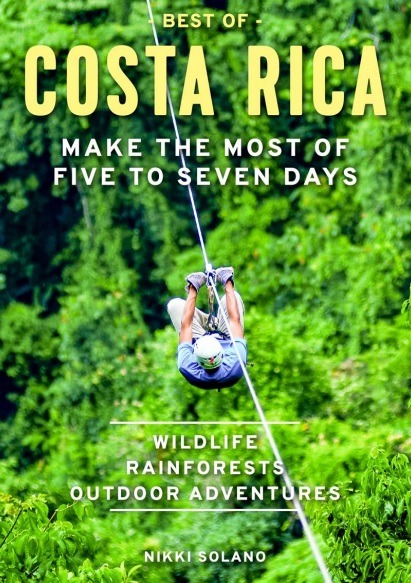
Our 2021 Moon Costa Rica guidebook (second edition)

Our 2019 Moon Costa Rica guidebook (first edition)
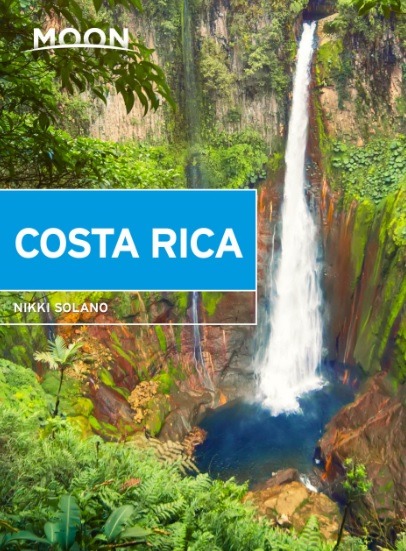
- Moon Travel Guides
- FREE DIY COSTA RICA ACCESS! Details here.
Our company is inclusive. Read our Anti-Hate, Anti-Racism, Anti-Xenophobia, Anti-Inequality, Anti-Discrimination Statement here.
NEW! Our awesome Costa Rica Destination Tool filters 66 destinations by nearly 150 criteria to help you quickly and easily decide where to go in Costa Rica according to your unique preferences, wants, and needs. Learn more and access the tool on our sister site, DIY Costa Rica, here.
How To Experience The Best Costa Rica Volcanoes: Arenal, Poas, Rincon De La Vieja, Irazu, And Turrialba
Home » What To Do In Costa Rica » Volcanoes » How To Experience The Best Costa Rica Volcanoes: Arenal, Poas, Rincon De La Vieja, Irazu, And Turrialba

Last updated on November 7th, 2023 at 02:57 pm GMT-6 (Costa Rica time)

Written by Nikki Solano
Want to know our pick for the BEST VOLCANO TO VISIT in Costa Rica? It is featured on DIY Costa Rica !
Want to save money in costa rica, our sister site, pura vida eh inc., has volcano tour discounts. con mucho gusto (you’re welcome) and pura vida.
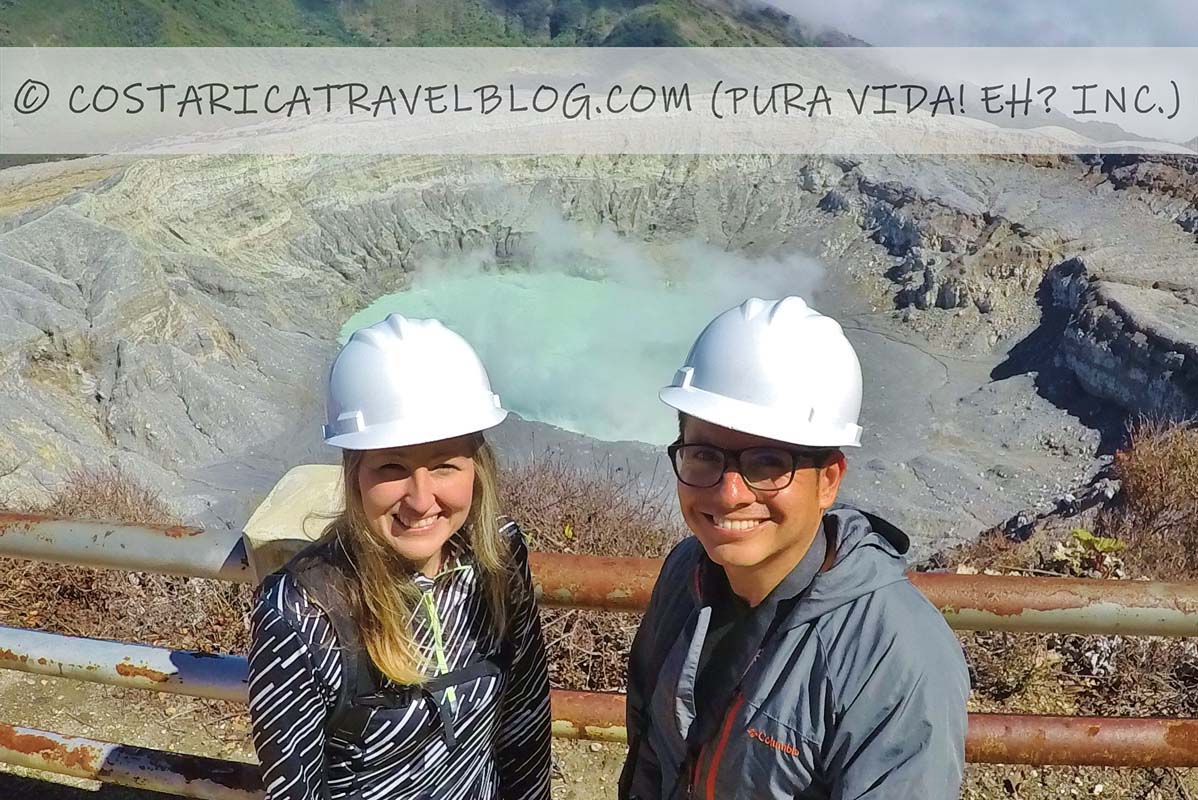
Get the Costa Rica info you need by browsing our article's TABLE OF CONTENTS:
Costa Rica’s active volcanoes: Know this first
Costa rica volcano national parks, map of volcanoes in costa rica, ways to experience the arenal volcano, what’s not permitted at the arenal volcano, a rundown of the arenal volcano national park, ways to experience the poas volcano, what’s not permitted at the poas volcano, a rundown of the poas volcano national park, what’s not permitted at the rincon de la vieja volcano, a rundown of the rincon de la vieja national park, ways to experience the irazu volcano, a rundown of the irazu volcano national park, costa rica volcanoes: the turrialba volcano, which costa rica volcano is the best to visit.
First things first: rugged Costa Rica is ridden with volcanoes. Most don’t take the iconic shape of a cone, and none spew red-hot lava, so unsurprisingly, the majority are mistaken for mountains.
Even if you don’t realize it at the time, no matter where you travel in Costa Rica, you’ll likely drive around or be within eyeshot of a volcano during your trip. This anticlimactic experience probably isn’t enough to wow you, but don’t fret; there are Costa Rica volcano experiences that will. Continue reading below to learn about these experiences, specifically, ways to discover Costa Rica’s top five volcanoes—Arenal, Poas, Rincon de la Vieja, Irazu, and Turrialba —each of which is currently active.
Each of the five Costa Rica volcanoes detailed below is located inside its eponymous national park: the Arenal Volcano National Park , the Poas Volcano National Park , the Rincon de la Vieja National Park , the Irazu Volcano National Park , and the Turrialba Volcano National Park . Each national park welcomes visitors, although the Turrialba Volcano National Park is often closed due to volcanic activity (see below for details). One of the national parks, the Poas Volcano National Park, requires visitors to have a reservation. While participation in volcano tours that take place at the various national parks is encouraged, some activities inside the parks (including hikes to the craters of the Arenal Volcano and the Rincon de la Vieja Volcano) are prohibited.
Without further ado, here’s what you should know about Costa Rica’s top five active volcanoes: the Arenal Volcano , the Poas Volcano , the Rincon De La Vieja Volcano , the Irazu Volcano , and the Turrialba Volcano .
We created the above map to showcase where each active Costa Rica volcano is located. Included on the map are the following sites (each of which we detail in this blog post):
- Arenal Volcano (marked by a mountain icon)
- Irazu Volcano (marked by a mountain icon)
- Poas Volcano (marked by a mountain icon)
- Rincon de la Vieja Volcano (marked by a mountain icon)
- Turrialba Volcano (marked by a mountain icon)
Costa Rica Volcanoes: The Arenal Volcano

For our full article about the Arenal Volcano National Park, don’t miss our related blog post: Why You Should (And Shouldn’t) Visit The Arenal Volcano National Park
The most visited and recognizable Costa Rica volcano is the Arenal Volcano. Though we were lucky enough to spend several years living at the base of this volcano back when it used to erupt on the regular (see our blog post Why You Should (And Shouldn’t) Visit The Arenal Volcano National Park for an account of what that was like), nowadays, only faint puffs of smoke escape its crater. Smack dab in the heart of Costa Rica’s epicenter of adventure (the town of La Fortuna; see our blog post Must-Know Info About La Fortuna Costa Rica From Longtime Residents for our La Fortuna city guide), the Arenal Volcano is the showstopping centerpiece atop the table of Costa Rica tourism. It’s also the best Costa Rica volcano to visit if you want to see and/or snap photos of an iconic, cone-shaped volcano. Though the most straightforward way to experience this particular Costa Rica volcano is to hike around its national park, there are actually countless ways you can experience the Arenal Volcano during time spent in touristy La Fortuna. Here are a few suggestions.
You can view the Arenal Volcano at a distance while:
- Touring hanging bridges
- Riding an aerial tram
- Soaking in hot springs
- Horseback riding
- Bird-watching
- Mountain biking
- Riding an ATV
- Kayaking or stand-up paddling on Arenal Lake
- Strolling around downtown La Fortuna
- Staying at an accommodation in the La Fortuna/Arenal area that provides volcano views
- Crossing Arenal Lake (coming to or from Monteverde)
You can hike trails around the foothills of the Arenal Volcano at:
- the Arenal Volcano National Park
- Arenal 1968
- El Silencio Mirador y Senderos
- The Arenal Observatory Lodge
You can combine a guided volcano tour (i.e., a hiking tour around the foothills of the volcano) with the following guided experiences:
- Waterfall visits
- Hot spring visits
- Zip-line tours
- Hanging bridge tours
- Horseback riding tours
- Mountain biking tours
- Safari float tours
Apart from the inclined trails that you’re welcome to hike around the volcano’s base, hikes on other trails that lead up the steep slopes of the Arenal Volcano are strictly prohibited. This means that it is not possible to arrive at and/or see the crater of the Arenal Volcano.
- Experience type provided: volcano visit, educational walking/hiking tour
- Location: west of downtown La Fortuna, on the road to the community of El Castillo
- Sectors that are open to the public: two; the Main Sector and the Arenal Peninsula Sector
- Operating hours: 8:00am to 4:00pm daily
- Visit recommended for: individuals of all ages
- Parking: free parking on-site
- Bathrooms: free bathrooms on-site
- Degree of physicality required to visit: low to moderate, depending on the trails that are hiked
- Wheelchair access/suitable for the mobility impaired: no, but there’s a volcano viewpoint that can be accessed by car (no hike required)
- On-site attractions: great bird-watching, multiple volcano viewpoints, Arenal Lake viewpoints, an observation tower, an opportunity to climb over lava rocks, an opportunity to view a giant Ceiba tree
The average Arenal Volcano experience: Since it isn’t possible to reach the crater of the Arenal Volcano, most Arenal Volcano tours stick to the volcano’s foothills where flat and hilly trails weave through forest and decades-old lava rocks roughen the landscape.
Costa Rica Volcanoes: The Poas Volcano
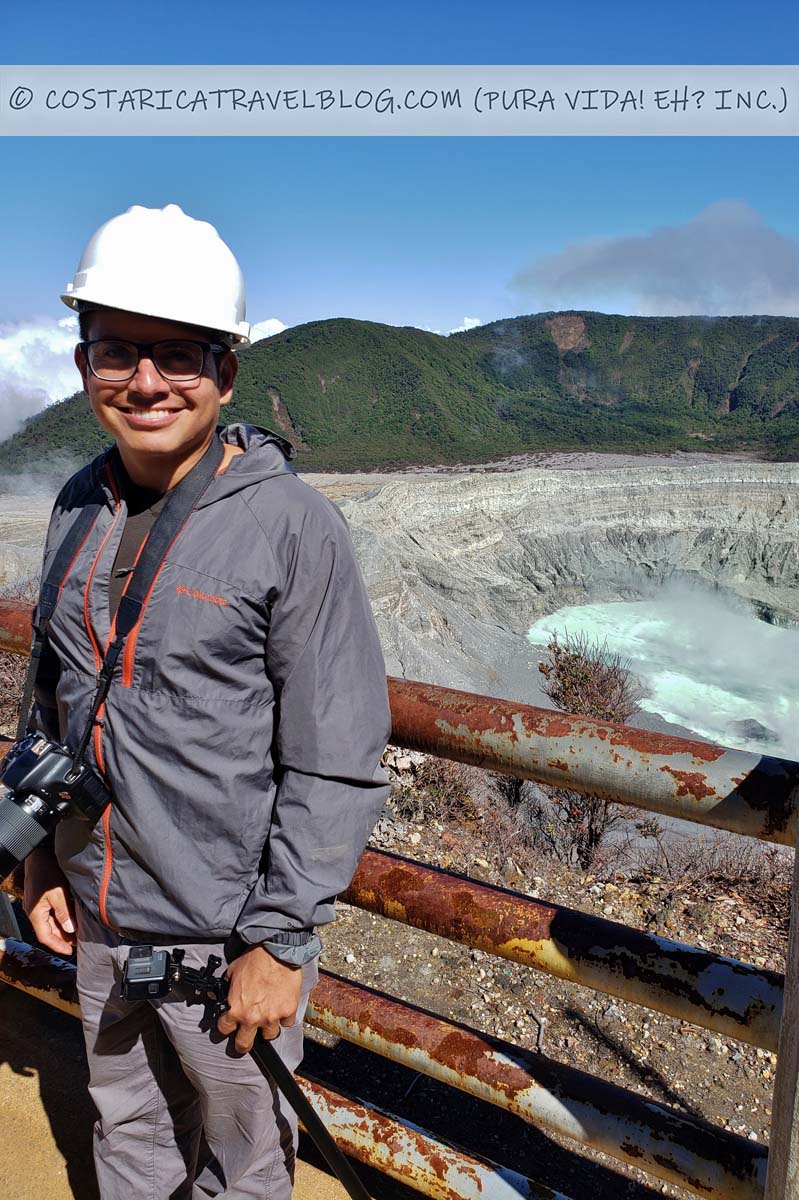
For information about planning a visit to the Poas Volcano National Park , don’t miss our related blog post: How To Reserve The Poas Volcano National Park (Screenshots)
The Poas Volcano has long been one of the most popular Costa Rica volcanoes to visit, thanks in part to its proximity to the Juan Santamaria International Airport (SJO) (a one-hour drive). What makes visits to this particular volcano tricky to coordinate, though, is the fact that reservations for the date and exact time you plan to visit are required (see our related blog post How To Reserve The Poas Volcano National Park (Screenshots) for information about the reservations process). If you aren’t opposed to following the reservation process and committing to an exact date and time for your visit, you’ll be able to experience the one and only way to currently visit the Poas Volcano, which is to walk the short, wheelchair-accessible trail that leads directly to the volcano’s active crater from just beyond the parking lot. If you do that, you’ll be rewarded with an opportunity to stand at the edge of the crater —a pretty incredible experience on clear, sunny days when the crater’s beautiful blue pool is visible.
Unfortunately, hiking trails inside the Poas Volcano National Park other than the main trail that leads to the main crater, including the forest trail to Lake Botos that we used to love to explore, are closed to the public.
- Experience type provided: volcano visit, educational walking tour
- Location: north of downtown Alajuela, near Poasito
- Sectors that are open to the public: one; the Main Sector
- Operating hours: 7:00am to 2:00pm daily
- Visit recommended for: individuals of all ages, especially young children, seniors, and others who would prefer an easy walk
- Parking: paid parking on-site
- Bathrooms: free bathrooms on-site
- Degree of physicality required to visit: low
- Wheelchair access/suitable for the mobility impaired: yes
- On-site attractions: crater viewpoint, the educational display about volcanoes inside the park office
The average Poas Volcano experience: The accessible crater atop the Poas Volcano draws in crowds of sightseers. Poas Volcano tours involve driving up the volcano’s slopes and walking the short, paved trail that connects the parking lot and the crater.
Costa Rica Volcanoes: The Rincon de la Vieja Volcano
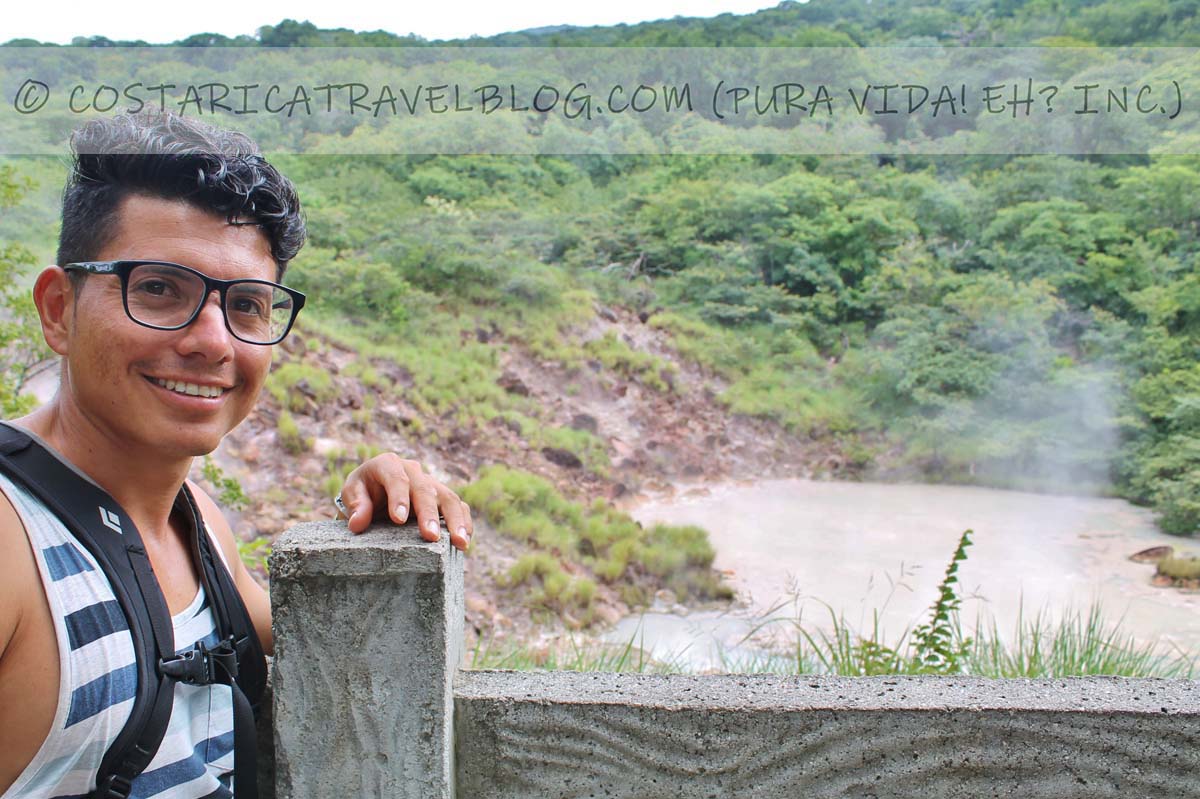
With each passing year, interest in visiting the Rincon de la Vieja Volcano increases, mirroring the growth in popularity of the adventure centers that dot the volcano’s foothills. Fortunately, this volcano still feels off the beaten path despite its path becoming more trodden, mainly because it sits at the end of a long road that cuts through a rural area, and is a 45-minute drive from the nearest city. Because tourism in the Rincon de la Vieja area is understated, this is the best Costa Rica volcano to visit if you want to couple your visit to a volcano with other adventure or nature tours but you’d rather not travel to a busy, highly sought-after destination like La Fortuna. Like visits to the Arenal Volcano near La Fortuna, though, the Rincon de la Vieja Volcano can be experienced in a few different ways. Here are some suggestions:
You can view the Rincon de la Vieja at a distance while:
- Participating in adventure or nature tours run by adventure centers like Hacienda Guachipelin and Buena Vista del Rincon
- Staying at an accommodation in the Rincon de la Vieja area that provides volcano views
- Driving Highway 1 around the city of Liberia
You can hike trails around the foothills of the Rincon de la Vieja Volcano at:
- the Rincon de la Vieja National Park
- Adventure centers like Hacienda Guachipelin and Buena Vista del Rincon
You can combine a guided tour of the Rincon de la Vieja National Park with the following guided experiences:
- River tubing tours
- Canyoning tours
The Rincon de la Vieja Volcano contains plenty of hidden treasures, including bubbling hot springs and mud pots, and smoking fumaroles . These attractions can be dangerous if you get too close, so you must stay behind the park’s guardrails and not go near the hazards. (Swimming in the hot springs is not permitted.). Also, although years ago it was permitted to hike to the top of the Rincon de la Vieja volcano, the trails that lead the way are currently closed to the public; access is strictly prohibited. This means that it is not currently possible to arrive at and/or see the crater of the Rincon de la Vieja Volcano.
- Location: northeast of Liberia, in a remote location
- Sectors that are open to the public: two; the Pailas Sector and the Santa Maria Sector
- Operating hours: 7:30am to 5:00pm Tuesday to Sunday (the Rincon de la Vieja National Park is closed on Mondays)
- Wheelchair access/suitable for the mobility impaired: only the first few meters of the principal trail in the Pailas Sector are paved
- On-site attractions: waterfalls, good wildlife-watching; an opportunity to see a mini volcano (named Volcancito), hot springs, fumaroles, and mud pots
The average Rincon de la Vieja Volcano experience: Since it isn’t possible to reach the crater of the Rincon de la Vieja Volcano, most Rincon de la Vieja Volcano tours stick to the volcano’s foothills where flat and hilly trails pass through forest and lead to fascinating attractions and a handful of waterfalls.
Costa Rica Volcanoes: The Irazu Volcano
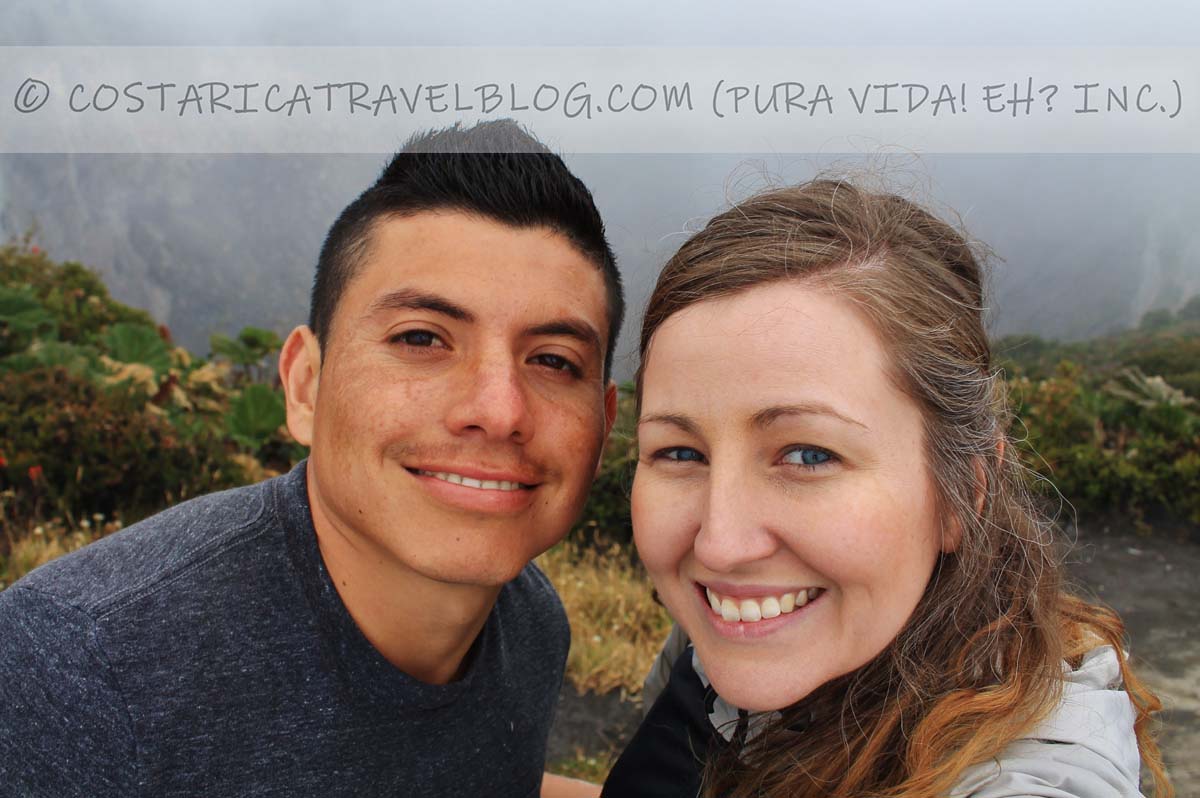
The Irazu Volcano is one of only two Costa Rica volcanoes that permit visitors to stand at the edge of a crater. (The other is the Poas Volcano.) This is the main reason to visit the Irazu Volcano— Costa Rica’s tallest volcano, which sits 11,000+ feet above sea level (more than double the height of the majestic Arenal Volcano)—to peer into its deep, daunting crater. Fortunately, unlike visits to the Poas Volcano, visits to the Irazu Volcano don’t require a reservation , making this volcano the best Costa Rica volcano to visit if you want to lay your eyes on a crater in a hassle-free way. Though there’s only one way to see the Irazu Volcano’s crater, there are actually two ways you can experience this volcano:
- You can walk the short, wheelchair-accessible trail that leads directly to the volcano’s active crater from just beyond the parking lot
- You can hike less-traveled nature trails elsewhere in the park, though you’ll need to drive to the off-site Prusia Sector for that
- Location: north of downtown Cartago, near Tierra Blanca
- Sectors that are open to the public: two; the Main Sector and the Prusia Sector
- Operating hours: 8:00am to 3:30pm daily
- Parking: free parking on-site
- On-site attractions: crater viewpoint, nature trails
The average Irazu Volcano experience: The accessible crater atop the Irazu Volcano is the attraction’s best feature. Irazu Volcano tours involve driving up the volcano’s slopes and walking the short, paved trail that connects the parking lot and the crater.

GREAT NEWS! The Turrialba Volcano National Park has reopened following its closure due to volcanic activity. To avoid providing outdated information about the Turrialba Volcano National Park from visits before it closed and reopened, we’ve removed the majority of content from this section. We will be visiting the Turrialba Volcano National Park in the coming months to conduct new research, and after we do, we’ll update this section to share our findings. Pura vida, amigos! 🙂
When deciding for yourself which Costa Rica volcano is the best to visit, consider our answers below.
- Which Costa Rica volcano is the closest to San Jose/Alajuela/the SJO Airport? The Poas Volcano, followed by the Irazu Volcano.
- Which Costa Rica volcano is the closest to the La Fortuna/Arenal area? The Arenal Volcano.
- Which Costa Rica volcano is the closest to the northern Pacific coast/Guanacaste/Liberia/LIR Airport? The Rincon de la Vieja Volcano, followed by the Arenal Volcano.
- Which Costa Rica volcano provides the best volcano-viewing experience? The Arenal Volcano, if you want to see a cone-shaped volcano, or else the Poas Volcano or the Irazu Volcano, if you want to see a volcano’s crater.
- Which Costa Rica volcanoes provide the best crater-viewing experiences? The Poas Volcano and the Irazu Volcano.
- Which Costa Rica volcano provides the best hiking experience? The Arenal Volcano, followed by the Rincon de la Vieja Volcano.
- Which Costa Rica volcano provides the most rugged, off-the-beaten-path hiking experience? The Turrialba Volcano, when open to the public.
- Which Costa Rica volcanoes are the easiest to walk/hike? The Poas Volcano and the Irazu Volcano have flat, paved trails. The Arenal Volcano and the Rincon de la Vieja Volcano have some easy forest trails in addition to moderate forest trails.
- Which Costa Rica volcanoes provide challenging treks for more experienced hikers? The Rincon de la Vieja Volcano and the Arenal Volcano.
- Which Costa Rica volcanoes are wheelchair accessible/best for the mobility-impaired? The Poas Volcano and the Irazu Volcano.
- Which Costa Rica volcano has hot springs within its national park? The Rincon de la Vieja Volcano. (Swimming in the park’s hot springs is not permitted.)
- Which Costa Rica volcanoes feed hot springs that sit off national park property but can be visited by members of the public for swimming/soaking purposes? The Arenal Volcano and the Rincon de la Vieja Volcano.
- Which Costa Rica volcanoes are most often visited in combination with visits to nearby attractions? The Arenal Volcano, followed by the Rincon de la Vieja Volcano. Truly, though, visits to any of the five volcanoes described in this article can be combined with visits to nearby attractions.
- Which Costa Rica volcano provides an opportunity to view lava? Currently, no Costa Rica volcanoes emit lava.
QUESTION TO COMMENT ON: Have you visited one of the above-mentioned Costa Rica volcanoes? Which one did you pick, and why?

Hey, Costa Rica Travel Blog reader, thank you for visiting and reading our blog! We're truly grateful for your time and preference.
Do you know that your spam-free reading experience is most important to us? Unlike some other Costa Rica blogs, we do not to sell your personal information, and we choose not to display ads, sponsored content, or affiliate marketing on our blog so we can keep your visit as distraction- and junk-free as possible. Because we prioritize your privacy, we don't earn money when you visit us, when you sign up for our e-course, or when you click on our links, which means the time and work we put into this blog—including its 300+ articles—is entirely voluntary! If you find our content valuable, and you'd like to thank us for making the trip-planning process easier and your Costa Rica vacation more enjoyable , please consider making a small donation ($1, $2, $3, or an amount of your choosing) to our blog. Doing so is a great way to pat us on the back if you feel we deserve it . 😊 Pura vida, amigos!

Click on the button above to donate through PayPal. (If you cannot see the PayPal button above, click here .) A PayPal account is not required to make a donation; credit and debit cards are also accepted. PayPal donations are confidential; we never see your payment details.

Tagged: adventure , alajuela , arenal , arenal volcano , cartago , costa rica , costa rica travel , costa rica travel tips , costa rica vacation , guanacaste , irazu volcano , la fortuna , poas volcano , rincon de la vieja , rincon de la vieja volcano , tourism , travel , travel tips , turrialba , turrialba volcano , vacation , volcano
- Author Posts
The comment section of this article has moved! If you have a question or comment about our article above or Costa Rica travel in general, please post it in our Questions and Answers Forum on DIY Costa Rica , our sister website, where you can also access our private Costa Rica recommendations, our Costa Rica Destination Tool, and our Costa Rica Recommendations Map. See you there, amigos! 🙂
Great overview. I’ve only seen Poas and Irazu so far but I enjoyed both for different reasons
Hi mybeardandmypenguin!
Thanks so much! Poas and Irazu are the only two volcanoes (of the five discussed in our article) that welcome visitors to stand at their craters. The views are incredible! It’s great that you’ve had a chance to see both.
Pura vida! 🙂
Great and thorough review! My mother and I are visiting Costa Rica in late May of this year, but we will be staying in La Fortuna. We are staying for seven days, so five full days and two half days. Do you think it’s possible to visit Arena, Poas, Irazu as well as the Paz Waterfall, Orosi Valley, and Lankester Gardens? Our biggest issue is we can’t find a tour company that will pickup from La Fortuna near the Arenal and go to these destinations.
Hi goddivaldi!
Quick question: Will you be flying into San Jose? If so, I’d recommend giving yourself a day at the start of your trip to tour the Irazu Volcano and the Orosi Valley. If you don’t mind departing from San Jose to Arenal the next day, you can combine that journey so you see the Poas Volcano and the La Paz Waterfall Gardens along the way. This means you’d spend the first day in the San Jose vicinity (touring Irazu and Orosi), spend the second day traveling from San Jose to La Fortuna (touring Poas and La Paz along the way), and then spend the next few days exploring in La Fortuna.
Hello, I was that Volcán Rincón de la Vieja is closed due the activity, so it’s imposible to hiking. Do you know something about that? And the hikking to Turrialba there is any agency that could find the information or guide the hike?
Yes! The trails that lead to the craters at the Rincon de la Vieja Volcano are currently closed. But other trails inside the Rincon de la Vieja National Park are open and worth hiking. As for the Turrialba Volcano, this volcano’s national park keeps closing and opening, closing and opening, due to volcanic activity. It is currently closed to the public.
- The forum ‘Costa Rica Travel Blog Forum’ is closed to new topics and replies.
- Kale by LyraThemes.com.
We're Nikki and Ricky, and we're human!
Sadly, ai-generated costa rica blogs and guides are taking over the internet. thank you for choosing our authentic website and resources over others, for trusting our firsthand experience, and for preferring our human-backed recommendations 😀 other ways we are unique:.
✓ We choose not to display ads, sponsored content, or affiliate marketing on our blog. Because we prioritize your privacy, we don't earn money when you visit us, when you sign up for our e-course, or when you click on our links, which means the time and work we put into this blog is entirely voluntary. ✓ Ricky is a born-and-raised Costa Rican and Nikki (married to Ricky) has explored Costa Rica since the mid-2000s . ✓ We've operated our Costa Rica-based business, Pura Vida! eh? Inc. , for 16 years (and counting!) . ✓ Our Costa Rica guidebooks are published by the prestigious Moon Travel Guides brand . ✓ We only ever write about experiences we know firsthand , and we never stuff our blog with general information about Costa Rica that is widely available elsewhere . ✓ We never copy or plagiarize other writers' content . How we wish other writers would show us the same respect! ✓ Unless stated otherwise, every photo displayed on our blog was taken by us, and with our own two hands. (Unlike some other bloggers, who rely on drones to travel and conduct research for them, we actually visit and explore the places we write about .)👍🏽 ✓ We're active in promoting Costa Rica around the world . We've written about Costa Rica for Wanderlust Magazine (UK), presented Costa Rica on Rick Steves' Monday Night Travel Show and podcast/radio show (US), and served as a Costa Rica Destination Editor for Essentialist (Spain). ✓ Our work is backed by hundreds of positive reviews and testimonials ( read some here ) ✓ We are not overly active on social media . Instead of fixating on our own popularity, we spend the majority of our time exploring and researching Costa Rica, updating our various Costa Rica resources, and working with travelers one-on-one. We're focused on the quality of your travel experience , not the quantity of our followers. ❤️
We hope you enjoy your visit to our junk-free blog as much as your time in Costa Rica. 😊

- Privacy Policy Overview
- Remember my preference
This website uses cookies to operate and provide you with the best user experience possible. To ensure you're aware of and okay with this and our other privacy-related practices, please review our Privacy Policy, then click the button below to accept it.
If you do not accept the policy, we respect your choice 100%. Unfortunately, several of our website’s features, including our Questions and Answers Forum, rely on cookies to operate. Most are also run by themes, plugins, and other add-ons to our website that we do not and cannot control, which means the cookies you receive are mainly provided by third parties. Because simple actions like reading our articles, asking a question, and even visiting our website’s homepage require the use of cookies, it is not possible to explore or use our website without them. If you would prefer not to receive cookies, we kindly (and sadly) ask that you do not visit our website. (Alternatively, you can try setting your browser to remove or reject browser cookies before visiting our website, but you may find that our website doesn’t function properly without them.) By visiting or submitting information through our website, you acknowledge and accept our use of cookies, and the use of third-party cookies. For more information, please see our Privacy Policy.
Thank you for understanding!
In order for our site to remember that you accept our policy, please enable the Strictly Necessary Cookie.
If you leave the Strictly Necessary Cookie disabled, we will not be able to save your preference. This means that every time you visit this website you will need to accept the policy again.
James Kaiser
Best Volcanoes to Visit in Costa Rica
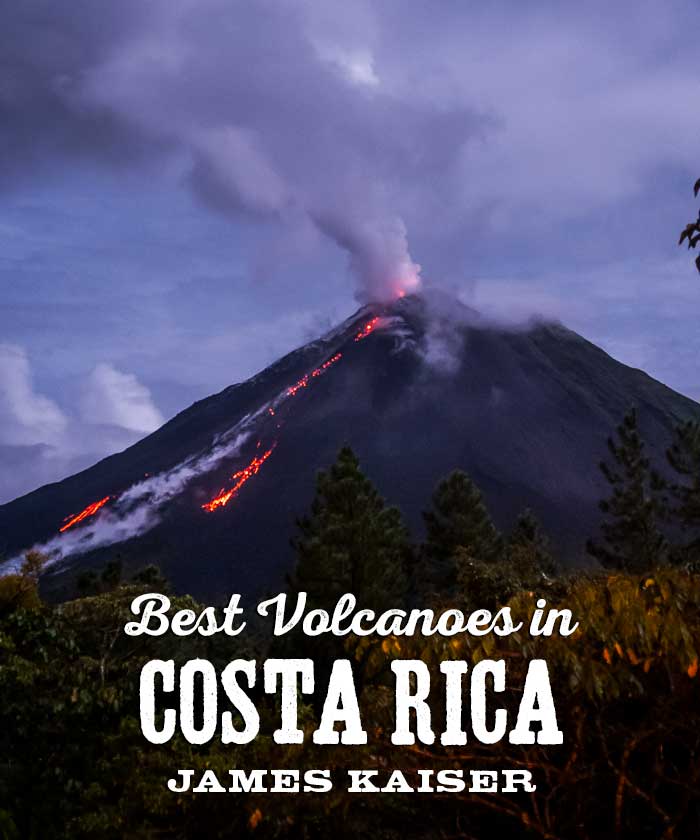
Home / Costa Rica / Volcanoes
The best volcanoes to visit in Costa Rica are:
4. Rincon de la Vieja
5. turrialba, costa rica volcanoes.
Arenal is the most famous volcano in Costa Rica. But after decades of steady eruptions, it suddenly went quiet in 2010. Arenal Volcano is now considered dormant.
At Poás and Irazú you can drive to the rim of the volcano and peer into the crater. For many people, staring into the heart of a volcano is a highlight of visiting Costa Rica .
For decades you could also visit the crater of Turrialba Volcano, but access is currently limited due to increased volcanic activity. Some volcanologists think Turrialba could be the new Arenal.
Before I tell you more about Costa Rica’s best volcanoes, let’s talk about why they formed in the first place.
Why does Costa Rica have so many volcanoes?
Costa Rica is home to over 200 volcanic features. Why is there so much volcanic activity? Because Costa Rica is part of the Central American Volcanic Arc, a 1,500-km (932-mile) chain of volcanoes that stretches from Guatemala to Panama. The arc has the greatest density of volcanoes in the world — roughly one volcano every 35 kilometers (22 miles). It is the most volcanically active region in the Western Hemisphere.
The Central American Volcanic arc formed due to plate tectonics. Specifically, the Cocos Plate, which underlies the Pacific Ocean west of Central America, is slowly slipping under the Caribbean Plate, which underlies Central America and much of the Caribbean.
This process, called subduction, is responsible for the region’s frequent earthquakes and regular volcanic activity. As the edge of the Cocos Plate pushes deep underground it melts, sending giant plumes of magma rising under Central America. When these magma plumes break the surface, they form volcanoes.
Of Costa Rica’s four mountain ranges, two — the Central Mountain Range and the Guanacaste Mountain Range — are volcanic in origin.
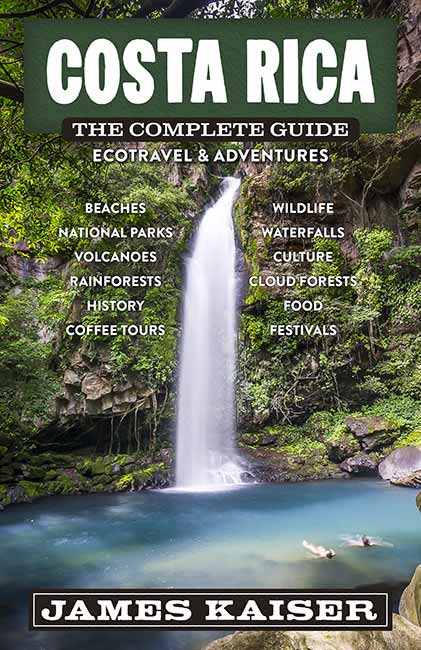
Discover the best of Costa Rica
The #1 Costa Rica guidebook.
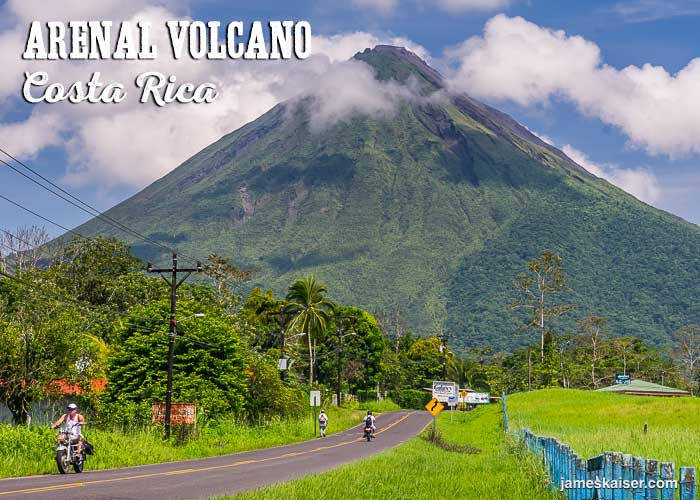
1. Arenal Volcano
Arenal is the most famous volcano in Costa Rica. That’s because, between 1968 and 2010, it ejected a steady stream of lava and hot rocks. This delighted visitors, who watched the glowing eruptions safely from afar, then relaxed in natural hot springs nearby. Between the nightly fireworks and the soothing hot springs, tourism boomed. By the mid-2000s dozens of hotels surrounded Arenal Volcano. Then, in 2010, the eruptions suddenly stopped. Arenal went dormant, and it has remained dormant ever since.
Is the party over? Not necessarily. Arenal could rumble back to life at any moment. In the meantime, however, it remains a terrific destination. The massive volcano, which towers above the nearby town of La Fortuna, remains a breathtaking sight. And the area around Arenal is filled with outdoor adventures. There are waterfalls, swimming holes, hiking trails, whitewater rafting trips, zip lines — and don’t forget those terrific hot springs. You can also visit Arenal Volcano National Park, which protects the blackened remains of historic lava flows.
Learn more about visiting Arenal Volcano .
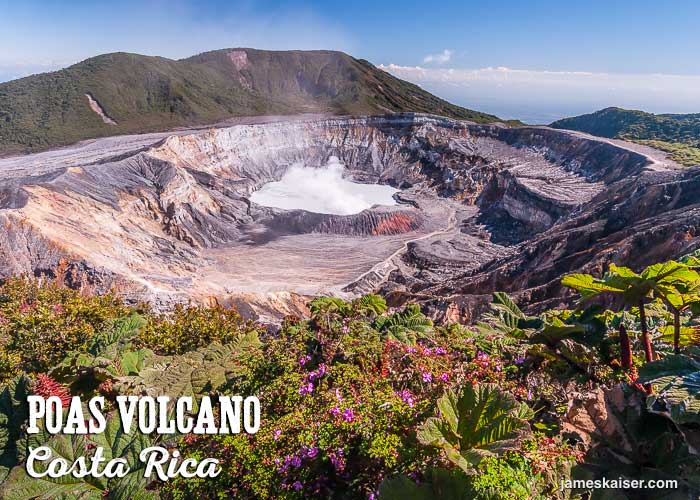
2. Poás Volcano
This dramatic volcano towers above Costa Rica’s densely populated Central Valley. Both its massive, lake-filled crater and the surrounding cloud forest are protected as Poás Volcano National Park. Due to its proximity to San José — just 45 km (28 miles) from downtown — Poás is the most visited national park in Costa Rica. Over 300,000 people visit each year. If you’re looking to escape the gritty, urban sprawl of the Central Valley, Poás makes a great day trip.
You can drive to the top of Poás, which rises 2,708 meters (8,885 feet) above sea level and is often covered in clouds. The peak is surrounded by cloud forest, but the main attraction is the volcano’s massive crater, which measures 1,320 meters (4,331 feet) across and 300 meters (984 feet) deep. The crater’s barren lunar landscape is a stark contrast to the lush vegetation surrounding it.
It’s often claimed — falsely — that Poás is one of the largest volcanic craters in the world. Poás does, however, contain one of the world’s most acidic crater lakes. The lake rests upon a cooled column of magma roughly 500 meters (1,640 feet) deep. This, in turn, rests upon a chamber of molten and semi-molten magma. Both the depth of the lake and its color vary due to rainfall and volcanic conditions.
Learn more about visiting Poás Volcano in my guidebook Costa Rica: The Complete Guide
Poás Volcano Eruptions
Over the past two centuries, Poás Volcano has erupted several times. A small museum near the park entrance displays photos of recent rumblings. A 1910 eruption produced an ash cloud 8 kilometers (5 miles) high that deposited roughly 640,000 tons of ash over the Central Valley. The last major eruption, in 1953, produced an ash cloud 7 kilometers (4.3 miles) high. It also sculpted the current crater. Minor eruptions are far more common. On Christmas Day 2009, a minor eruption launched a mixture of ash and water 550 meters (1,800 feet) in the air.
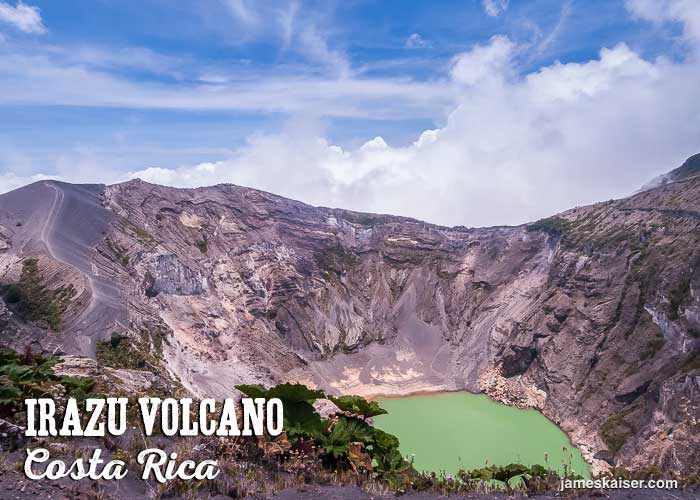
3. Irazú Volcano
Irazú is the tallest volcano in Costa Rica, towering 3,432 meters (11,260 feet) above sea level. Although the origin of the name Irazú is unknown, it is most likely derived from indigenous words that mean “earthquake” and “thunder.”
Irazú National Park lies 14 km (8.7 miles) northeast of Cartago. A paved road heads 27 km (17 miles) from downtown Cartago and climbs 2,000 meters (6,562 feet) to the rim of the volcano. From downtown Cartago, the drive takes about 45 minutes. On clear days, as you drive up Irazú Volcano, you’ll enjoy spectacular views of the valley below.
From the park entrance, a path heads to a viewpoint where you can peer into the depths of the lake-filled crater, which measures 1,050 meters (3,445 feet) across and 300 meters (984 feet) deep. On clear days it’s possible to see both the Caribbean and Pacific from the top of Irazú, but on most days thick clouds cover the volcano by 10am. Needless to say, it’s best to arrive early.
Irazú Volcano Eruptions
Over the past 300 years, Irazú has erupted over 20 times. The most recent eruption occurred on March 19, 1963. This date coincided with the arrival of U.S. President John F. Kennedy. As crowds of adoring Costa Ricans mobbed the Catholic Kennedy in San José, ash ejected by Irazú rained down over the Central Valley. In places, the ash layers were 0.5 meters (1.6 feet) thick. Some ash even drifted as far away as Tamarindo, over 200 km (124 miles) distant. Since that fateful eruption, Irazú has mellowed out considerably. Gently smoking fumaroles are the most exciting volcanic activity these days.
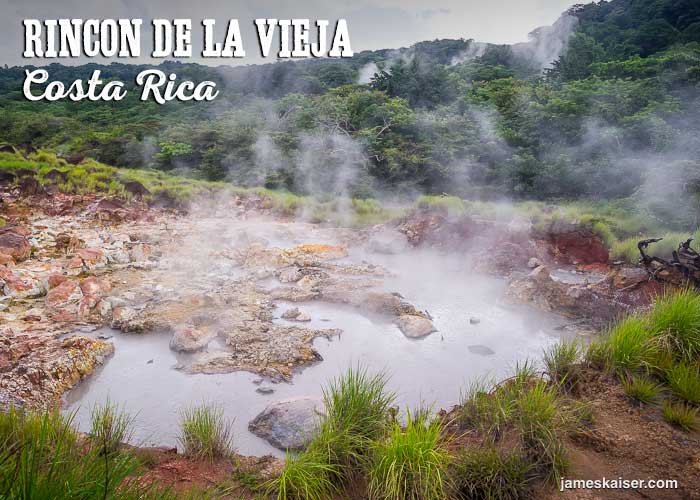
4. Rincón de la Vieja Volcano
Rincón de la Vieja Volcano rises 1,916 meters (6,286 feet) feet above sea level in dry, dusty northwest Costa Rica. Located 25 kilometers (15.5 miles) from the town of Liberia, the volcano is protected by 34,000-acre Rincón de la Vieja National Park.
The literal translation of Rincón de la Vieja is “Old Woman’s Corner.” In this case, however, it’s best translated as “Witch’s Hideout.” After spending some time in the park, you’ll understand why. A wide range of unusual volcanic features — bubbling mud pots, sulfurous hot springs, steamy pits — give the park an eerie, haunted feel. This is Costa Rica’s version of Yellowstone, providing an unusual glimpse of earth’s inner workings.
Over 40 km (25 miles) of hiking trails crisscross the southern half of the park, providing access to geological oddities, beautiful waterfalls and the crater of the park’s namesake volcano, which rises 1,916 meters (6,286 feet) above sea level. Private tour operators offer a range of outdoor adventures such as canopy tours, horseback riding, and whitewater inner tubing. However you choose to wear yourself out, you can finish the day at one of the soothing thermal pools located just outside the park.
The most challenging trail in the park heads to the lake-filled crater of Rincón de la Vieja volcano. The trail is 8 kms (5 miles) long, rises roughly 1,000 meters (3,281 feet), and takes about eight hours round-trip. As of this writing, however, the trail was closed due to volcanic activity. If the trail is open, I highly recommend going with a guide who can safely lead you to the top.
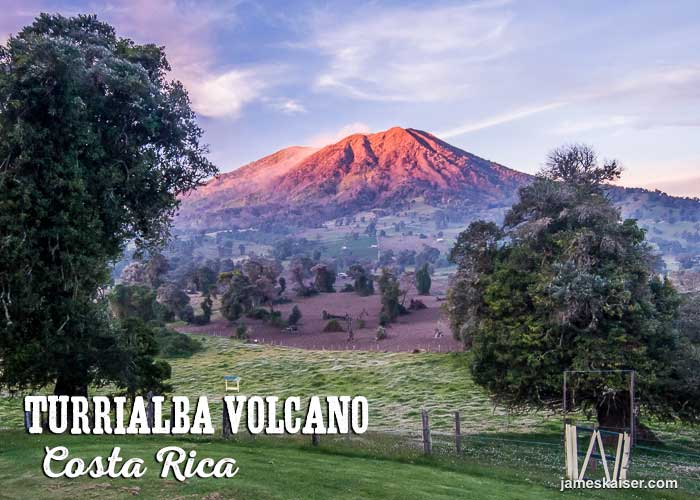
5. Turrialba Volcano
Turrialba is one of the least visited volcanoes in Costa Rica — despite its location just 10 kilometers (6.2 miles) from popular Irazú Volcano. Reached via a series of bumpy dirt roads, Turrialba rises 3,340 meters (10,958 feet) above sea level. Its slopes are surrounded by cool cloud forests and dairy farms, which produce the region’s famous Turrialba cheese. If you’re looking for a rugged, rustic mountain destination with beautiful scenery and zero crowds, Turrialba is hard to beat. From Cartago it’s a roughly 1.5-hour drive.
If you’d like to see Turrialba Volcano, the best way is to visit the Turrialba Lodge, a working cattle farm with impressive views of the volcano. This is the only hotel anywhere near the park. It offers a variety of guided tours, but bring warm clothes. Temperatures near Turrialba often drop below freezing at night.
Turrialba Volcano Eruptions
Turrialba Volcano erupted in 1864, and over the next four years it ejected massive amounts of ash over Costa Rica. Then the volcano went quiet for roughly 140 years. Not long ago, you could drive up a steep, rugged road on the side of the volcano and hike to the rim. From there you could gaze into the 50-meter (154-foot) deep crater, which is filled with smoking fumaroles.
Then, in 2009, Turrialba rumbled back to life, belching thick clouds of ash and vapor. In response the government closed Turrialba National Park, and for the most part it has remained closed since then. In September 2016 Turrialba erupted , launching rocks 4 kilometers (2.5 miles) high. Ash blanketed San José and the Central Valley, forcing Juan Santamaria International Airport to temporarily shut down.
Interestingly, Turrialba Volcano has been active over roughly the same time period that Arenal Volcano has been inactive . Are the two events correlated? Scientists don’t know. In 2017, however, volcanologist Eliecer Duarte suggested that Turrialba might be the “new Arenal.” Duarte noted that recently there has been an increase in luminous materials near the peak, and this activity poses no danger to visitors watching safely from afar.

Costa Rica Guide
Travel information and maps, volcanoes in costa rica.

Arenal, Poás (partially re-opened), Turrialba, Chato, Tenorio (re-opened!), Miravalles (re-opened!), Rincón, Von Seebach, and Santa Maria Volcanoes have all been impacted by increases or decreases in volcanic activity, weather, earthquakes and even bureaucracy.
Volcano Live Cameras
On the positive side the increase in gas venting, rock and ash ejection and even lava activity closing visitor centers, access roads and hiking trails also creates a dramatic backdrop for nearby attractions that remain open . There are also a few volcanoes where access remains unaffected ( see below ).
Volcano Closures in Costa Rica
Tenorio Volcano & Rio Celeste Re-Opened January 2018 – Tenorio National park and most notably the trail to the Celeste Waterfall were closed briefly on January 12, 2018 after a “swarm” of seismic events (several small localized earthquakes within a few hours).
During the shakeup the famous waterfall turned a muddy brown and there was online hysteria predicting the attraction was forever altered but it seemed more likely to us that it was just mud from small quake triggered upstream landslides.
The park re-opened two days later and the river and Celeste waterfall regained their eponymous coloration.
Chato – OFF LIMITS through at least 2020 – Cerro Chato has been inactive for thousands of years. The clear cold lake in the bottom of the crater and the spectacular views of Arenal a mere mile north from the rim made this the most popular volcano hike in Costa Rica. Unfortunately the trail was declared off limits in February of 2017 because guides were using it to stage climbs up the back side of Arenal.
We’ve been told that there is insufficient manpower to enforce the Lago Chato closure. Only the official guided hikes are being cancelled and many people are ignoring the ban and hiking anyway.
Miravalles – Re-Opened May 2017 – the trails from the outskirts of Bijagua to the waterfalls in Miravalles National Park were wiped out by Hurricane Otto in November 2016 but have been re-built and are open as of May 2017 – Yipee!

The visitor’s center/museum, cafe, gift shop and trails through the cloud forest and to Laguna Botos remain closed but visitors are now allowed to walk up to the crater overlook accompanied by guides .
Note – Poás closed to visitors due to high levels of activity sporadically in 2019 ( see details ) and will probably close without advance notice a few times in 2020. Turrialba – UPDATE: November 2020 – SINAC announced the re-opening of the viewpoints and overlook trail at Turrialba Volcano National Park as of December 3, 2020!!!.
UPDATE: February 2020 – SINAC announced the possibility of resuming official tours into the Turrialba national park. The outline calls for 4 groups of 35 visitors each day participating in a two hour hike accompanied by trained guides. The required infrastructure and trails are ready but local landowners are blocking access claiming the road to the park is private. The matter is being litigated and there is no estimate when tours might be able to commence.
UPDATE: October 2018 – The National Seismological Network has released dramatic video (see below) of new eruptions. Wait for it…10 seconds…
CLOSED – the most extensive and beautiful network of volcano trails in Costa Rica shut down temporarily in 2012 and completely in 2015 due to dangerous levels of activity in two of the craters. The road to the rim is also closed to the public.
Earlier in the summer a drone confirmed what residents have been reporting – a lake of lava more than 150 feet across has formed in the west crater of Turrialba volcano. Locals have noted an orange glow reflecting off of nighttime clouds for several weeks. The surfacing magma ensures that the peak and crater trails will remain closed but some are hoping to draw tourists to the surrounding area for lava viewing.
Rincón de la Vieja, Von Seebach, Santa Maria – OFF LIMITS 2014 – Starting sporadically in 2014 all three trails (north from Las Pailas, west from Santa Maria and south from Dos Rios) to all three craters were closed due to increased levels of activity in Rincón . Although the it’s been relatively quiet through 2018 the trails to the peaks are now closed permanently.
Arenal – DORMANT 2011 to 2020 – Arenal quit spewing lava in 2011 and although the beautiful cone still dominates the landscape there are currently no spectacular eruptions.
UPDATE: October 2018 – It’s dangerous and illegal to climb Arenal – most recently four tourists were hospitalized (one with a serious compound fracture of the femur) when they were injured in an ash, lava rock and boulder slide while attempting to summit Arenal. A team of rescuers took two days to evacuate the climbers.
Please do not be a moron. The zone around the crater is off-limits because of unstable slopes, poison gases and because it’s really expensive to rescue idiots who ignore the closure.
SJO Juan Santamaría International Airport – INTERMITTENT CLOSURES – Increased activity at Turrialba has shut down Costa Rica’s main airport a few times for a couple of hours to a couple of days. Poás is even closer but so far the ash fall has been carried away from the airport by prevailing winds.
NOTE: the status of trails and other amenities is subject to change without notice – use the directory of Costa Rican National Parks to contact the local offices for updates.
Where to Visit Volcanoes in Costa Rica Now
Drive up crater.
At times Costa Rica has had three drive up volcanoes. Currently Poás and Irazú are open.
Visits to Irazú tripled in 2017 after the closure of Poás and Turrialba. Although the colossus dominates the eastern skyline and appears close enough to touch from downtown San José it takes over an hour and a half to wind up the paved road past the famous cathedral and ruins in Cartago, bucolic hills, and finally elfin cloud forest before reaching Irazú’s summit.

Crater Lake Hikes
If you want to hike right up to a crater lake there are still a couple of trails open to Lago Barva (in Braulio Carrillo near San José) and Lago Danta (near Tenorio ). It was frequently warm and sunny at Lago Chato where a refreshing swim in the crater lake was de rigueur after the long hot climb.
Both Barva and Danta are at significantly higher elevations than Cerro Chato, much colder and surrounded by cloud forests rarely penetrated by the sun so swimming is not popular.
Directions and map to the Barva Volcano trail in Braulio Carillo National Park

Tenorio Volcano National Park has always been one of our favorites. Access to the top has always been limited and less than 1 in 5,000 visitors ever made the difficult climb preferring to hike to the amazing Celeste Waterfall and hot springs of the lower slopes instead.

After a quick visit to the reopened crater there are other attractions on the slopes of Poás volcano. La Paz Waterfall Gardens, and the Doka and Britt Coffee plantations are open and considered premier attractions from San José and the central valley. A slight detour (and possibly some 4WD) to the east puts visitors on the trail head to the crater of Barva Volcano in Braulio Carrillo National Park .

Rincón de la Vieja
The closure of the trails to the triple summits of Rincón, Seebach and Santa Maria will probably go unnoticed by the vast majority of visitors most of whom would never attempt the long, steep and extremely challenging climb if it were open.
The closure has not impacted the trails to the waterfalls, back country hot springs and the nature walk around the geysers and boiling mud pots which all remain open. Additionally, the slot canyon white water tubing, ziplines, spas and other attractions outside the park are still some of the most popular day trips from the Guanacaste beaches .

Although the spectacular night time displays stopped years ago, Arenal volcano still puts out enough heat to warm the hot springs and the region still attracts tourists with zip-lines, rafting and other adventure activities.
The Poás Closure History:
In April of 2017 the national park was evacuated and closed indefinitely when the cooled lava dome in the crater collapsed and sent ash and rocks into the air during a period of higher than normal activity. The volcano activity has since decreased back to typical levels and a number of visitor safety features were added in order to partially re-open Poás National Park on August 31, 2018. Please see this link for ticket purchase instructions (required) and further information.
August 28, 2018 – SINAC (Sistema Nacional de Áreas de Conservación) quietly informed tour operators that the work is complete and the national park will re-open soon. President Carlos Alvarado will preside over an inauguration ceremony for the new facilities on Wednesday August 29th and the park will reopen to the public on Friday August 31, 2018.
The parking area, restrooms and overlook are re-opening. 50 visitors at a time will be permitted a total of 20 minutes at the rim accompanied by guides trained in safety measures.
July 24, 2018 – The “last week of July” re-opening is cancelled and SINAC (Sistema Nacional de Áreas de Conservación) has not provided a new official estimate.
For the past year we’ve received several e-mails a day asking us when the park will actually re-open but we do not know. When we’re coerced into making a wild guess we have been saying “if there are no more eruptions it’s possible Poas will re-open by early December 2018 when high season starts.”
June 2, 2018 – The SINAC (Sistema Nacional de Áreas de Conservación) June 1 estimate for reopening has passed and the new official estimate for partial re-opening is the last week of July 2018 and access to the full trail system by sometime in 2019 at the earliest. Construction on the shelters began last Monday and SINAC officials met again with Instituto Costarricense de Turismo (ICT), Ministerio de Ambiente y Energía (MINAE), Comisión Nacional de Emergencia (CNE), and Comité pro Apertura del Volcán Poás (CAVP) last week to begin the process of purchasing the required real time noxious gas monitors. April 28, 2018 – SINAC (Sistema Nacional de Áreas de Conservación) representatives stated that cleanup, some shelters and trail improvements are completed (see complete list of re-opening requirements below) and that hiring of guides and training (expected to take about a month) has begun. The new official estimate for partial re-opening is June and the trails and amenities are all expected to be open by the end of 2018.
March 18, 2018 – SINAC (Sistema Nacional de Áreas de Conservación) representatives stated unequivocally that Poás will not open by Easter as rumored. The requirements and conditions announced on March 3, 2018 for the possible re-opening the National Park have not yet been implemented. The new official estimate is May or June.
- creation and implementation of an obligatory advanced reservation system that limits visitors numbers to 50 at a time restricted to 20 minutes at the volcano rim and 45 minutes total inside the park
- design and construction of “volcano shelters” to protect tourists in case of an unexpected eruption
- installation of gas sensors in all accessible areas
- repair the existing buildings and infrastructure that were damaged in the April 2017 eruption
- hire and train new staff
UPDATE January 26, 2018 The National Seismology Network has determined that the current mechanism of degasification makes it unlikely that there will be premonitory earthquakes which previously gave warning of impending eruptions.
According to Lidier Esquivel at the National Emergency Commission the lack of seismological indicators means the park could not be evacuated in time and is the reason the park remains closed. Turrialba volcano national park was closed for similar reasons six years ago and has not reopened.
December 26, 2017 – The local community petition to reopen Poás was rejected and the park remains closed until further notice.
October 23, 2017 the local communities petitioned to reopen the park because the volcano has been relatively quiet for several months. A decision is pending but I would be surprised if the petition is granted before 2018
July 4, 2017 – Recent evidence of lava ejections from the “Boca Roja” (Red Mouth) crater at Poás volcano mean the temporary closure of the national park, museum and visitor’s center will continue indefinitely. When Arenal started spewing lava access was prohibited for 50 years.
June 6 2017 – Another ash and steam eruption ensured that the park will remain closed so the best view you can get is from the OVSICORI live crater camera .

- El Salvador
- 11 Must-Visit Volcanoes In Costa Rica
Costa Rica is a small country in Central America but is home to an impressive number of volcanoes. In fact, Costa Rica has over 200 volcanic formations, seven considered active. These volcanoes not only provide breathtaking views, but they also play a crucial role in shaping the country’s landscape and ecosystem.
In this article, we will introduce you to some of the most famous volcanoes in Costa Rica and share interesting facts about each one. Whether you are planning a trip to Costa Rica or want to learn more about its fascinating geography, this article is for you.
Table of Contents

Arenal Volcano is probably the most renowned volcano in Costa Rica because of its multiple eruptions between 1968 and 2010. It is located 3 hours from San Jose and stands at 5,436 ft (1,657 m). It is illegal to climb to the top of Arenal, but many people still make the 10 to 11-hour hike. La Fortuna is the closest town to Arenal and offers plenty of vantage points of the volcano. February is the best time to visit, as clouds often cover the summit later in the day.
Exploring Arenal Volcano National Park is an adventure with many hiking trails offering different viewpoints of the volcano. A guided tour is a great way to learn about the area and includes all fees, water, transport, and a guide.

Poás Volcano is an active stratovolcano located in the central part of Costa Rica, in the province of Alajuela. It is one of the most active volcanoes in the country, and it is known for its large, active crater lake. The volcano rises to an elevation of about 8,885 ft (2,708 m) above sea level and is the second-highest volcano in Costa Rica. The volcano’s main crater contains a lake about 985 ft in diameter and about 295 ft deep. The lake is highly acidic, and it is surrounded by a rim of sulfur deposits.
Tours of the volcano are available from May to November when the weather is good, allowing visitors to view the active crater up close. The trails leading up to the summit are home to numerous exotic birds like tapirs and tanagers, making it an excellent spot for birdwatching.
Rincon de La Vieja

The Rincon de la Vieja Volcano is an impressive natural wonder in northwest Costa Rica. Rising 6,286 ft (1,916 m) above sea level, the volcano is part of the 35,000-acre Rincon de la Vieja National Park. The park offers a range of unusual volcanic features and over 25 miles of hiking trails.
Popular activities include hiking trails to Las Pailas (boiling mud pots) and Catarata La Cangreja waterfall, adventure tours from Liberia that include guided hikes, visits to Oropendola waterfall and Rio Negro hot springs, and lunch in Curubande Village. Private tour operators also offer outdoor activities such as canopy tours, horseback riding, and whitewater inner tubing with thermal pools available for relaxation.

Irazu Volcano is a popular day-trip destination from San Jose, located in the province of Cartago. It is a complex stratovolcano with five craters and has been active for more than 500 years, with the last eruption occurring in the 1960s.
Visitors can take the public bus to the main parking lot at Irazu from downtown San Jose, which takes approximately an hour and 40 minutes (without traffic). The main parking lot has toilet facilities and a small shop selling snacks, drinks, and souvenirs.
A guided tour of Irazu Volcano includes transportation, snacks, and 3 hours at the volcano. Another option is a 7-hour guided tour which includes visits to the city of Cartago and the Basilica of the Angels, as well as lunch and pick-up from San Jose.

Turrialba volcano is located in Costa Rica and has been active since 2010. In March 2015, the most significant eruption in 20 years occurred, sending an ash cloud over the Central Valley and closing the country’s largest airport for a day. Experts predict that more eruptions may occur in the near future. The volcano also erupted in 1864 and ejected massive amounts of ash over Costa Rica for four years. In 2009, the government closed Turrialba National Park due to increased activity from the volcano.
In 2017, volcanologist Eliecer Duarte suggested that Turrialba might be the “new Arenal” due to an increase in luminous materials near the peak. This could mean that more frequent eruptions are likely to occur in this area, making it a popular destination for tourists who want to witness volcanic activity up close.
It is a popular destination for hikers, offering a 10.5 km (6.5 miles) trail to its summit. Hiking the Turrialba Volcano trail requires an accredited guide, but tours are available that depart from San Jose and include a coffee tour or visits to both Irazu and Turrialba Volcanoes.

Tenorio Volcano is an inactive stratovolcano in Costa Rica’s Provincia de Guanacaste. It is surrounded by a stunning national park with rainforest, savannah, and cloud forest. Visitors can expect to see thermal springs and wild animals such as pumas, but the park limits the number of visitors allowed.
Tenorio Volcano National Park contains four volcanic peaks, two craters, and a variety of landscapes. Located within the park is a picturesque river known as the River Celeste, characterized by its baby-blue color due to sulfur dioxide emissions and calcium carbonate precipitation.

Barva is a complex volcano located 14 miles north of San José, Costa Rica. It has a lagoon which was once a volcanic crater, and three hills known as Las Tres Marías. Barva last erupted around 8,000 years ago and is now considered dormant. This makes it the quietest volcano on this list.
Located close to San José in Braulio Carrillo National Park, Barva is an ideal day trip destination for hikers who can explore its parasitic cones and multiple lagoons. Nicknamed Las Tres Marías (the Three Marys) due to its three principal summits, Barva offers stunning views from the Central Valley. The area also contains several trails suitable for all levels of fitness and experience, making it perfect for those looking to explore the natural beauty of Costa Rica.

Chato Volcano is an inactive volcano located in the La Fortuna district of Costa Rica. Standing at 3,740 ft (1,140 m) tall, it is a popular destination for hikers and adventurers alike. The hike to the top can take between 3-4 hours and should be started before 10 am to avoid hiking back in the dark.
It is possible to access two routes to the top, one near the Green Lagoon Lodge and one from Arenal Observatory Lodge. Access to the trail comes with a reasonable fee. However, it does not include access to facilities. Rainy weather should be avoided for this trail as it can make the hike more challenging.

Miravalles Volcano is an impressive andesitic stratovolcano located in Northern Costa Rica. It stands at a towering 6,653 ft (2,023 m) and is the highest mountain in Guanacaste Province. The volcano has been inactive since its last eruption in 1946, but it still holds a great deal of significance for the region. Miravalles is home to the largest geothermal field in Costa Rica and offers visitors plenty of opportunities to explore its natural beauty.

Orosí is a small, inactive volcano located in the Cordillera de Guanacaste close to the Nicaraguan border. It has an elevation of 5,443 ft (1,659 m) and last erupted 3,500 years ago. The area around Orosí is popular among ecologically minded tourists due to its wet-dry transition forest and many animals. This unique environment allows visitors to observe a variety of wildlife, such as monkeys, sloths, toucans, parrots, and more. In addition to its diverse wildlife, Orosí also offers stunning views of the surrounding landscape from its peak.
The area around Orosí is also known for its rich cultural history. Several archaeological sites in the region date back thousands of years and provide insight into the lives of ancient civilizations who once inhabited this area. Visitors can explore these sites and learn about their history while taking in the beautiful scenery surrounding them.
Ways To Explore These Volcanoes
There are several ways to explore the area around the volcano:
- Hike to the summit : Several trails lead into the parks around the volcanoes, some of which allow you to get a close-up view of the summits, and any craters, see steam vents, and other volcanic features. Keep in mind that these hikes can be strenuous and not suitable for everyone.
- Take a guided tour : Many tour companies offer guided tours of several volcanoes. These tours typically include a hike to the summit and visits to other nearby attractions, such as hot springs and waterfalls.
- Go horseback riding : Horseback riding is a popular way to explore these parks. Several stables offer guided rides through the forest and along the base of the volcanoes.
No matter how you choose to explore these volcanoes, it’s important to be prepared and take the necessary precautions. Wear sturdy shoes, bring plenty of water and snacks, and follow any safety guidelines provided by tour guides or park staff.
There are over 200 volcanic formations in Costa Rica, but not all are active. Some of the most well-known volcanoes in Costa Rica include Arenal, Irazú, and Poás. Arenal is an active stratovolcano in the province of Alajuela, while Irazú is an active stratovolcano in Cartago. Poás is an active stratovolcano located in the province of Alajuela, and it is known for its large, active crater lake.
There are 5-7 active volcanoes in Costa Rica, including Arenal, Irazú, and Poás. The Costa Rican Volcanological and Seismological Observatory monitors these volcanoes, tracks their activity, and issues alerts when there is an increased risk of eruption. It is difficult to provide an exact number of active volcanoes in Costa Rica, as the definition of “active” can vary, and some volcanoes may go through periods of dormancy.
Yes, Costa Rica is located within the “Ring of Fire,” a region of the world characterized by a high level of seismic and volcanic activity. The Ring of Fire is a horseshoe-shaped belt that encircles the Pacific Ocean and is home to many of the world’s most active volcanoes and earthquakes. It is called the “Ring of Fire” because of the region’s frequent volcanic eruptions and earthquakes. The Ring of Fire results from the movement of the earth’s tectonic plates, which often collide and cause earthquakes and volcanic eruptions.
It is possible to see active lava in Costa Rica, although it is not common. If you are interested in seeing active lava in the country, the Arenal Volcano is one of the best places to visit. It is one of the most active volcanoes, and it is known for its frequent eruptions and lava flows.
*In some cases, we may earn a commission if you purchase from companies linked to within articles. Full disclosure here .
You may also like
How to become a nicaraguan citizen: your step-by-step guide, how to become a honduran citizen: a step-by-step guide, how to become a costa rican citizen: your step-by-step guide.
Session expired
Please log in again. The login page will open in a new tab. After logging in you can close it and return to this page.

- Weather Forecast
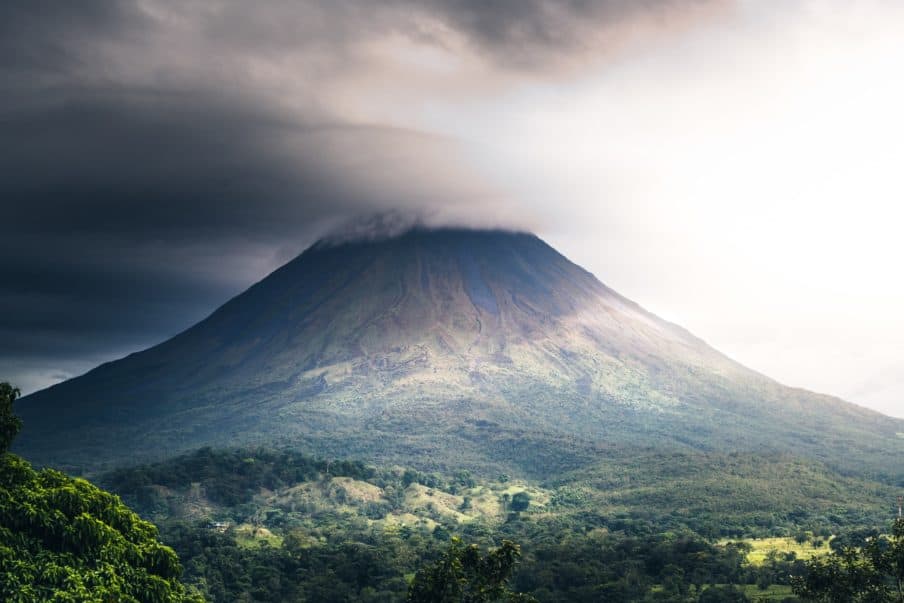
The 7 Best Must See Volcanoes in Costa Rica
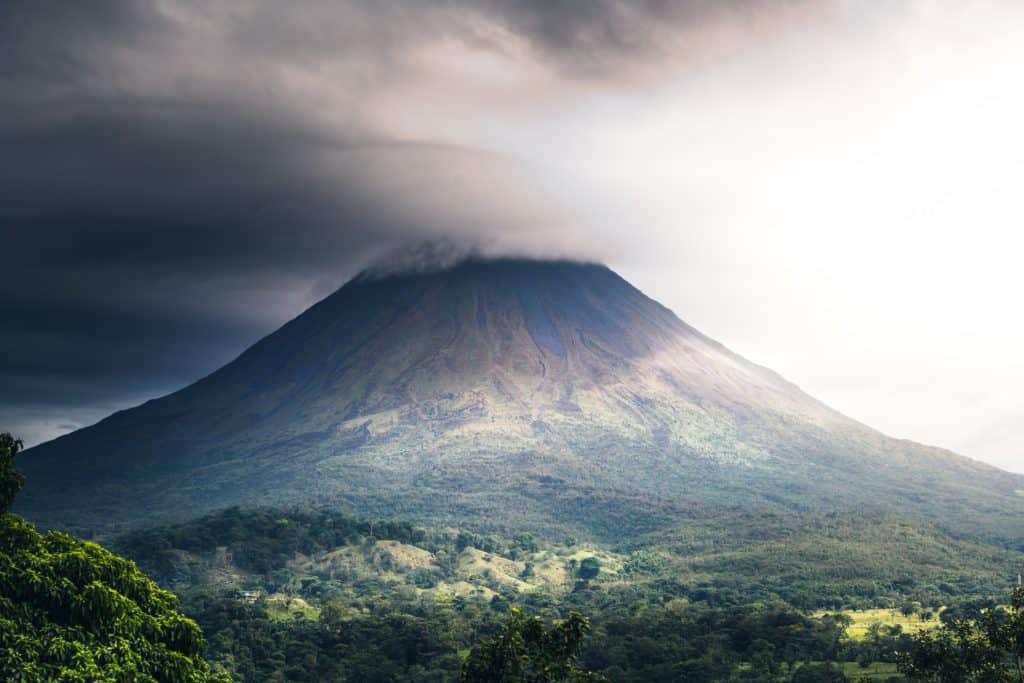
Costa Rica is home to several active volcanoes bur the seven volcanoes you must see in Costa Ricar are:
- Irazu – Volcano known for its large crater and several vents and is the highest in Costa Rica.
- Poas – Volcano known for its active crater that holds a beautiful, turquoise-colored lake and its eruptions of ash and steam.
- Rincon de la Vieja – Volcano in Guanacaste known for its fumaroles, mudpots, and hot springs.
- Barva – An inactive volcano located in the Central Valley of Costa Rica, and part of the Braulio Carrillo National Park
- Tenorio – An inactive volcano located in the Guanacaste and is part of the Rincon de la Vieja National Park.
- Turrialba – Active volcano known for its ash eruptions and occasional explosive activity
- Arenal – located in the north-central and known for its almost perfect conical shape.
These volcanoes offer many opportunities for hiking, birdwatching, and wildlife viewing. Visitors can also take guided tours to see the volcano’s activity, including night-time lava flows and ash eruptions.
Did you know that there are well over 175 identifiable volcanic formations, some of which have a measure of volcanic activity but are not considered active? You may be surprised to find that there’s a lot more about visiting a volcano in Costa Rica than you first imagined.
The excitement of seeing a volcano happens when the mist clears and you get your first glimpse of a conical shape volcano like Arenal Volcano the deep crater of the Poas Volcano. Once you see it, it will not be something you or your kids will not soon forget.
The experience of seeing a volcano may not be like the one you saw on TV or the ones you see on Facebook and Instagram. But, that’s okay! The effect will be different for both you and your kids.
Let’s go into more detail on each one of these volcanoes!
The 7 Best Volcanoes to See in Costa Rica
1. irazu volcano.
Volcan Irazu, or simply Irazu, is an active volcano located on the Cordillera mountain range in central Costa Rica, near the city of Cartago. Its name is thought to have been a combination of “ara”, or point, and “tzu”, or thunder. Others believe the name came from an indigenous village located close to the volcano, which is named Iztaru. Whatever the origins of its name were, Irazu is more popularly known by the locals for its other name, “El Coloso”, which means “The Colossus”.
It was given the nickname due to the catastrophic eruptions it was known for in the past. It was also given that name due to its immense size, with a summit 11,260 feet above sea level. This makes Irazu the tallest active volcano in Costa Rica. In fact, if you stand at the summit, it’s possible to see both the Atlantic Ocean and the Pacific Ocean on a clear day.
Irazu is known to have multiple craters on its surface, with the more popular one being Diego de la Haya, which is a crater lake known for its green waters. The lake itself is a popular tourist spot.
Irazu Volcano is an active volcano that has been known to erupt frequently in the past. In fact, since it was first recorded in history in 1723, it has erupted at least 23 times. The most recent eruption occurred on December 8, 1994.
2. Poas Volcano
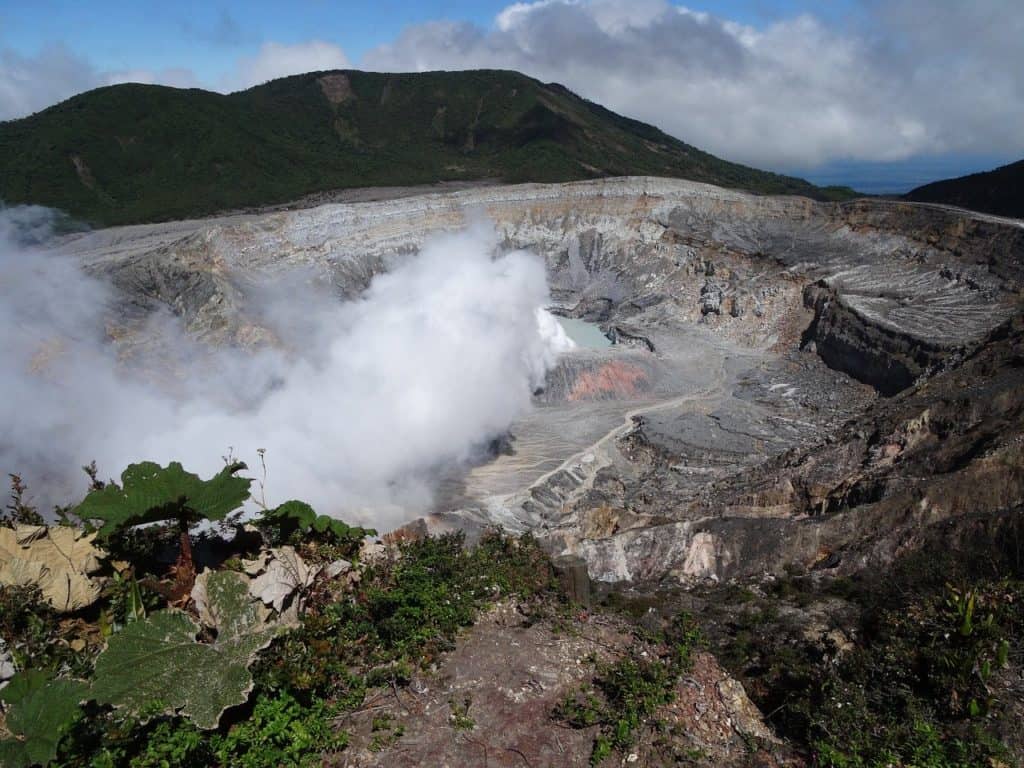
Another volcano located in Central Costa Rica and on the same mountain range as Irazu, is Poas Volcano. Much like Irazu, Poas is a very active volcano, having erupted 40 times since it was first recorded in 1828, with the most recent volcanic activity occurring in September 2019.
Poas has its own crater lakes, both of which are close to the summit. Laguna Caliente, which means Hot Lake, located on its norther side, and Lake Botos, located on its southern side. Laguna Caliente is known to be very acidic. In fact, at almost 0 pH levels, it is known to be one of the most acidic lakes in the entire world. So much so, that there is little to no aquatic life in it.
In contrast, Lake Botos, which is a crater that hasn’t erupted in more than 9,000 years, is clear and cool, capable of supporting at least 23 species of algae. In fact, visitors to the Poas Volcano National Park can pretty much walk up to it safely from the trail and take pictures.
3. Rincon De La Vieja Volcano
Rincon De La Vieja, whose name means “Old Woman’s Corner”, is located in northwestern Costa Rica, in the province of Guanacaste, near the city of Liberia. It’s an active volcano steeped in legend, with its very name being associated with a local legend involving the love affair of a princess named Curabanda and Mixcoac, her lover who was a member of an enemy tribe. Curabanda’s father eventually found out about the relationship and had Mixcoac executed by throwing him into the volcano’s crater. Heartbroken, the princess spent the rest of her days on the side of the volcano, becoming a reclusive old lady.
Legends aside, Rincon De La Vieja is also known to be a geologically active location, producing a significant amount of geothermal energy. Potentially, the volcano is capable of producing 140 megawatts of power for Costa Rica. Unfortunately, since the volcano itself is located inside a national park, geothermal energy plants aren’t allowed to be built there.
This geothermal energy also takes the form of hot springs, of which the areas surrounding the volcano is dotted with. A tourism industry has pretty much grown from the national park surrounding the volcano, with many hotels, resorts, walking trails and tours located around the volcano.
4. Barva Volcano
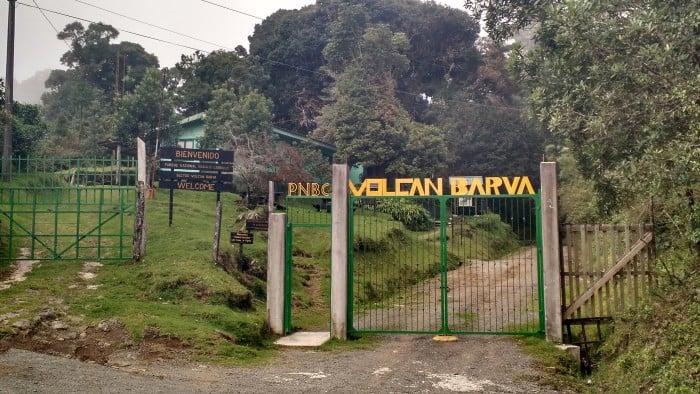
Barva Volcano is a dormant volcano located in central Costa Rica, just north of the capital, San Jose. There is currently a lake where the volcano’s crater used to be, which is called Laguna de Brava, or Brava Lake. Another distinguishing feature are the three hills on the volcano’s western side. The hills are named Las Tres Marias, or “The Three Marys”.
Barva is no longer active, with its most recent eruption being 8,000 years ago. There have been reports that the volcano had erupted in the 1760’s, as well as on 1867, but the lack of evidence means that these reports remain unverified. Since the volcano hasn’t been known to be active, a small agricultural town called Sacramento has popped up here. The town itself has recently become a popular weekend spot and staging ground for many local and international tourists looking to explore the national park at Barva Volcano’s base.
5. Tenorio Volcano
Located in northwestern Costa Rica, in the border of Alajuela and Guanacaste provinces, Tenorio Volcano is an inactive volcano, which is part of the Tenorio Volcano National Park. The volcano itself is composed of four peaks, with two craters. One of these craters is sometimes referred to as Montezuma Volcano, though many volcanologists believe it’s a part of Tenorio, and not a separate volcano.
Tenorio is about 6,200 feet tall, surrounded by lush rainforest and cloud forests closer to the summit, all of which are home to tapirs and the rare Puma. Three rivers, namely the Tenorio, the Tenorito and the Martirio, have their sources within Tenorio Volcano.
6. Turrialba Volcano
The Turrialba Volcano is an active volcano located in central Costa Rica, within the Cordillera mountain range. It is the easternmost of Costa Rica’s active volcanos, and is adjacent to Irazu Volcano, which is also a very active volcano. The volcano itself has erupted multiple times in the past, with the most recent being in April 2017. Turrialba Volcano is known for its violently explosive eruptions, with some eruptions being recorded to send volcanic material to towns 40 km away. Despite its highly active nature, however, there is a thriving montane forest along the face of the volcano, home to many species of ferns, mosses and bromeliads.
Alongside its neighbor, Irazu, Turrialba is one of the tallest volcanos of Costa Rica, towering at a whopping 10,958 feet tall. Much like Irazu, it’s also possible to see the Atlantic and the Pacific Oceans from the summit, provided it’s not cloudy.
The name Turrialba itself is shrouded in mystery, with experts not being able to agree on its origins. It could be from Torrealba, a district in Aragon, Spain, or from the Latin phrase Turris Alba, meaning white tower. Some experts even argue that the word might even have roots in the native Huetar language.
7. Arenal Volcano
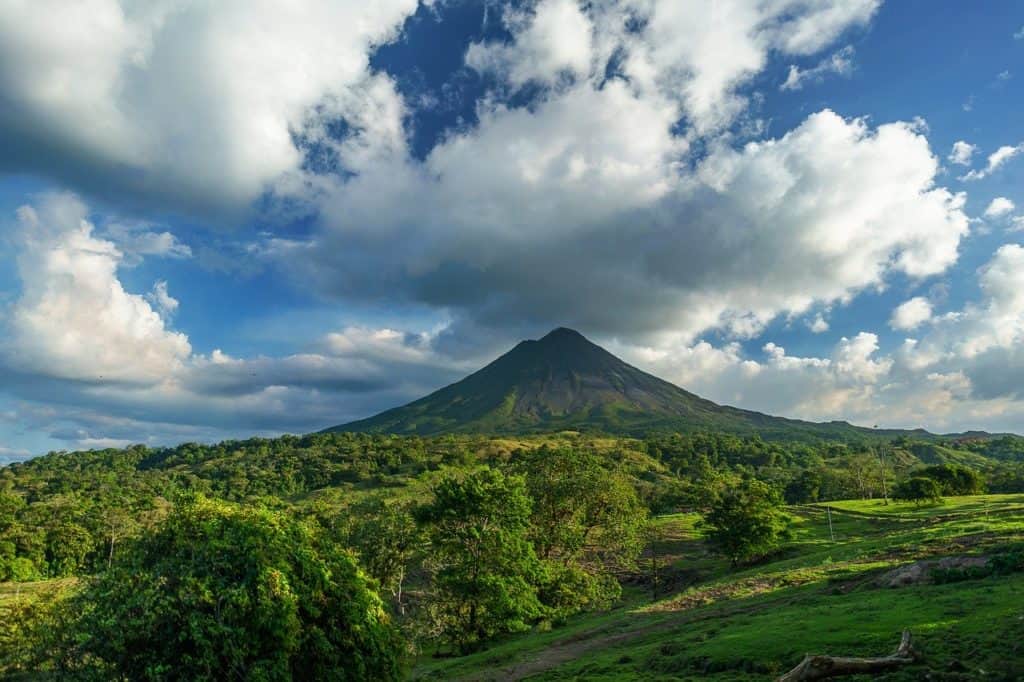
The Arenal Volcano is one of many active volcanos in the country, located in Northwest Costa Rica. It’s located about 90 km from the capital San Jose and is considered to be the youngest volcano in Costa Rica, in geological terms, being only 7,500 years old. It is Costa Rica’s most infamous volcano and is known by many names, including Canaste, Pan de Azucar, Volcan Costa Rica and Guastusos Peak. For most of its known history, it has been a dormant volcano, but an unexpected eruption in 1968 quickly changed that designation. The 1968 eruption itself destroyed the neighboring town of Tabacon.
After 1968, Arenal has become a very active volcano, erupting 8 times since then, with 5 of those eruptions occurring within a 5-year span from 1993 to 1998. It culminated into the May 7, 1998 eruption, where 23 eruptions were recorded in a 6-hour period, destroying a 2km area of forest around the volcano, and creating a large fissure at its base. After these volcanic activities, Arenal suddenly calmed down in the 2000’s, and by the 2010’s, it seemed to have entered dormancy.
Despite the dangers Arenal Volcano poses, the surrounding area is a known tourist destination, with many hot spring resorts dotting the area. The national park is also home to a diverse collection of species.
Final Thoughts
Costa Rica is a country full of natural beauty. You might know it as the destination where you can find lots of beautiful beaches and amazing wildlife.
However one natural phenomena that stands out worth visiting when in Costa Rica are the Volcanoes and seeing 1 if not all of them can be the highlight of any trip to Costa Rica.

12 of the best Costa Rica Volcano Tours 2024
Trying to find the best costa rica volcano tours i’ve compiled all the top picks for you.
Are you dreaming of exploring Costa Rica’s famous volcanoes but feeling unsure about which tour to choose? Costa Rica is home to some of the most amazing volcanoes in the world, each offering its own unique adventure.
From the active Arenal Volcano with its hot springs and lush rainforest to the stunning views from the Irazú Volcano, there’s a volcano tour for everyone.
Finding the right tour can seem a bit tricky with so many options out there. Whether you’re an adrenaline junkie looking for an exciting hike, a nature lover in search of breathtaking landscapes, or someone who just wants to learn more about these natural wonders, we’re here to help guide you.
Let’s dive into the world of Costa Rica volcano tours together and discover which one will make your trip unforgettable. Get ready to stand in awe of these giants and experience the power of nature like never before!
Table of Contents
My Top 3 Picks: best Costa Rica Volcano Tours in 2024
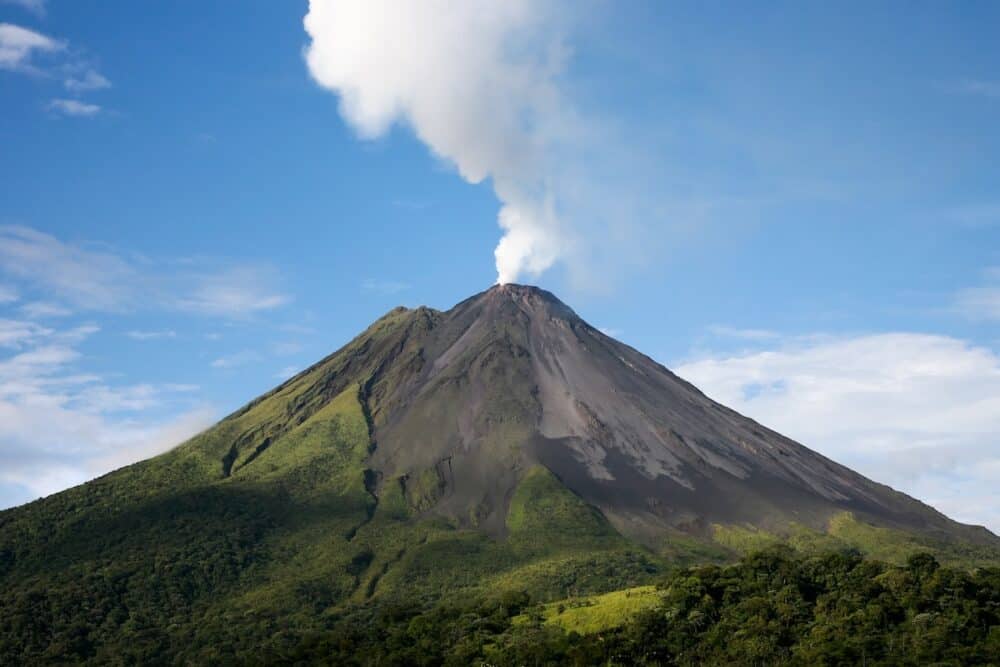
Hanging Bridges, La Fortuna Waterfall and Arenal Volcano Hike
- Lunch included
- Pick up & drop off
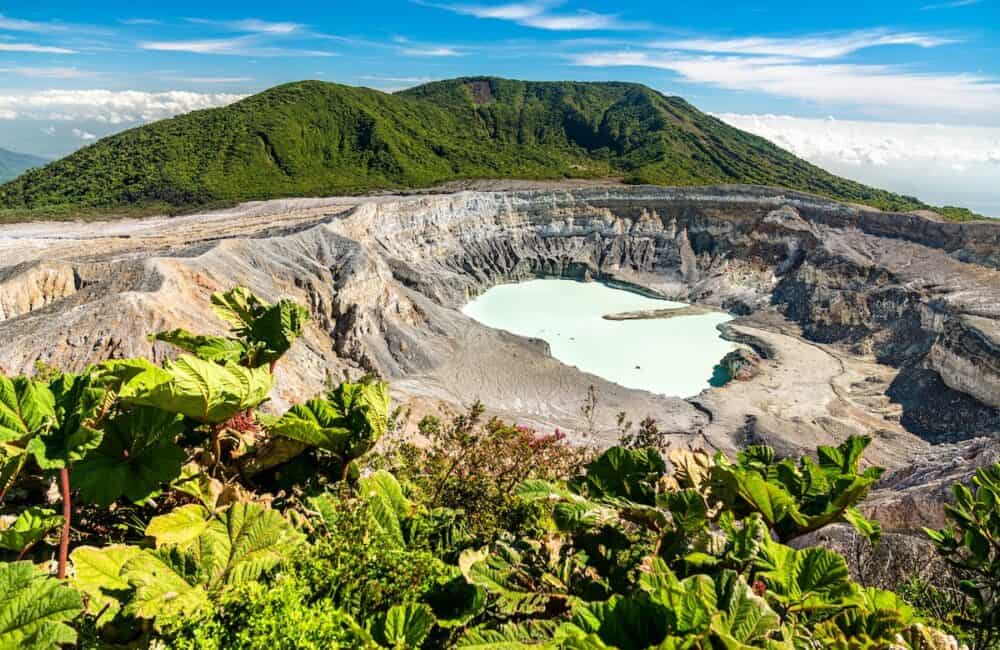
Full Day Poas Volcano
- Entrance Fees included
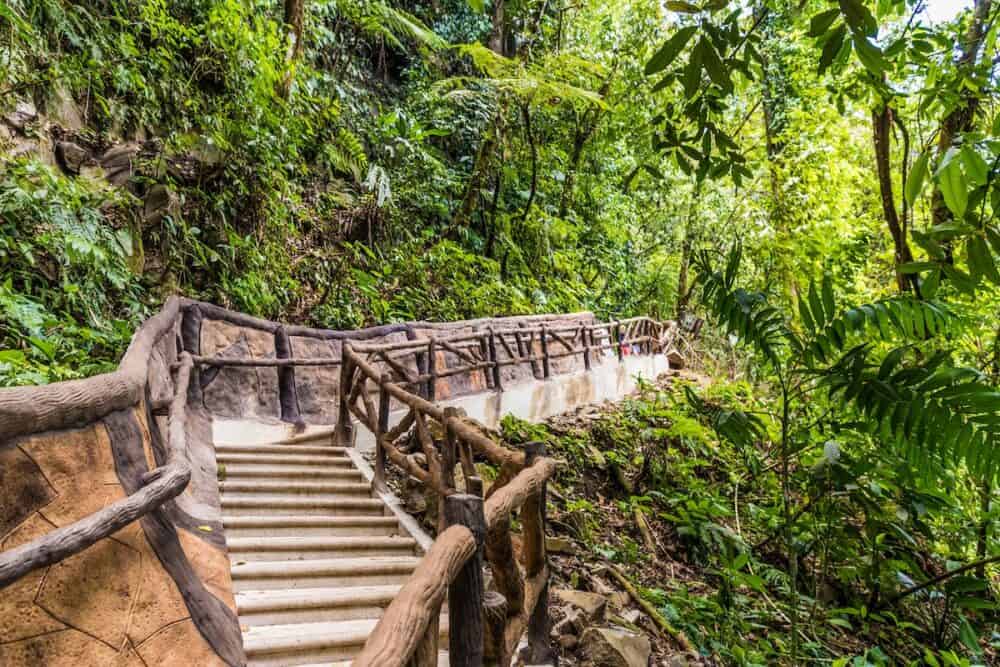
3-in-1 Arenal Combo Tour
- Lunch & snacks
- National Park fees
12 of the best Costa Rica Volcano Tours
1. hanging bridges, la fortuna waterfall and arenal volcano hike.
⭐️ RATING: 5/5 | ⏳ LENGTH: 9 hours | ✅ Book it!
Explore Costa Rica and embark on a thrilling adventure with a tour combining the three best activities into one unforgettable day. Explore the magnificent Arenal Volcano on an exciting hike, cross 16 hanging bridges, and take in the stunning natural beauty of La Fortuna Waterfall.
This full-day expedition from La Fortuna is perfect for nature enthusiasts looking for adventure-filled hikes and refreshing swims amidst Costa Rica’s breathtaking landscapes. Enjoy the convenience of hotel pickup and drop-off, making this an unforgettable experience you won’t want to miss.
“ Angelica was an amazing tour guide. She was fun, informative and pleasant. She was able to spot a lot of wild life including monkeys, colorful frogs and hogs. The experience itself was well worth the price. You got to visit the 3 main places people visit La fortuna for with admission to the parks included and a delicious lunch. I would recommend this tour to anyone who likes hiking and nature.” – Jocelyn_T
Explore the stunning beauty of Costa Rica with your tour that begins with a hotel pickup and a 30-minute drive to the 1968 Arenal Volcano Park. You’ll embark upon a 2.5-hour hike to the base of the Arenal Volcano, where you’ll witness the dry lava field from the 1968 eruption.
Next, your driver will take you to the La Fortuna Waterfall, where you’ll climb 500 steps to reach the waterfall’s base. You’ll have plenty of time to swim and enjoy the waterfall there.
You’ll then spend approximately 2.5 hours hiking through a primary rainforest and crossing the Mistico Hanging Bridges, which consist of 16 hanging bridges. The hike is in a large forest, incomparable to the Volcano Trails, so make the most of it. Remember, it’s a rainforest, so be prepared for rain and bring your gear.
Important details
- Start Time (and location): 7:00 AM at your chosen pickup point
- Duration: 9 hours
- Includes: Driver/guide, Hotel pickup and drop-off, Lunch, Bottled water
🤩 Check Prices and Availability!
2. Full Day Poas Volcano, La Paz Waterfall Gardens and Coffee Plantation Experience
Join one of the highly recommended Costa Rica Volcano tours, where you’ll journey to three extraordinary destinations exclusive to this region. Learn about Costa Rican coffee, and visit Poás Volcano, a rare gem among the nation’s five active volcanoes.
You’ll also venture into the enchanting La Paz Waterfall Gardens, home to over 100 captivating species, including rescued sloths and vibrant hummingbirds. This trip ensures you see stunning landscapes and have opportunities to connect with Costa Rica’s diverse wildlife intimately.
“ Viewing the inside of an active volcano at Poas and the wildlife at the La Paz Waterfall Gardens were memorable experiences. Our tour host was very polite and informative. Highly recommend this excursion for anyone six years or older and physically fit.” – James_B
On this tour, you’ll be able to visit 3 of the most stunning areas you can visit during your stay in Costa Rica. First, you’ll travel to the Province of Alajuela to the Coffee Land of San Isidro to learn about the history and essence of coffee production.
Next, travel to Poás Volcano, one of the five active volcanoes in the country. You’ll hike to Botos Lagoon and trail around the volcano there.
You’ll then proceed to La Paz Waterfall Gardens Natural Park, where over a hundred rescued animal species live, including sloths, jaguars, toucans, and hummingbirds. Then, you’ll have a complimentary buffet lunch with over 35 food options.
Finally, visit La Paz waterfalls, where you can take tons of photos from the various picturesque locations!
- Start Time (and location): 7:30 AM at your chosen pickup point
- Includes: Lunch, Air-conditioned vehicle, Entrance Fee to Poas Volcano and La Paz Waterfall Gardens, Guaranteed to skip the long queues, Professional guide with 30+ years experience, Hotel pick-up and drop-off and Parking Fees

3. 3-in-1 Arenal Combo Tour: Hanging Bridges, La Fortuna Waterfall & Volcano Hike
⭐️ RATING: 5/5 | ⏳ LENGTH: 9 hours and 30 minutes | ✅ Book it!
Do a lot of adventurous activities during this Arenal Costa Rica tour, where you’ll be visiting some of the most anticipated destinations in the country, all in one day. You’ll visit Arenal Volcano and Arenal Hanging Bridges, pass through Lake Arenal, and experience La Fortuna Waterfalls.
Get to witness lava fields from former eruptions and immerse in the native wildlife as you trail around Arenal Volcano National Park. You’ll also experience a traditional lunch at a serene restaurant along the river. Throughout your exciting tour, you’ll also go on treks and hikes.
“Pedro was the best tour guide ever! He was very knowledgeable of all the sites and wildlife and he really made an effort to get to know everyone and point out things that were of interest to each person individually. Our driver Robin was also a great group lead. Totally recommend this tour.” – Frances_Z
If you have limited time in Arenal and want to tour some of its best places, I recommend you join this 3-in-1 day tour. There’s only a maximum of 10 people during your time, so you’ll avoid the big group hassles.
Your first stop is at Arenal Volcano, where you’ll see the lava trails it left when it last erupted. Then, you’ll hike and cross along the hanging bridges to see and experience the rainforest from above.
The next stop will be at La Fortuna Waterfall, where you can swim, relax, and explore its gorgeous vicinity. There’s also a restaurant and observatory in the area where you can stay if you need to go hiking.
After your exhausting excursion at the waterfall, you’ll head to La Familia Rodriguez to have a traditional lunch and recover your energy. Before heading back to explore the volcano, you can engage with the locals and have the opportunity to learn about the rich Costa Rican culture.
- Duration: 9 hours and 30 minutes
- Includes: Lunch, Snacks, Driver/guide, Hotel pickup and drop-off from Arenal/La Fortuna only, National Park fees, Air-conditioned vehicle
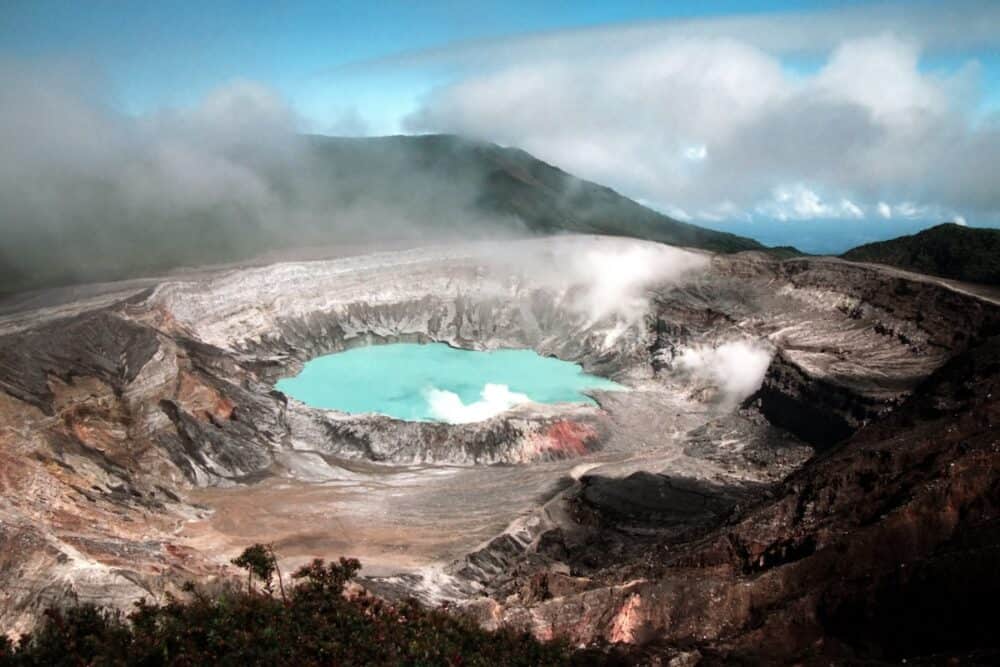
4. Volcano-Waterfall and Hot Springs Combo ( Private)
⭐️ RATING: 5/5 | ⏳ LENGTH: 8 to 10 hours | ✅ Book it!
In this private day tour in Costa Rica, you’ll have the chance to experience adventure and relaxation as you visit three iconic destinations in the country. You’ll experience the natural beauty of a tropical rainforest through a moderate hike while also enjoying the safety of observing volcanic activity from a distance.
Take a refreshing dip in a natural swimming pool at the base of the stunning Oropendola Waterfall waterfall. Also, you can unwind in the rejuvenating volcanic mineral hot springs.
Included in the tour is a buffet lunch and private transportation. You can also ask if you’d like to shop at the biggest souvenir shop in Costa Rica.
“ Highly recommend this excursion. The activities are amazing and beautiful scenery. Having the private tour gives you flexibility for example our guide took us to a souvenir shop on the way back to the resort. Better prices and selection. Gabriel did an outstanding job pointing out various animals during the hike. This has to be the best tour out there….A perfect day!” – Steve_O
Your 10-hour journey begins as you get picked up at your hotel by a private and comfortable vehicle. This tour is private, so you can embark with as little as 2 of you in the group, which is excellent for couples who want privacy.
Hike on secondary forest trails at Parque Nacional Rincón de la Vieja. You can watch birds in the area and witness volcanic steam vents and the bubbling mud around it.
Your next stop is at Oropendola Waterfall, where you can swim in its refreshing natural pool, a great activity after your exhausting hike. After relaxing at the waterfall, you’ll now head on a buffet lunch to fill up before your next activity.
Then, head on to Rio Negro Hot Springs for a stress-releasing bath a the volcanic mud and natural hot springs. You can stop by Liberia to shop for souvenirs on your way back.
- Duration: 8 to 10 hours
- Includes: Private transportation, Lunch, All Fees and Taxes
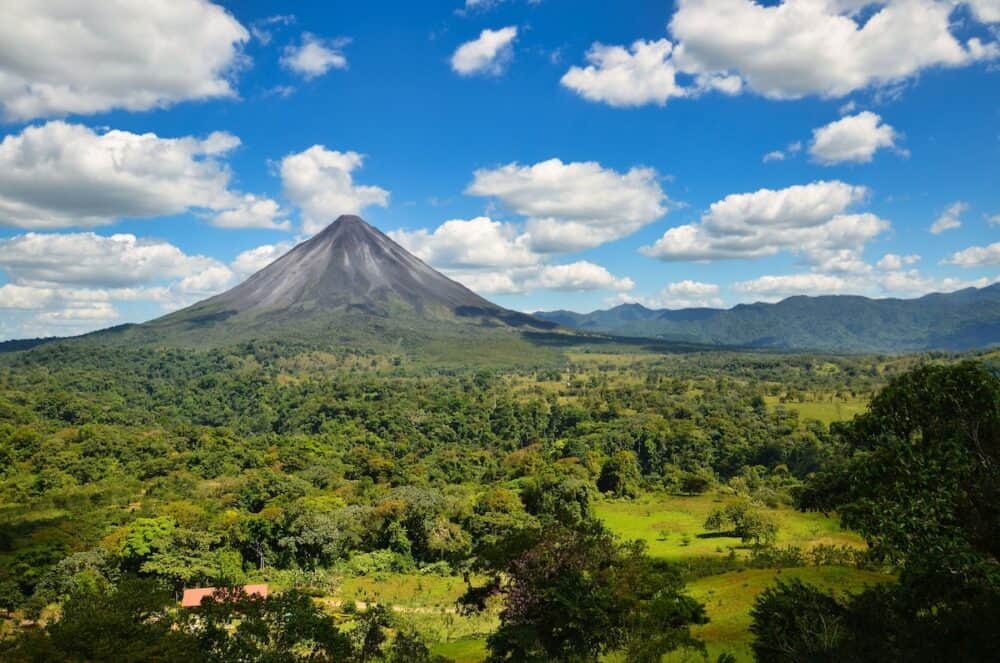
5. Arenal Volcano Full-Day Combo Tour with Lunch and Dinner
⭐️ RATING: 5/5 | ⏳ LENGTH: 14 hours | ✅ Book it!
Visit some of the best Costa Rica destinations, like Arenal Volcano, La Paz Waterfall, and Arenal Hot Springs, in this 14-hour tour. Tour the famous attractions with your professional multilingual tour guide.
View the rainforest from about as you take a zipline course. Learn about the places you’ll visit and witness the abundant wildlife in the area. With all entrance fees and two meals included, this tour offers excellent value. Perfect for a short trip, this tour is a must-do for anyone visiting Costa Rica!
“ Our Tour guide Harlem/Harlum was amazing. He was very informative and made sure we didn’t feel rushed at the stops. I would highly recommend this tour. The views are amazing ..oh and we got lucky and was able to get a clear picture of the volcano which we were told doesn’t happen often. The tour is all day and worth every penny. The food we had for lunch and dinner was amazing at both locations not to mention the fresh juice.” – Tjuanathomas70
This is one of the highly-rated Arenal Volcano tours that take you up to 6 destinations in one day. As you drive along a scenic route to Arenal, stop by La Casa del Café for a quick informative briefing about coffee in Costa Rica.
Then, proceed to La Paz Waterfall to admire and take social media-worthy pictures! Wander at the exotic bird gallery at Cinchona as you sip your Costa Rican coffee and indulge in traditional snacks.
Have a 10-minute stop at the Iguanas Center to see the marvellous reptiles before heading to Go Adventure Arenal Park, where you’ll have an authentic Costa Rican lunch. After filling up, head to the Rainforest Jungles for a 150-foot-high zip-lining adventure along 9 cables.
End the tour by sightseeing for a few hours at the serene Paradise Hot Springs and Gardens, where you can also soak in jacuzzis, waterfalls and lagoons.
- Duration: 14 hours
- Includes: Transport by air-conditioned vehicle, Hotel pickup and drop-off (most San Jose area hotels), Professional Bilingual Guide, Lunch, Dinner, Coffee or Tea with local snacks, Entrance fees
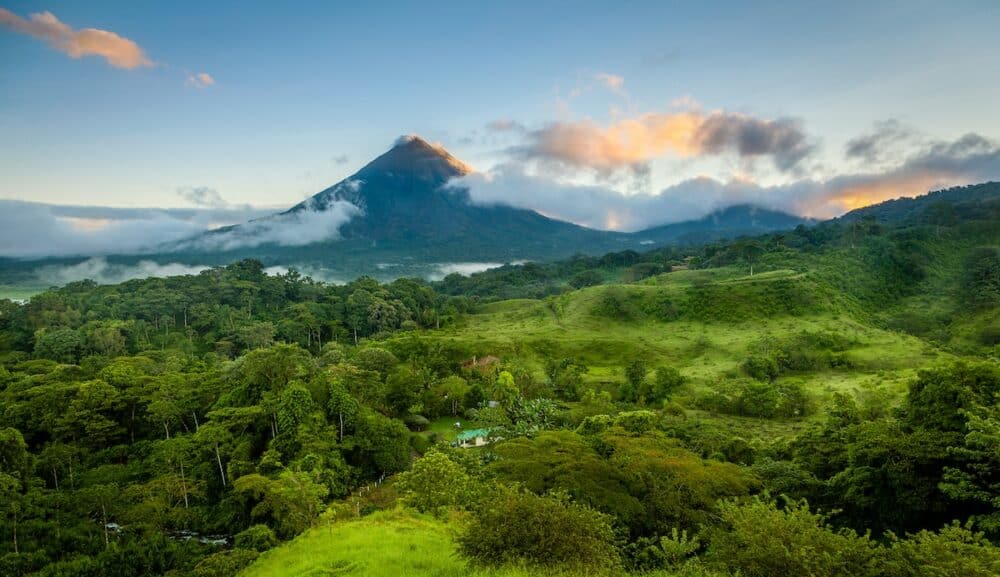
6. Full day Arenal Volcano, La Fortuna Waterfall and Hotsprings
⭐️ RATING: 5/5 | ⏳ LENGTH: 11 hours | ✅ Book it!
If you’re an outdoor enthusiast looking for Arenal Volcano tours from La Fortuna, this tour is worth trying. Embark on a journey to witness the natural splendour of the La Fortuna region.
Go on thrilling hikes through rainforests, explore the vast nature, and immerse yourself in the abundant wildlife. Go for a swim at the La Fortuna Waterfall and climb up the slopes of Arenal.
Learn insightful things as your guide does a live commentary. This group is limited to 10 people, ensuring an intimate adventure.
“ Our family of five had a great time. Cristal was so friendly, knowledgeable and enjoyable as our tour guide. I highly recommend this tour for an action packed adventure capturing the highlights of La Fortuna.” – Lorraine_B
See the lush surroundings of La Fortuna and take a refreshing dip at its base. Ascend rocky trails to the highest viewpoint around Arenal, witnessing panoramic views of the volcano, lush jungles, valleys, and lava fields.
Climb steep steps to a vast expanse of lava rocks and follow a trail to the highest viewpoint for breathtaking panoramic vistas from Mirador El Silencio.
- Duration: 11 hours
- Includes: National Park fees, Beverages, Lunch, Local guide, Hotel pickup and drop-off (In la Fortuna area), Small-group tour (10 persons per group), Alcoholic Beverages, Hotspring resort fee
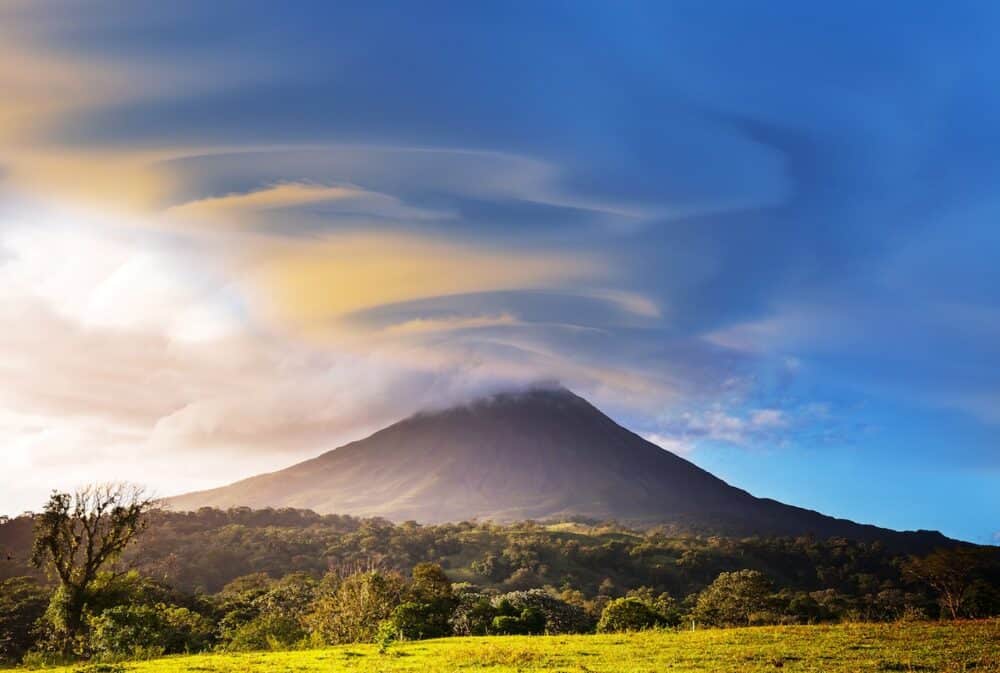
7. Arenal Volcano, La Fortuna Waterfall, Hot Springs Combo Tour with Lunch & Dinner
⭐️ RATING: 5/5 | ⏳ LENGTH: 14 to 15 hours | ✅ Book it!
This tour is perfect if you’re in Costa Rica for a limited time and want to tour some of the country’s best attractions. Explore Costa Rica’s iconic Arenal Volcano, La Fortuna Waterfall, and Paradise Hot Springs.
A bilingual guide will accompany you and provide informative commentaries along the way. This tour package also includes lunch and dinner, so you won’t have to worry about anything!
“ What an amazing day! It was very long but full of fun and adventure! The waterfall was beautiful and the water was great for swimming. The only downside was the 500 stairs each way. Totally worth the work though! The volcano hike was great. Got to get up close and explore the rain forest. It rained some on us and clouds blocked a full view of the volcano but it was still amazing. Also, the hot springs…amazing! Differing temps for anyone’s preference. The bar had great drinks as well! Both meals we had were authentic and delicious!” – Chad_C
This tour includes a convenient hotel pickup and drop-off. You’ll pass by scenic roads on your way to Arenal. Your first stop is at La Fortuna Waterfall, where you have 2 hours to relax and swim in its relaxing waters. Then, proceed to hike over the large lava flow at Mirador El Silencio to witness one of the best views of Arenal Volcano.
Another highlight of this tour is your visit to Paradise Hot Springs. There, you can unwind and release toxins from your body in the thermal mineral waters.
- Start Time (and location): 7:00 AM at your chosen pickup location
- Duration: 14 to 15 hours
- Includes: Air-conditioned vehicle, Hotel pickup and drop-off (most Jaco-Hermosa-Los Suenos area hotels), Professional bilingual guide, All Fees and Taxes, Lunch, Dinner
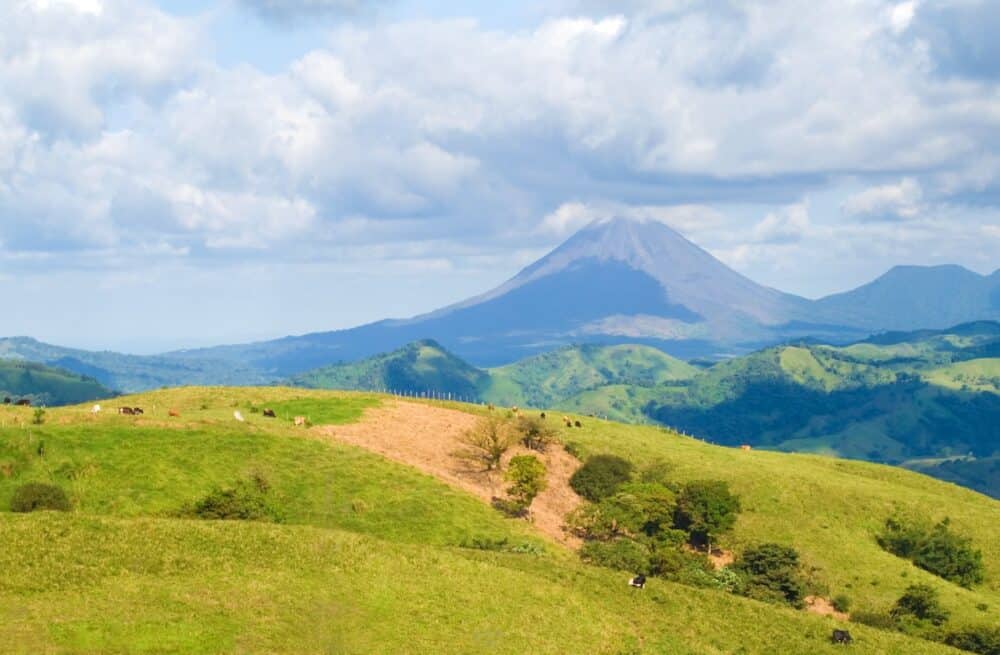
8. Arenal Volcano Experience Full-Day Tour from San Jose
Costa Rica is known for its national parks and lush natural resources. In this full-day tour, you explore the Arenal Volcano region effortlessly, departing from San Jose and taking scenic routes.
During the tour, you’ll also visit a coffee plantation and a stunning waterfall. Included in the tour is a professional guide and hotel pickup and drop-off.
“ Our tour was fantastic! Juan did an amazing job sharing interesting information and history about every part of the trip. With all of the well-times stops it didn’t feel like we were on a bus ride forever which was really nice. Juan had a very good knowledge of how and where to find wildlife so we could see sloths and iguanas. The only down side was that we were unable to see the volcano due to inclement weather but this tour is definitely worth the money no matter what. We recommend this tour and hopefully you get Juan as your tour guide and you will have a blast!” – Michael_ H
If you love nature and want to see Costa Rica’s breathtaking natural landmarks, this tour is ideal. On your way to Arenal, you’ll go through an alternate route to pass by picturesque sights.
Your first stop is at La Casa del Café for a quick informative break before heading to a rejuvenating visit at La Paz Waterfall. After that, you’ll have time at Cinchona for a snack and coffee break before heading to Centro Turístico Las Iguanas.
You will proceed to Go Adventure Arenal Park, where you can participate in a native presentation by the Maleku Tribe. Finally, spend the rest of your time at Paradise Hot Springs to unwind and refresh.
- Includes: Transport by air-conditioned vehicle, Hotel pickup and drop-off (most San Jose area hotels), Professional bilingual guide, Lunch, Dinner, Coffee or Tea with local snacks, Entrance Fees
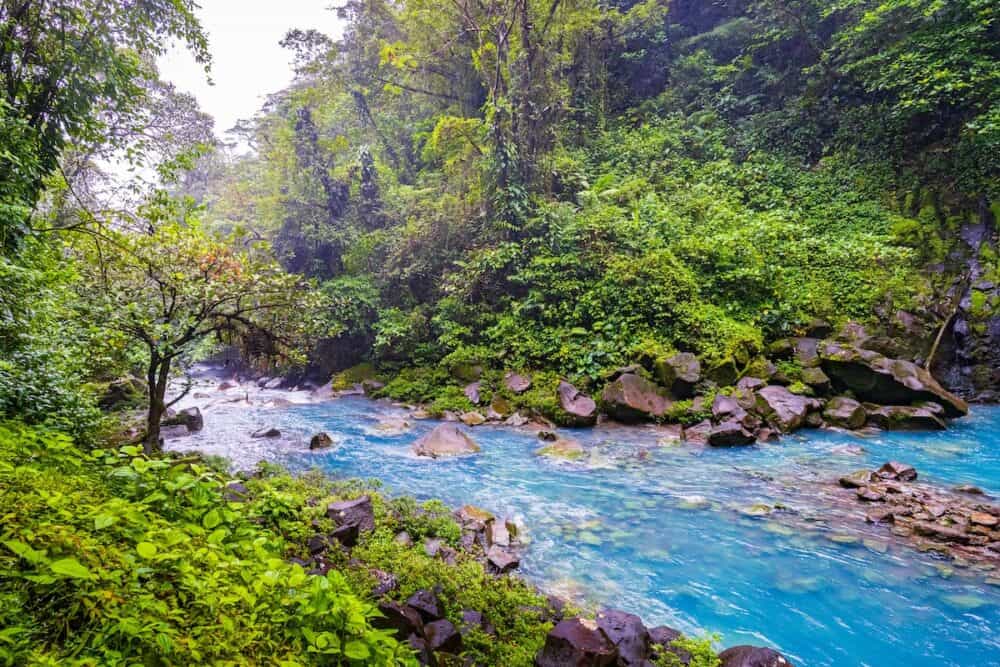
9. Volcano Hike, Waterfall Swim & Hot Springs Combo on Rincon de la Vieja
⭐️ RATING: 4.5/5 | ⏳ LENGTH: 12 hours | ✅ Book it!
Embark on an immersive adventure through the untamed volcanic landscapes of Rincon de la Vieja National Park on this full-day trekking expedition. Also, venture on a 3-hour jungle hike, where you can spot Howler monkeys, Capuchin monkeys, Toucans, and Coatis along the trail.
Experience the sights of steaming fumaroles, volcanic craters, and simmering mud pools before rejuvenating with a swim beneath the Oropendola Waterfall. Following an authentic Costa Rican, treat yourself to the ultimate relaxation with a soak in the therapeutic hot springs and volcanic mud baths at Rio Negro.
“ I had the pleasure of Ivan being my tour guide on our volcano hike, and he was amazing! Very knowledgeable and patient with our group, and well as making sure we got to see some wildlife and have a good time throughout our hike. Beautiful hike, the waterfall and hot springs were amazing too. Would definitely do it all over again!” – Rene_G
In this tour, you will explore Parque Nacional Rincón de la Vieja National Park with a bilingual naturalist guide. Start with a hike along the Las Pailas circular path that offers the best views of the Vieja volcano.
You’ll also get close to Costa Rica’s rich biodiversity with over 300 bird species and diverse animals like armadillos, bays, iguanas, coatis, monkeys, and more. Witness volcanic marvels like bubbling mud pots and fumaroles during the tour.
Then, after the hike, take a refreshing dip in the pristine blue lagoon of Oropendola Waterfall. Afterwards, indulge in relaxation at the Rio Negro Hot Springs, surrounded by tropical dry forest and naturally heated by Rincón de la Vieja Volcano.
- Start Time (and location): 6:30 AM at chosen pickup point
- Duration: 12 hours
- Includes: Bottled water, Lunch, Driver/guide, Hotel pickup and drop-off, Air-conditioned vehicle, National Park fees
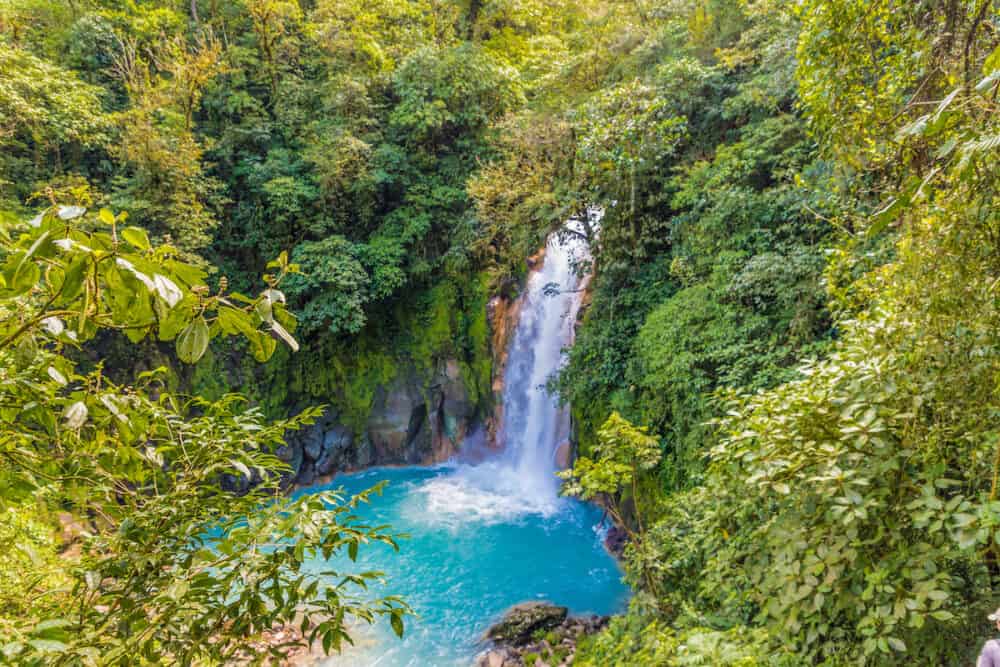
10. Combo La Fortuna Waterfall and Volcano Hike & Hotsprings
⭐️ RATING: 5/5 | ⏳ LENGTH: 10 hours | ✅ Book it!
During this fully guided combo tour from La Fortuna, you will explore the lush rainforest and captivating waterfalls surrounding Arenal Volcano. This excursion generally includes nature walks, traversing hanging bridges, and immersing yourself in the indigenous culture of the Maleku Village.
Along the journey, your knowledgeable guide will highlight wildlife encounters and reveal hidden spots to enjoy refreshing natural pools and soothing hot springs. This volcano tours Costa Rica is the best for those who love the outdoors.
“ Isaac and Juan, our driver, took us on a beautiful hike and down to the hot springs. The mud mask was so soothing and even though the hike was a lot on me (I’m out of shape), I so appreciated their patience! 10/10!” – Tripadvisor Reviewer
Witness Costa Rica’s stunning natural landmarks in this full-day tour. Your guide accompanies you as you hike along the base of the famous Arenal Volcano.
Witness breathtaking views at the top after your hike, a moment you’ll enjoy after a tiring climb. After hiking and walking, relax at the natural hot springs and refreshing waters at La Paz Waterfall.
- Start Time (and location): 8:00 AM at your chosen pickup point
- Duration: 10 hours
- Includes: Professional guide, Lunch, Hotel/port pickup and drop-off, Hotels around 6 kms from La Fortuna Downtown pick up, Alcoholic Beverages
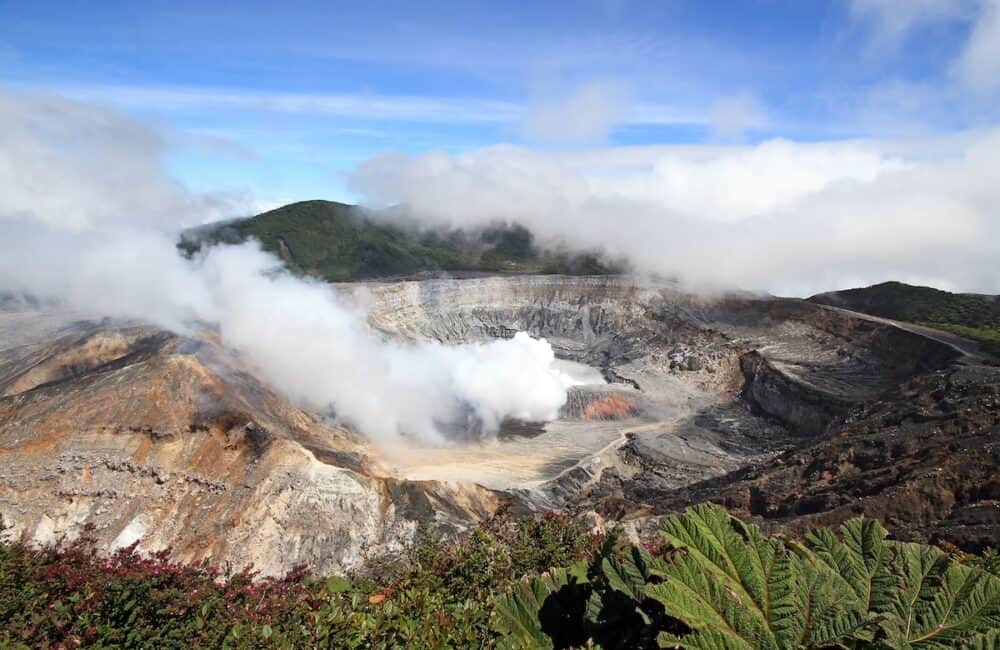
11. Coffee Experience, Poas Volcano and La Paz Waterfall Gardens
⭐️ RATING: 5/5 | ⏳ LENGTH: 13 hours | ✅ Book it!
Venture on a day-long adventure that offers a perfect blend of nature exploration and coffee education in Costa Rica. This group tour departing from San Jose includes breakfast, lunch, and convenient hotel transfers.
Visit the renowned Doka Coffee Estate, where you’ll gain insights into the coffee production process, from the growth of the beans to the final cup. Venture to Poas Volcano National Park for a hike, then end your tour with a visit to the captivating La Paz Waterfall Garden to observe the region’s diverse flora and fauna.
Very cool experience being my first time in Costa Rica. Donald and Alejandro were very knowledgeable tour guides and kept us moving on schedule, but didn’t feel rushed. I was also picked up early and I appreciated that. Make sure you bring a rain coat. This is a tropical climate. They do an outstanding job for the time we spent with them so tip them well!” – Charles_S
This tour offers the best of both worlds: Coffee and nature. The tour begins with convenient pick-up times with a delicious breakfast at the Doka Coffee Estate, where visitors learn about coffee production and discover why Costa Rica produces some of the best coffee in the world.
You will then visit Poas Volcano National Park, which provides breathtaking views of the main crater and a hike to Botos Lagoon. Finally, guests can explore lush rainforest trails at La Paz Waterfall Gardens, observe wildlife, and engage with educational animal exhibits.
- Start Time (and location): 6:00 AM at your chosen pickup point
- Duration: 13 hours
- Includes: Breakfast, Lunch, Air-conditioned vehicle, Entrance Fee to Poas Volcano National Park, Entrance Fee Doka Estate Coffee Plantation, Entrance Fee La Paz Waterfall Gardens, All Fees and Taxes, Operates with a minimum of two passengers
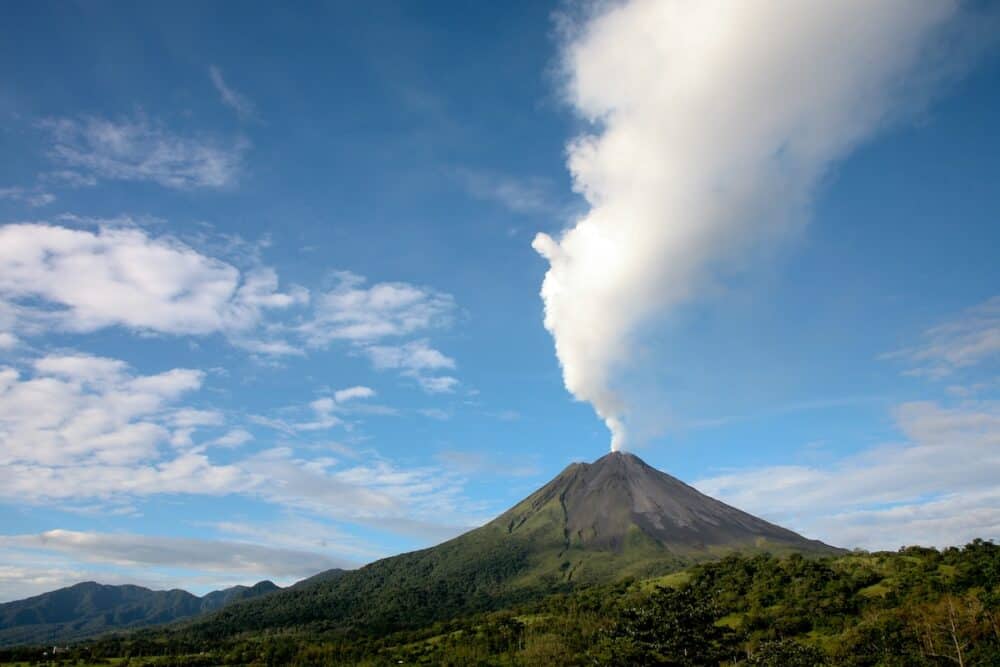
12. Morning Volcano Hike, Lunch & Hot Springs River
⭐️ RATING: 5/5 | ⏳ LENGTH: 6 hours | ✅ Book it!
This half-day tour to Arenal Volcano from La Fortuna offers a perfect blend of exploration and relaxation, with complimentary hotel pickup and drop-off from select locations. Venture into Costa Rica’s lush rainforest to uncover the Arenal Volcano on a half-day excursion
A local guide joins you as you trek through captivating lava formations, take a refreshing swim in a volcano-formed lake, and take a soothing bath in Tabacon River’s warm hot springs. Savour on a delectable Costa Rican lunch with the volcano as your backdrop, and immerse yourself in the rainforest’s beauty.
“ Me and friends did the Volcano Tour in the morning departure, our guide was HANZ, just a young mind with a lot of knowledge to share with everyone, he connected with everyone in the group in the best of the ways, he took profesional pictures from all the members in the group, and the control he had over the group was just espectacular, we finish going to the hot river at the end of the tour, such an incredible ending for an amazing day… I will highly recommend to other travellers!!! Thanks for the day!” – Tripadvisor Reviewer
If you want to visit Costa Rica’s renowned natural tourist attractions but need more time, this 6-hour tour is perfect. You’ll go on a thrilling rainforest hike to ancient lava fields and dip in a stunning green lagoon with views of the magnificent Arenal Volcano.
After those thrilling activities, head to a ranch for a delicious Costa Rican feast to tease your taste buds. Cap off the day with a visit to a natural hot springs river where you can unwind; it’s a Costa Rican experience you won’t want to miss!
- Start Time (and location): 10:00 AM at your chosen pickup point
- Duration: 6 hours
- Includes: Lunch, Local guide, Hotel pickup and drop-off (selected hotels only)
FAQs About volcano tour costa rica
For a volcano tour in Costa Rica, it’s important to wear comfortable, sturdy hiking shoes or boots as the terrain can be uneven and sometimes slippery. Dress in layers, as the temperature can vary greatly depending on the altitude and time of day. A lightweight, waterproof jacket is also recommended, as weather can change quickly. Don’t forget to bring a hat, sunscreen, and insect repellent to protect yourself from the sun and bugs. Also, pack a water bottle to stay hydrated and a camera to capture the stunning scenery.
Yes, you can visit active volcanoes in Costa Rica, and it is generally safe when you go with a knowledgeable tour guide and follow safety guidelines. Arenal and Poás are popular active volcanoes that tourists can visit. Tour operators are well-informed about the current conditions of the volcanoes and will ensure your safety throughout the tour. Keep in mind that access to certain areas may be restricted depending on volcanic activity, so always listen to your guide and stay within designated areas.
The physical demand of a volcano tour in Costa Rica can vary widely depending on the specific volcano and the type of tour you choose. Some tours offer easy, leisurely walks that are suitable for most fitness levels, while others involve more strenuous hikes that require a good level of physical fitness. Be sure to check the tour description and communicate with the tour operator about your fitness level and any concerns you may have. There are volcano tours available for a wide range of abilities, so you can find one that’s comfortable for you.
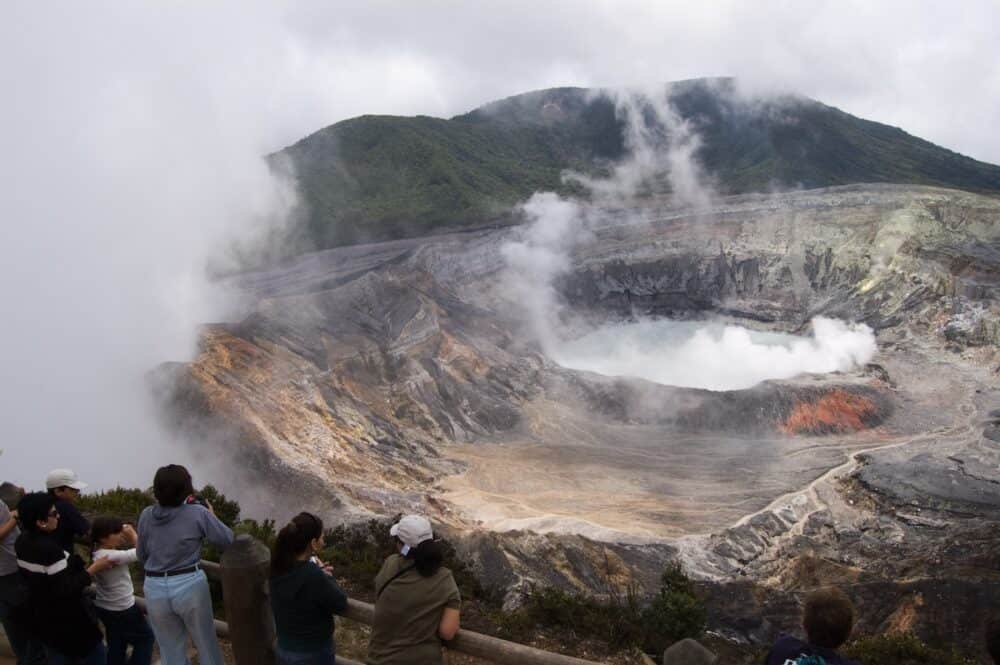
Final Thoughts: volcano tours in Costa Rica
As we come to the end of our journey through the best volcano tours in Costa Rica, it’s clear that these natural wonders offer an adventure unlike any other.
Whether you’ve decided to explore the mighty Arenal, the mysterious Irazú, or any of Costa Rica’s other majestic volcanoes, you’re in for an experience that will fill your trip with awe and excitement.
Remember, each volcano has its own story to tell, and there’s a tour out there that’s perfect for you, no matter your interests or fitness level. From leisurely walks with stunning views to challenging hikes that test your limits, you’re sure to find an adventure that suits your taste.
So, pack your bags, bring your sense of adventure, and get ready to explore the powerful beauty of Costa Rica’s volcanoes.
These tours are not just about seeing a natural wonder; they’re about immersing yourself in the rich tapestry of landscapes, wildlife, and culture that Costa Rica has to offer. Safe travels, and may your volcano tour be an unforgettable highlight of your Costa Rican adventure!
- Best areas to stay in Costa Rica
- Things to do in Costa Rica
- 7 days in Costa Rica
- Best Beaches in Costa Rica
- Day Trips from Costa Rica
If you’d like to save it for later, please save it to Pinterest.
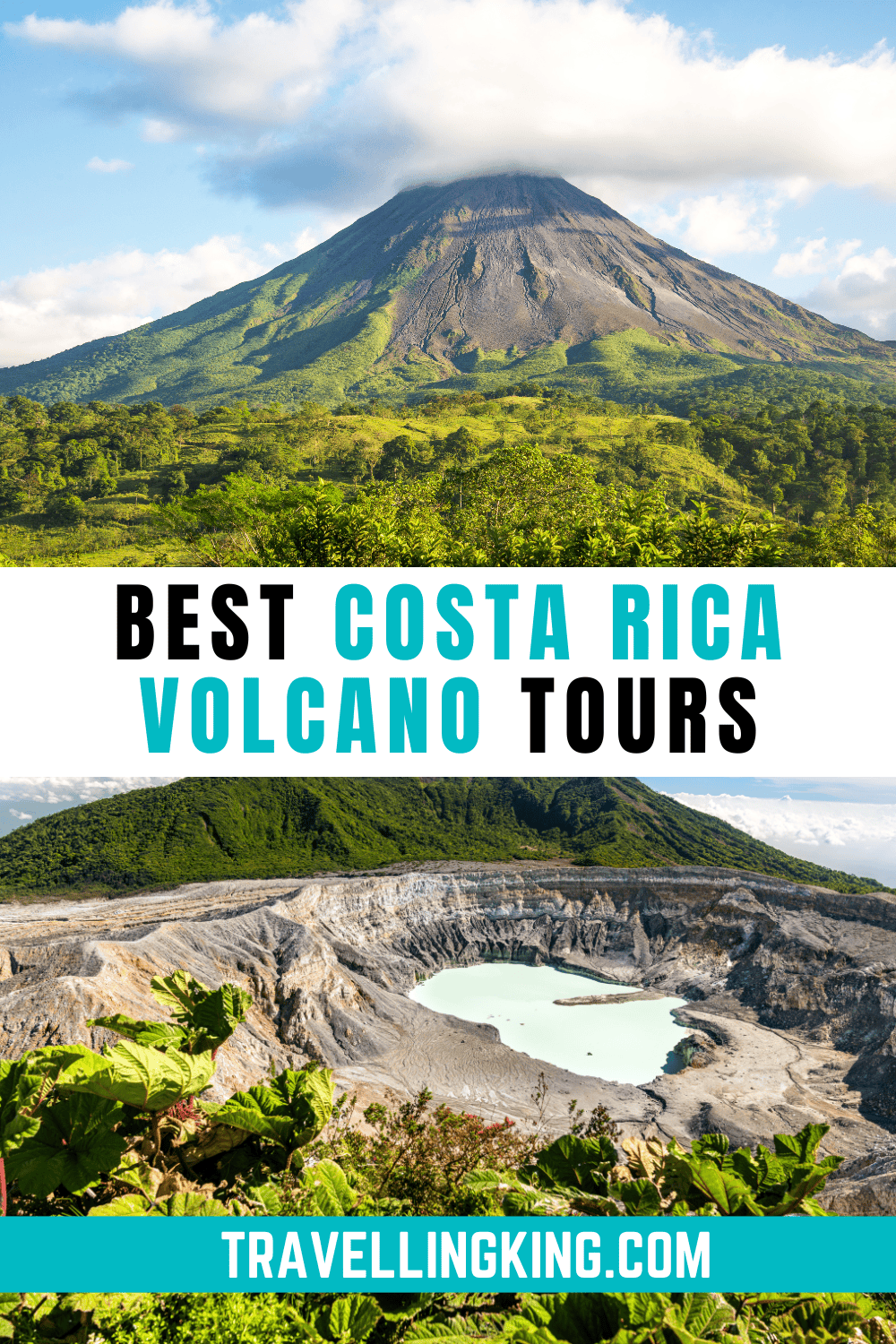
Sam, a seasoned traveler across four continents and 49 countries, is a leading authority in travel planning. Her website, Travelling King, offers tailored itineraries and expert guides for seamless trips. Sam's expertise in luxury travel, fast travel, and destination guides keeps her at the forefront of the travel community.
View all posts
Similar Posts
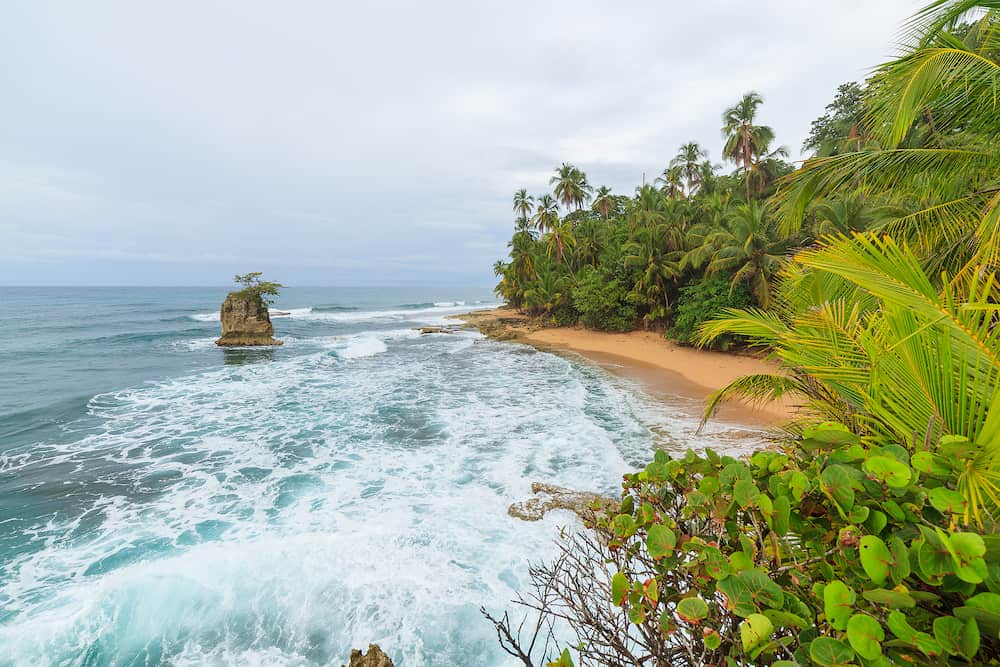
15 of the Best Beaches in Costa Rica
Costa Rica is a small country located in Central America, with the Pacific Ocean to the west and the…
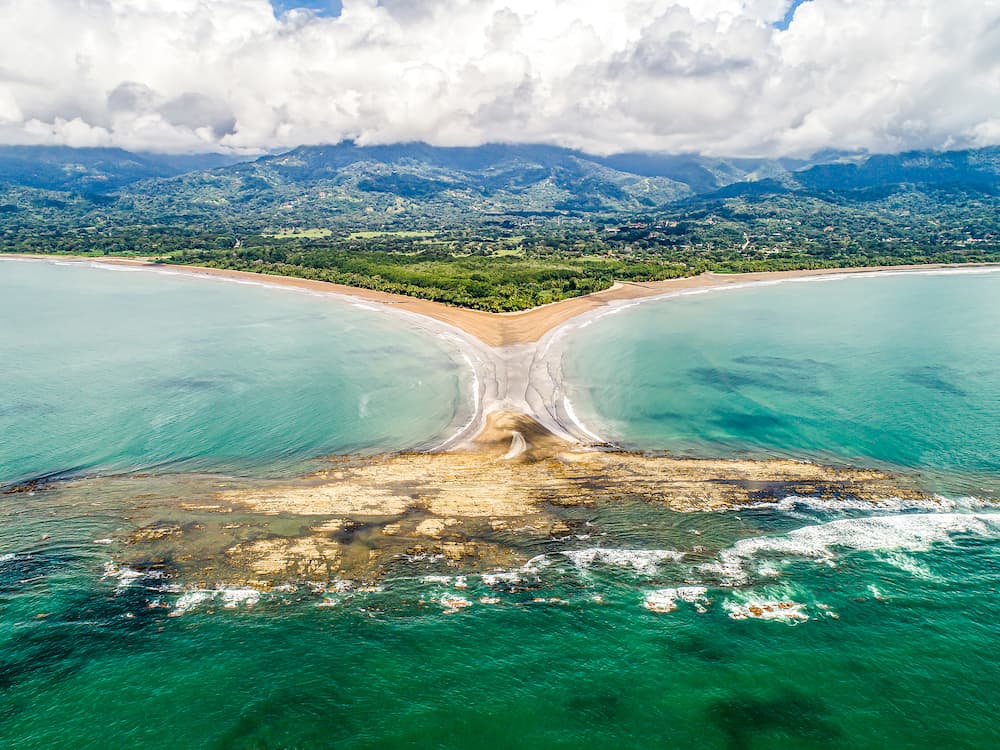
Need An Adventure Vacation? Here’s Why You Should Look No Further Than Costa Rica
Why do we book vacations? This question is fairly open ended – the result will probably be different for…
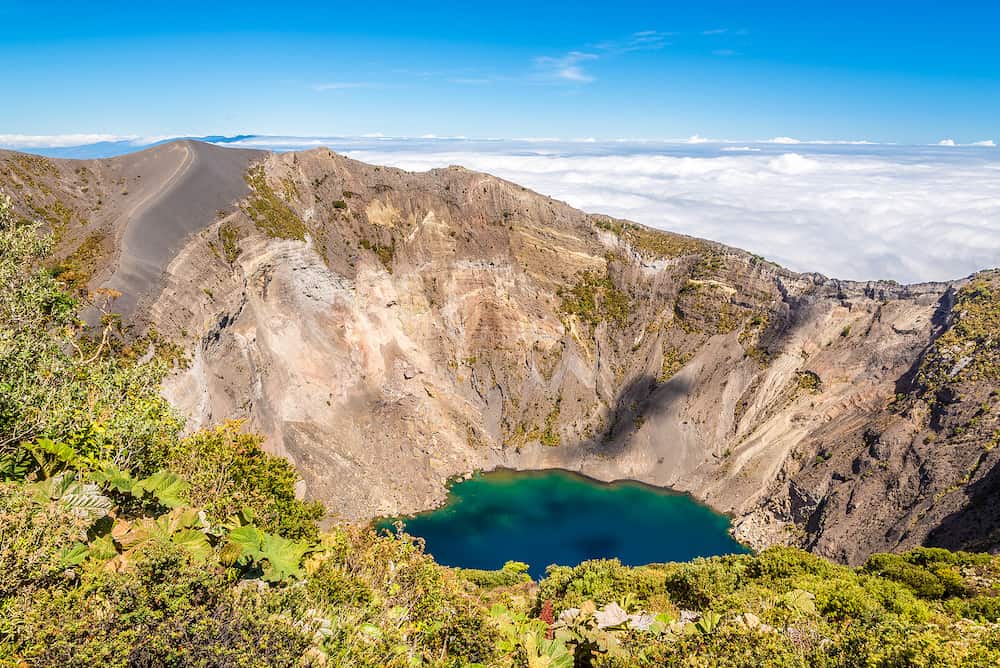
Best Day Trips from Costa Rica
The words “Costa Rica” mean “Rich Coast”, accurately referring to the richness of the country’s biodiversity and its unique…
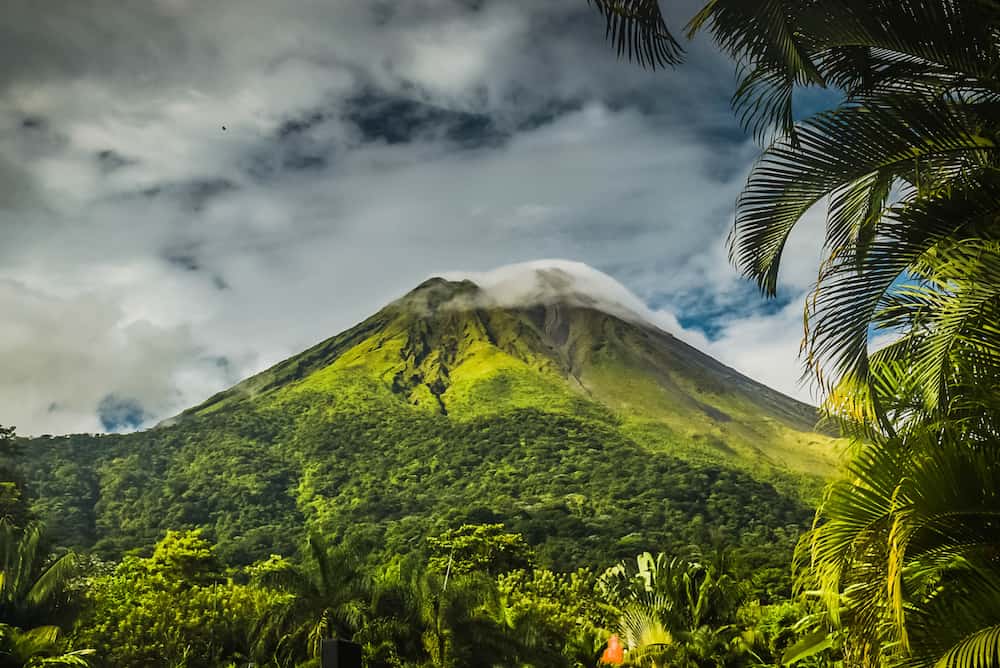
The Ultimate Guide of Things to do in Costa Rica
When one of my friends returned home from a trip to Costa Rica, he told me that the country…
![costa rica volcanoes to visit Where to stay in Costa Rica [Best Places to Stay for 2024]](https://www.travellingking.com/wp-content/uploads/2024/01/Where-to-stay-in-Costa-Rica.jpg)
Where to stay in Costa Rica [Best Places to Stay for 2024]
Costa Rica is a great place for eco-tourism. About a quarter of the country is protected jungle, full of…
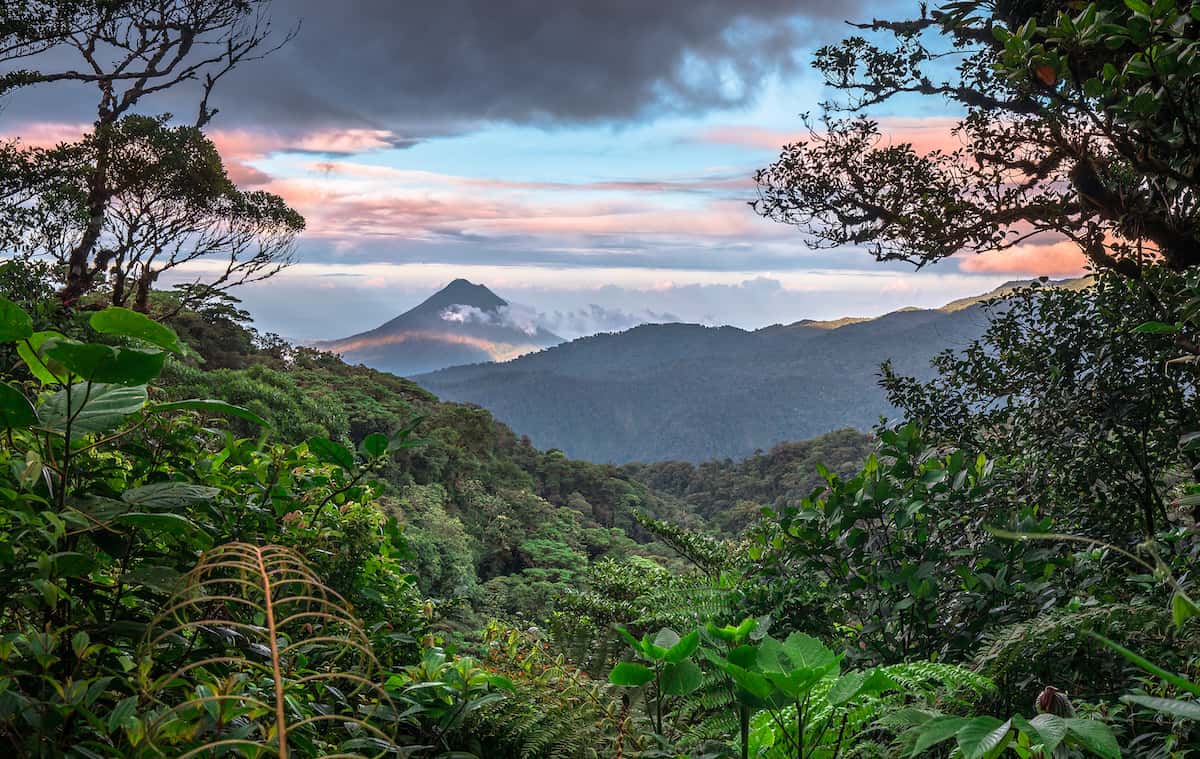
1 Week Itinerary for Costa Rica
Costa Rica is a small, yet incredibly beautiful country that has something for everyone. Whether you’re an adventure seeker…
Leave a Reply
Your email address will not be published. Required fields are marked *
Save my name, email, and website in this browser for the next time I comment.
This site uses Akismet to reduce spam. Learn how your comment data is processed .

Top 5 Most Active Volcanoes to Visit in Costa Rica & What To Know About Them
You’ve certainly heard that Costa Rica is a country with lovely beaches, stunning jungles, and a vast wealth of flora and fauna, but did you know that it also has plenty of volcanoes? In addition to the five still active, the nation is home to over 100 other mountains considered dormant or extinct.
There are numerous activities, all based on their towering and majestic heights, for tourists to enjoy. For instance, hot springs with mineral-rich water are a magnet for spa fans due to the heat from the volcano’s magma close to the surface. The small elevation fluctuations produce a hub of biodiversity unmatched anywhere else in the globe, attracting both scientists and tourists.
This article will also provide essential information to let you know what is the most active visited volcano in Costa Rica and the top volcanoes to visit for the greatest thrill if you’re planning a trip to this beautiful country.
The 5 Active Volcanoes of Costa Rica

Arenal Volcano
Arenal, at 1,670 meters above sea level, is undoubtedly the most well-known of Costa Rica’s volcanic giants since it is one of the world’s top ten most active volcanoes. It is in the nation’s northern region and towers above the lush surroundings, where the best coffee globally is grown on plantations.
Arenal and its surroundings make a fantastic base for adventurous travel. Therefore, you won’t be let down by the awe of its splendor as you watch the vapor fumaroles flow continuously. The best thing is that you may enjoy this stunning scene while relaxing in naturally heated hot springs that the volcano has warmed.
In addition to being a magnificent conical volcano to admire, it is also home to some of the best hikes in the area and a wonderful zip-lining canopy tour. La Fortuna is a small rural community that has managed to hold on to its Costa Rican customs. Here, you may sample regional cuisine, travel to nearby natural attractions, and enjoy an incredible view of the Arenal Volcano.

Poás Volcano
This volcano is also among the most well-known places to visit in Costa Rica. Two crater lakes, active fumaroles, and sulfuric emissions make it one of the biggest active volcanoes in the world.
The northern lake, known as the Laguna Caliente or a hot lagoon, is among the world’s most acidic water bodies, in stark contrast to the Botos Lake, which is cool, clear, and encircled by the grandeur of the tropical cloud forest.
For the best views of the crater before the clouds roll in, get there as soon as the Poás Volcano National Park opens at 8 am. Another quick 30-minute hike will lead you to a lovely picnic location on the lake, which is well worth the effort.
The location also has a cafe, a small but highly educational museum with fascinating information about the volcano, and a gift store. You can also visit the La Paz Waterfall Gardens if you have the entire day to spare. That’s what I did!

Irazú Volcano
The Irazu is Costa Rica’s tallest volcano, rising beyond 11,000 feet. In fact, you can see the Pacific and the Caribbean if you’re fortunate enough to reach the peak on a clear day. However, keep in mind that it gets a little chilly up there, so dress warmly.
Despite being a little over an hour’s drive to the east, the Irazú Volcano National Park is not as popular with tourists as the Poas Volcano despite being the nearest to San José. The main crater is 1050 meters in diameter and offers breathtaking views.
The hiking routes surrounding the Irazú Volcano are mostly level, similar to Poas, making them accessible to almost everyone. The sole distinction is that they are not paved, making them less accessible for visitors on wheelchairs.
There are fantastic half-day volcanic tours starting from San Jose for those with limited time. There are also full-day tours that include a luncheon with views of the Orosi Valley and a visit to Lankester Gardens.

Rincón de la Vieja Volcano
The name “ Rincón De La Vieja ” means “corner of the old lady,” which is how the locals refer to it. This volcano, which is Costa Rica’s third-most active, is surrounded by a freshwater lake, geysers, waterfalls, hot springs, and boiling mud pools.
The Rincón de la Vieja Volcano National Park has a vast network of paths that range in length from brief excursions to all-day hikes. Sadly, climbing the crater is no longer possible because of the most recent volcanic activity. However, there are still plenty of mud pits, hot springs, waterfalls, fumaroles, and crater lakes to explore.
You can choose the ideal trail out of the 7 available options, all of which range in complexity. The Las Pailas portion, which has easy hiking trails suitable for people of different physical abilities, receives the most visitors.
As part of a vacation package that includes several of Costa Rica’s well-known eco-adventure parks, experience the thrill of zip-lining, unwinding in natural hot springs, or riding a horse through some of Rincón de la Vieja’s most breathtaking scenery.

Turrialba Volcano
Although Turrialba Volcano is one of the least frequented of our top 5, it is now receiving worldwide attention. This attention is impacting some travelers’ plans for their Costa Rica vacations due to the recent rise in volcanic activity.
It has one of the most scenic roads in the nation since the access route features lovely ranches, coffee plantations, rivers, and authentic displays of rural country life. It is the second-highest volcano in Costa Rica, rising 3,340 meters above sea level. The mountain lies in a cloud forest, so the temperature is fairly cool there—around 55 degrees.
This volcano is well-known for its ongoing release of ash and white smoke. It is also home to remarkable fauna, including gigantic toads, agoutis, toucans, armadillos, howler monkeys , and long-tailed hermits. It also boasts of having a wide diversity of natural vegetation splendor.
Turrialba Volcano is about 50 kilometers from San Jose. Since there are no tarmacked roads leading to the destination, the nature resorts surrounding it provide horseback trips to take you up to the summit.
Frequently Asked Questions About Costa Rica’s Volcanoes
How many volcanoes are there in costa rica.
Over 75 million years ago, a volcanic movement created the geography of present-day Costa Rica. Therefore, the country is home to some of the most stunning active volcanoes in the world. The nation is home to approximately 120 volcanic sites, but only five (listed above) are active. Most of Costa Rica’s volcanoes are now protected zones or national parks.
What Is The Most Visited Volcano In Costa Rica?
The Arenal and Poás Volcanoes are currently the most popular and highly visited volcanoes in Costa Rica. The Arenal is endowed with plenty of beautiful natural sceneries to captivate all who visit it. On the other hand, Poás’ location makes it a highly attractive option to visitors since it is a little over an hour from the San José International Airport in the stunning Central Valley.
What Is Costa Rica’s Most Active Volcano, And When Did It Last Erupt?
Currently, the most active volcano is the Turrialba Volcano in central Costa Rica , as it has experienced frequent explosive eruptions from 2016, as well as in January, March, and April of 2017.
Before 2014–17, visitors could climb into the main crater, but an increased volcanic activity that produced thick clouds of volcanic ash forced the closure of Turrialba Volcano National Park. The park and volcano, however, reopened on December 4, 2020, after the eruptions stopped.

Which Volcano Is Better In Costa Rica?
The Arenal Volcano is the most popular and well-known volcano in Costa Rica due to often being considered the best volcano site in the country. It is also Costa Rica’s tourism industry’s show-stopping centerpiece, providing plenty of cool activities visitors can engage in and enjoy.
Some of the most popular ones include; the Arenal hot springs, trekking through the Arenal Volcano National Park’s canyons, kayaking on Lake Arenal, and zip-lining. Additionally, if you want to view and take pictures of a famous, cone-shaped volcano, it’s the best volcano in Costa Rica to go to. I personally found it quite impressive as seen from Lake Arenal.
Which Volcano Is The Biggest Threat To San José, Costa Rica?
The Turrialba volcano is 30 kilometers from the western Central Valley, with approximately 2.1 million residents as of 2010 on the easternmost edge of Costa Rica’s Central Volcanic Range. Since San José is located directly downwind from Turrialba and receives most of the Caribbean’s E-W winds, it could be in danger.
In 1864–1866, an eruption seriously damaged an area 3 km in diameter surrounding the volcano and sent ash over San José city and 130 km down to the Pacific coast . A small, recently opened fumarolic vent produced lithic ash on January 5 and 6, 2010, due to intense fumarolic-phreatic activity (T>500°C).
According to earlier predictions, the very fine ashes dispersed to the southwest and west and eventually reached San José’s eastern suburbs (35 km away). Phreatic or magmatic eruptions in the future (months to decades away) pose a serious hazard to homes and farms within 5 km of the volcano, as well as to agriculture, pastures, and telecommunications on the volcano’s western flank.
Due to the location of the main international airport in Costa Rica, which is on the ash dispersal trajectory, the “worst-scenario” eruption might harm up to 1.5 million people and hinder air travel.
Can You Hike To The Top Of Arenal Volcano?
This enormous mountain (Arenal Volcano) reaches an astonishing 1,657 meters tall, but it does not deter tourists from setting out on expeditions to reach its lava-filled terrain in La Fortuna.
Numerous treks in Arenal Volcano National Park allow you to stroll around the base of the volcano, along the old lava fields, and through the jungle, even though climbing to the top of the Arenal Volcano is not permitted.
The best time to use the trails is by visiting the park between February and April when the place is experiencing dry weather. The routes usually become hazardous and impassable during other times of the year due to heavy rain present in the region.

Is Costa Rica Part Of The Ring Of Fire?
There are more than 250 known volcanic formations in Costa Rica, which is a part of the magnificent Pacific Ring of Fire and has been home to volcanoes for more than 75 million years. However, there are currently only over 100 sites that exhibit volcanic activity.
Three volcanic mountain ranges cut through Costa Rica’s “land of fire”: the Guanacaste Region, which includes significant volcanoes like Rincón De La Vieja and Arenal; the Central Volcanic Zone, which consists of the magnificent volcanoes Turrialba, Barva, and Poás, and; finally, the Cordillera de Tilarán, which includes El Chato.

Last Thoughts
Every year, many people travel to Costa Rica to see the volcanoes since being in the vicinity of such a majestic force of nature is truly captivating. Fortunately, there are many other thrilling activities that you can partake in around the volcanoes.
For instance, many volcano national parks pair well with activities like white water rafting, kayaking, horseback riding, bird-watching, zip lining, volcanic mud bathing, and mountain biking.
Julien is an exploration-minded, curiosity-driven traveler and blogger. On a mission to witness the planet's natural beauty and diversity, he shares his experiences on this website through articles, videos, and photography, including interactive virtual tours.
Fascinated by animals and plants since young, he is also fond of outdoor and so-called extreme sports, often discovered while traveling and practiced back at home where he focuses on improving his knowledge and skills - so he can explore further on the next trip!
More About Me
You May Also Like

All About Costa Rica’s National Fruit: The Guanábana

Meet The National Animal of Costa Rica, The Sloth

Which side of Costa Rica is Better? Pacific Coast or Caribbean Coast?

All About Costa Rica’s National Flower: The Guaria Morada

What Species of Monkeys Are in Costa Rica and Where to See Them?

Discover Costa Rica’s National Tree: The Guanacaste
Leave a comment cancel reply.
Notify me of follow-up comments by email.
Notify me of new posts by email.

Costa Rica Volcanoes – Visit Up Close
Disclaimer: This article may contain affiliate links. Clicking on them may earn Costa Rica Vibes a commission, at no extra cost to you. Thank you for your support!
One of the most popular draws for tourists to Costa Rica is all of the amazing volcanoes. Costa Rica volcanoes exist all over the country. Some are dormant, but there are plenty of active ones as well. In fact, the country is home to five active volcanoes and over 50 dormant volcanoes.
Did you know that Costa Rica is part of the ring of fire? For those of you who have no idea what I’m talking about, no, I am not referencing the classic Johnny Cash song “Ring of Fire.”
The ring of fire is the name given to the ring-shaped area of land that runs along the Pacific coast. This area is home to 75% of the world’s volcanoes. That means that there are also a lot of earthquakes in Costa Rica due to this seismic activity. Fortunately, most of the earthquakes are very mild.
Active Volcanoes in Costa Rica
As I mentioned above, there are five active volcanoes in Costa Rica. All five volcanoes are considered Costa Rican national parks . Although they are active you are still able to visit four out of the five volcanoes. Let’s go through each one!
Poas Volcano – Alajuela
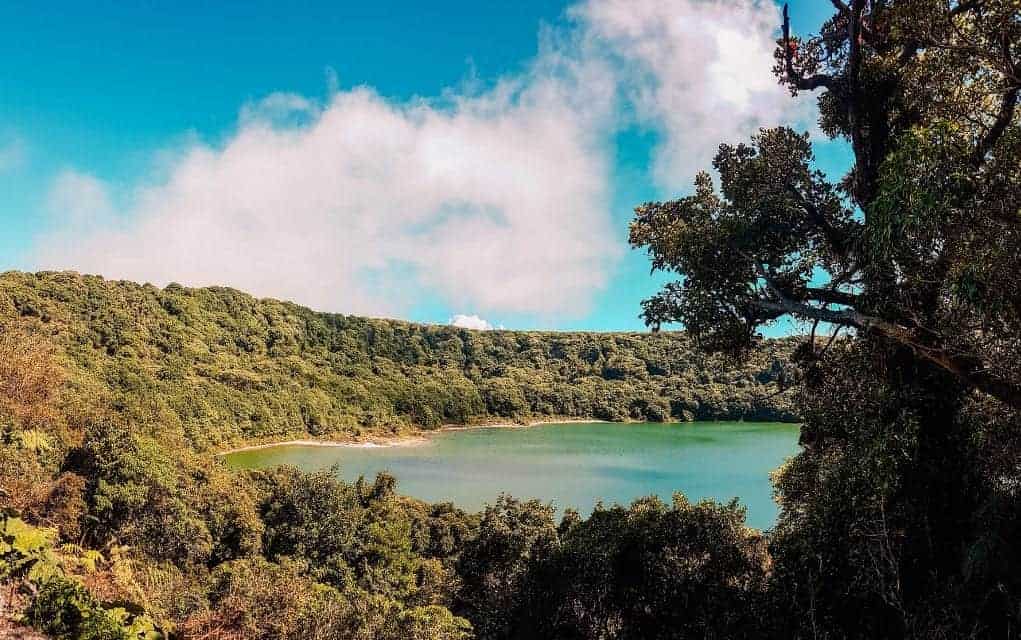
Poas Volcano is the most visited volcano in Costa Rica. On a clear day, this place is absolutely beautiful. We also love this place because it is located less than an hour away from the San Jose Airport in the beautiful Central Valley.
If you would like to see crater lakes, this is our top pick for that experience. As you can see in the picture above, the crater lake here is huge and amazing.
In recent years Poas has gone through a few somewhat major eruptions. Regulations are now much stricter for visitors. You do need to purchase your tickets ahead of time online. We suggest doing this via Viator, here . It is a few dollars more but it will save you so much hassle.
Check out our Complete Guide to Poas . This guide will walk you through the whole ticket purchasing process and give you plenty of other helpful tips including info on the best time of day and year to visit for a really clear view of the crater.
Irazu Volcano – Cartago
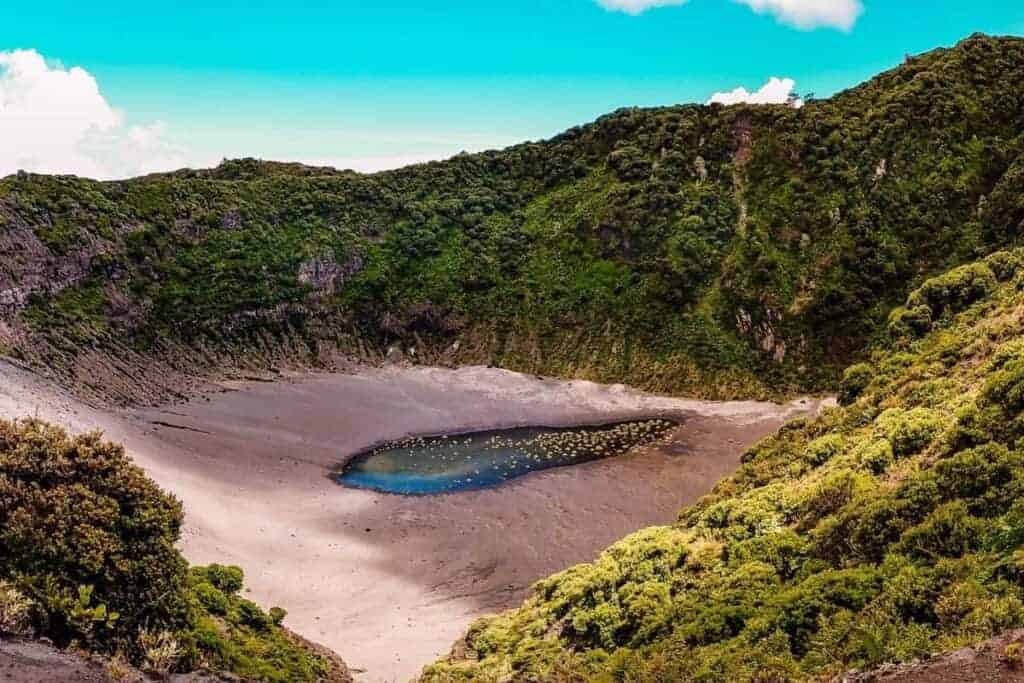
I really like Irazu volcano because as a visitor you can get very close to the crater. The crater is also located just next to the parking lot, so it is not a difficult walk at all.
Keep in mind that this is the highest point in all of Costa Rica. Be prepared to take things slow. The altitude can definitely get to you.
For more information on planning your visit, check out our Guide to Irazu Volcano . This guide also includes fun things that you can do in the nearby area after your volcano visit.
Rincon de La Vieja – Guanacaste
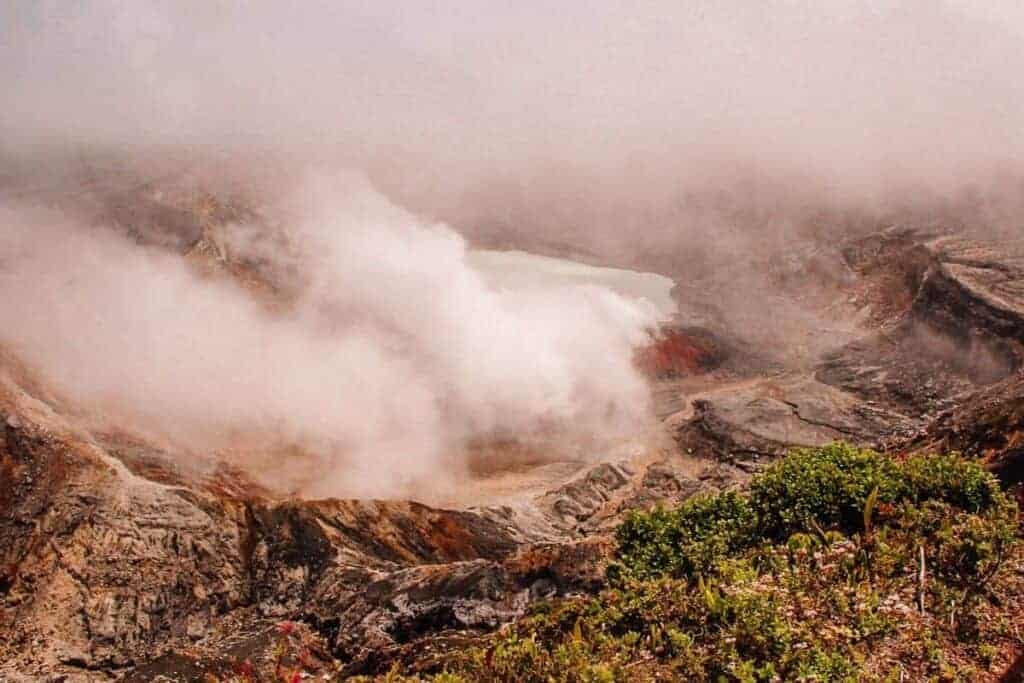
Rincon de la Vieja is located in the northwest part of the country near the Nicaragua border. If you are planning to fly in or out of Liberia airport this is only a short drive away.
This area is great for relaxing in hot springs, hiking, horseback riding, and more!
We have a complete guide to the area for more info .
Arenal Volcano – La Fortuna
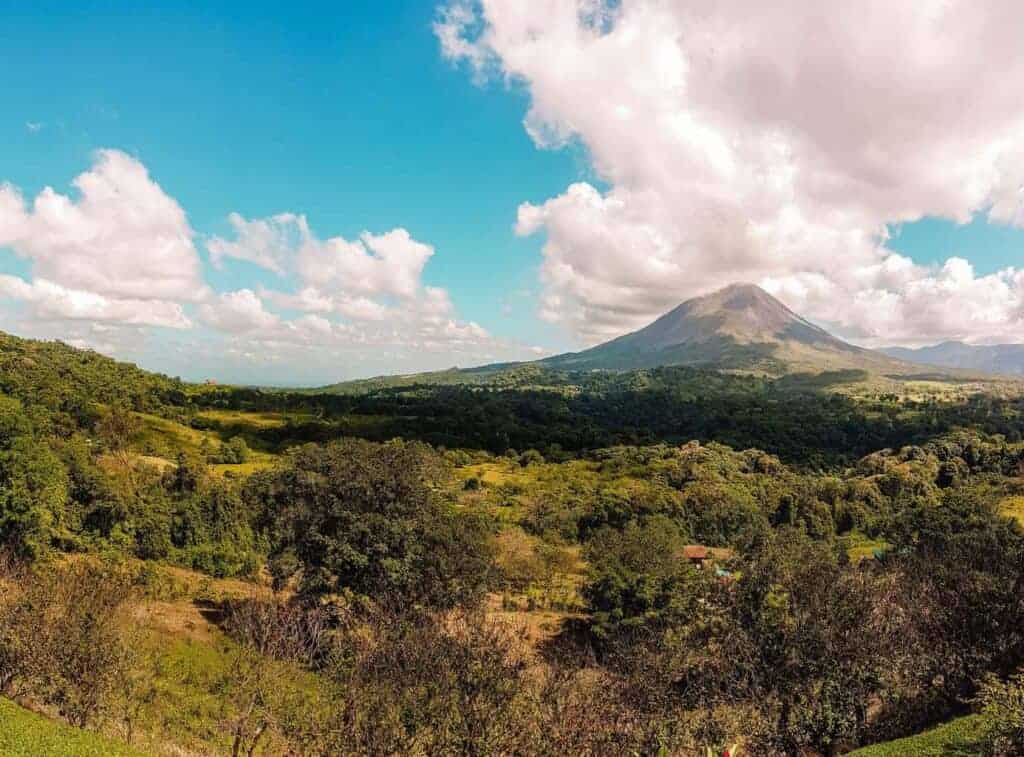
Arenal Volcano is the epitome of what you imagine when you think of a volcano. It is so cool to be driving in to La Fortuna and to look up and see this massive natural structure rising up in to the sky.
Arenal is an active volcano so it is not possible to hike to the top of it. However, there is an old lava field where you can see the path of the lava flows. This makes a great hike.
This trail is called the 1968 trail. You do not need a guide to visit but the walk does cost $15 per person. You can find out more on the official 1968 trail website .
Although the hike is nice, our favorite way to enjoy this volcano is from below. We like to visit the nearby hot springs with a picnic and just enjoy the view.
The best time of year to ensure a great view is during the dry season (January until April). We have visited a few times during rainy weather and haven’t been able to even see the volcano. You just never know how the weather will be during the rainy months.
We have a complete visitors guide to Arenal Volcano for more info.
Turrialba Volcano – Cartago
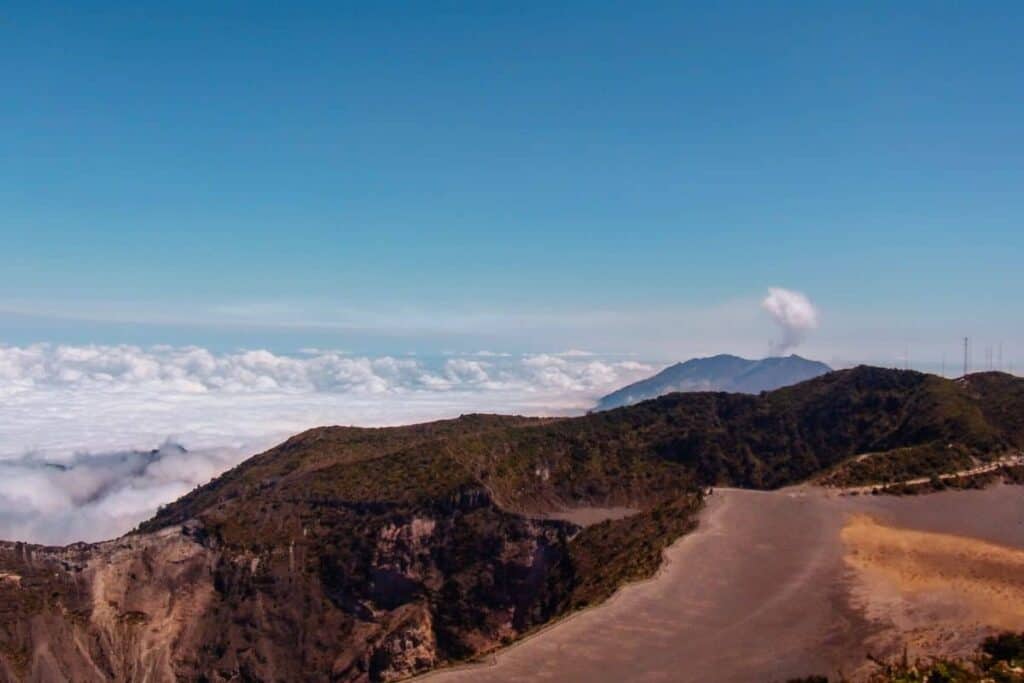
See that puff of smoke in the image above? That is the Turrialba volcano. On a clear day, you can see it erupting from the top of Irazu Volcano.
It is not currently possible to visit Turrialba volcano due to the constant eruptions. However, you can drive to the town of Turrialba and even to the entrance of the park. From here you can see the eruptions. Just be warned your clothes might get rather ashy and it is not good to breath close to the volcano for too long.
We live almost 50 miles away from Turrialba and we even have problems with ash. It is not fun when your floors have a constant layer of soot on them. It is probably not the best for us to constantly be breathing that in either.
Costa Rica Volcano Map
Here is a map of all the volcanoes in Costa Rica that we have mentioned above. This will give you a better idea of where exactly you have to go to visit each of these unique destinations.
Inactive Costa Rica Volcanoes
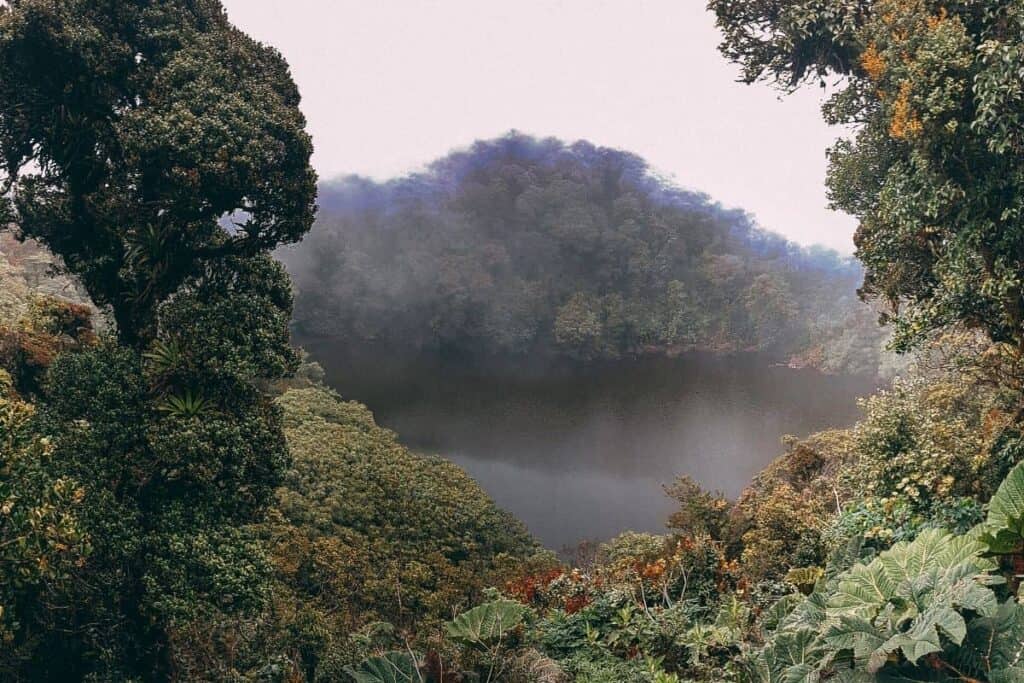
As I mentioned at the beginning of this article, there are over 50 dormant or extinct volcanoes in Costa Rica. Most of these are really small, but there are a few substantial ones which you can actually visit.
Barva Volcano – Heredia
Barva Volcano is a great place to hike. It is located about 45 minutes away from San Jose airport. We like hiking here because there is hardly ever anybody else around. It’s really peaceful.
For more volcano info, check out the Barva website . Just keep in mind that you will need a car with 4 wheel drive to get here.
↪FIND OUT HOW TO GET UP TO 10% OFF YOUR CAR RENTAL IN COSTA RICA!
Cero Chato Volcano – Near La Fortuna
This volcano is unfortunately not open for visitors as of 2017. Because it is located next to Arenal Volcano people were using it to climb up the back side of Arenal. The Costa Rican government had to close it to keep this from happening.
There is a fence blocking off this hike but I have heard of many tourists ignoring the closure and cutting through the fence to hike anyway.
I don’t recommend doing this for your own safety. If something happens while you are hiking it will be very difficult for any emergency services to get to you. Plus, there will likely be nobody else around to help you, but you can make your own choices on that. 🙂
Tenorio Volcano
Most people visit Tenorio National Park to enjoy the bright blue waters of Rio Celeste Waterfall . However, it is also possible to visit the volcano side of the national park as well.
I will warn you, the roads around here can be….interesting. I definitely suggest having a four-wheel drive vehicle. I once gave my dad the wrong directions and he drove around this area for several hours. I felt horrible, but he seemed to love it and described it as a scene from the Deliverance (doesn’t really sound fun to me, but whatever).
Anyway, you will need to hire a private guide if you wish to hike the volcano. Access is very limited.
Miravellas Volcano
This volcano is located between Tenorio Volcano and Rincon de La Vieja. This area is great for soaking in several different hot springs.
Costa Rica Volcano Safety
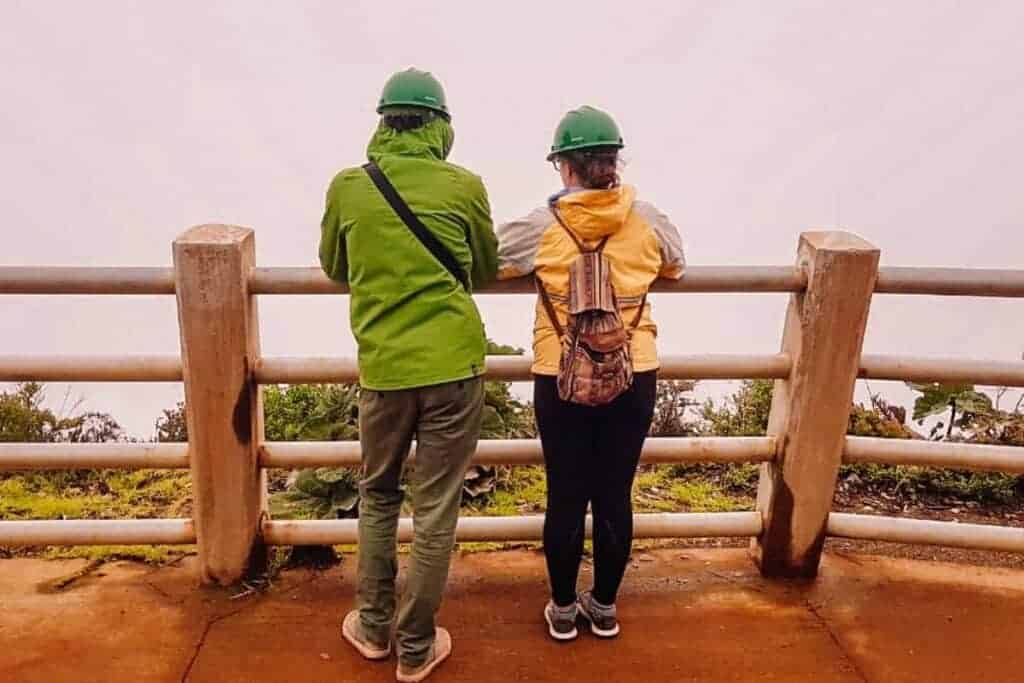
Although Costa Rican volcanoes are really fun to visit, you need to be careful. Your health and safety are obviously your top priority. Although Costa Rica does a great job of trying to post signs and enact safety measures, they are not always as thorough as you may be used to. Here are a few things to consider….
-Some of these volcanoes are really high in elevation. In fact, Irazu Volcano is 11,260 ft (3,432 meters) high. If you are at the top of any of these extremely high volcanoes you may find yourself getting out of breath very quickly.
It is best to walk slow and take frequent breaks. I always bring Gatorade (I swear it helps) and some granola bars to munch on to keep my energy level up.
If you really are not feeling well, head down the volcano immediately. Altitude sickness is no fun!
-Most parking attendants near the volcanoes will tell you to pull in to your parking space with the front of your car facing out. This will allow you to drive out of the area quickly in case of an eruption.
If the parking attendant does not mention this, it is best to do this anyway. It doesn’t hurt to have the knowledge that you can drive off quickly if needed.
-Costa Rica is great about monitoring volcanic activity and taking precautions when necessary.
For example, because Poas has been so active in recent years, guests now need to wear hard hats and go with a group to visit the crater. You are also only allowed to stand at the crater for about twenty minutes. This time limit is to keep you from breathing in the gasses for two long.
My point is, maybe the rules seem dumb sometimes but they are all in place for your safety.
Alright, that’s all we’ve got for you on Costa Rica volcanoes. If you have any questions please feel free to leave them in the comment section below and we will get back to you as soon as possible. Also, if you have any other tips for fellow travelers we would love to hear them .
You Might Also Like:
Poas Volcano Complete Visitors Guide
Arenal volcano: practical visitors guide, irazú volcano national park in costa rica: guide to visiting, rincon de la vieja national park – volcanic adventure.
Costa Rica Travel Details : What You Need to Know
🚗 Should I rent a car in Costa Rica?
Having a rental car will give you the most flexibility when traveling in Costa Rica. This will also allow you to take fun day trips on your own.
- Save 10% Plus Other Perks with Our Adobe Rental Car Discount
- You might also consider; shared shuttle services or private transfer services
🏄🏽 How can I book things to do?
We find that Viator tends to have the most comprehensive selection of activities with secure booking and good cancellation policies.
🍍 I’m overwhelmed with planning. Can you help?
Of course! I suggest joining our Facebook group for specific questions and head to our Start Here Page to get started planning.
✈️ What is the best way to book a flight?
Usually, we have the best luck finding great prices with Skyscanner . Check for flights to both San Jose Airport (SJO) and Liberia Airport (LIR).
🛏️ What is the best way to book my Costa Rica hotels?
We highly suggest Booking.com for hotel bookings and typically use VRBO for Costa Rica vacation rentals.
🗣️ What is the main language in Costa Rica?
The main language in Costa Rica is Spanish. Most people working in tourism speak at least some English.
💰 What is the currency in Costa Rica?
The currency used in Costa Rica is the Costa Rican colón (CRC). However, the US dollar is widely accepted in most tourist areas
📞 What is the best way to stay connected?
An eSIM from Airalo is the easiest way to get 4G data while traveling in Costa Rica.
🌴 Is Costa Rica safe?
Generally, Costa Rica is considered safe for tourists. However, like any travel destination, it’s best to use caution and be aware of your surroundings.
🛂 Do you need a passport to go to Costa Rica?
Yes, Costa Rica is its own country. You will need a passport to visit.

Hi! We’re Thomas (the German) and Sarah (the US-er)
We met in Virginia, moved to Germany, and since 2016 we have lived in sunny Costa Rica. It was a spontaneous decision to move here, but it was the best decision! Now we spend our days roaming the country to bring you the very best in Costa Rica travel here on Costa Rica Vibes. Sarah is the writer. Thomas is the one keeping it all together. Want the whole crazy story?

Sarah McArthur
Sarah McArthur is the co-founder and main writer of Costa Rica Vibes. She is originally from the United States but has lived in sunny San Jose, Costa Rica since 2016. She has traveled all over the country and now considers herself a self-proclaimed Costa Rica travel expert. Want the whole crazy story?
Leave a Reply Cancel reply
Your email address will not be published. Required fields are marked *

Shop All The Costa Rica Packing Essentials
- Find Your Trip
- Vacation Ideas
- Travel Tips
Customized Costa Rica Vacations, since 1999.
Volcanoes of Costa Rica
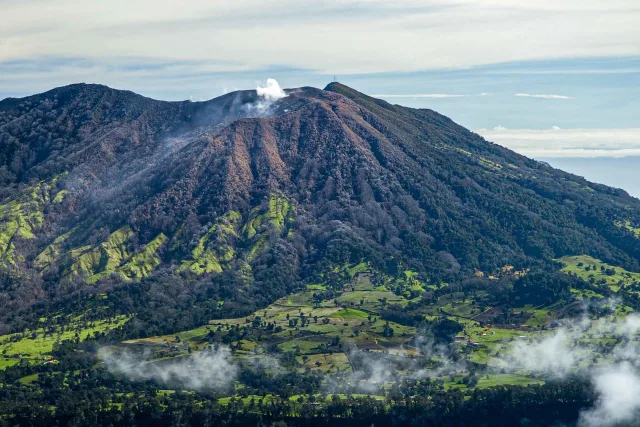
We live, work & travel in Costa Rica.
Every trip is designed for you.
5,000+ reviews from dazzled guests.
Seeker is the social platform to find and share the places you love.
0 Places . 0 Trips and Guides.
Please enter your email
- Seeker for Brands
- Become a Brand Ambassador
- Let’s connect
New to Seeker? Join for free
Already have an account? Login
- Central America
Costa Rica Volcanoes: Visit These 5 Active Volcanic Spots
Sustainable travel expert, adventure seeker
8670 Aljezur, Portugal
Costa Rica is an ecotourism hotspot teeming with biodiversity, breathtaking landscapes and plenty of friendly locals to show you around. This tiny country, like most of Central America, has volcanic origins, and these hot-lava cones have become some of the country’s favorite attractions. Of the more than 209 volcanoes are littered throughout this tiny tropical country, only five are considered to be “active.” Here’s a rundown of Costa Rica’s volcanos that you can oogle at on your explosive Central American holiday.
Poás Volcano
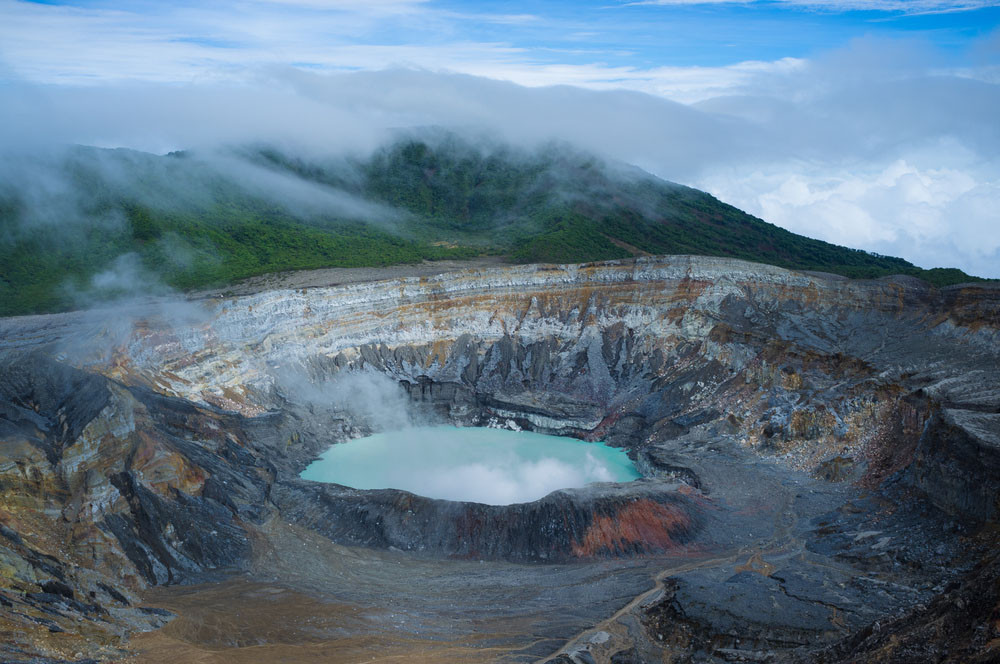
Located in the Alajuela province, this central mountain hot-spot features a giant central crater with an emerald-green rainwater lake called Laguna Botos . At more than a kilometer across and 300 meters deep, Poás Volcano is the largest active crater in the world — it’s bubbling, sulfuric lake is often surrounded by smoke and steam, and it shoots up some impressive geysers, with sprays that can hit more than 250 meters high.
Poas used to be the perfect day-trip from San José — it was actually the most visited national park in the country for a time. Unfortunately, due to increased volcanic activity, the park has closed indefinitely since an early 2017 eruption. There are rumors of reopening in 2018, although nothing has been concretized.
Keep your fingers crossed that this seismic beauty goes back on public display before your Costa Rican holiday — it certainly is a epic site to see.
Irazú Volcano

Costa Rica’s tallest volcano sits just 23 kilometers from San José, and is another excellent day trip if you’re spending time in the country’s capital. At a whopping 3,432 meters above sea level, the Irazú Volcano ‘s summit is so high up that the wind-whipped landscape is eerily moon-like. On a rare clear day, when the persistent clouds finally lift, you’re rewarded with simultaneous, breathtaking views of the Pacific and Atlantic oceans.
Pro Tip: Much of Irazú is above tree line, and all of it is above the frost line. Add to that constant winds, humidity and the low temperatures that altitude brings, and you’ve got one of the coldest destinations in Costa Rica. Be sure to pack that extra jacket, or parka. Also leave your hotel early, as you’ll have to get up to the rim and back down before the park closes at 15:30.
Rincón de la Vieja Volcano

This understated Costa Rica volcano park should be a must-visit for natural hot springs afficionados. With nine separate craters, bubbling mud pits, and endless trials, streams and waterfalls to explore, Rincón de la Vieja National Park is a nature-lover’s paradise.
The park sits in the Guanacaste region, less than an hour away from many of the popular north-west beaches. Easy access hiking trails wind through the 14,000 hectare park, which is split into two areas: Santa María, a former cattle farm that’s now a conservation zone, and Las Pailas – the cauldrons – where you’ll find boiling mud pots, steam vents and mini-geysers to delight the seismic-lover.
Wander further afield to find the fumaroles (natural steam vents) and natural hot springs. Unfortunately the main crater of the Rincón de la Vieja Volcano is currently off limits to tourists, however there is enough to see and do at this underrated park that a hike to the summit is hardly missed.
Where to Stay: Camping is allowed inside the park, although you’ll need to keep careful track of time as the entrances and exits are only open from Tuesday to Sunday 7 a.m. to 3 p.m. Otherwise, there are several converted cattle ranches in the area now hosting visitors.
The beautifully restored Hacienda Guachipelín has magical waterfalls and an open-air hot springs spa, while the rustic Rincón de la Vieja Lodge ‘s thermal waters have been left in an untouched, natural state.
Turrialba Volcano
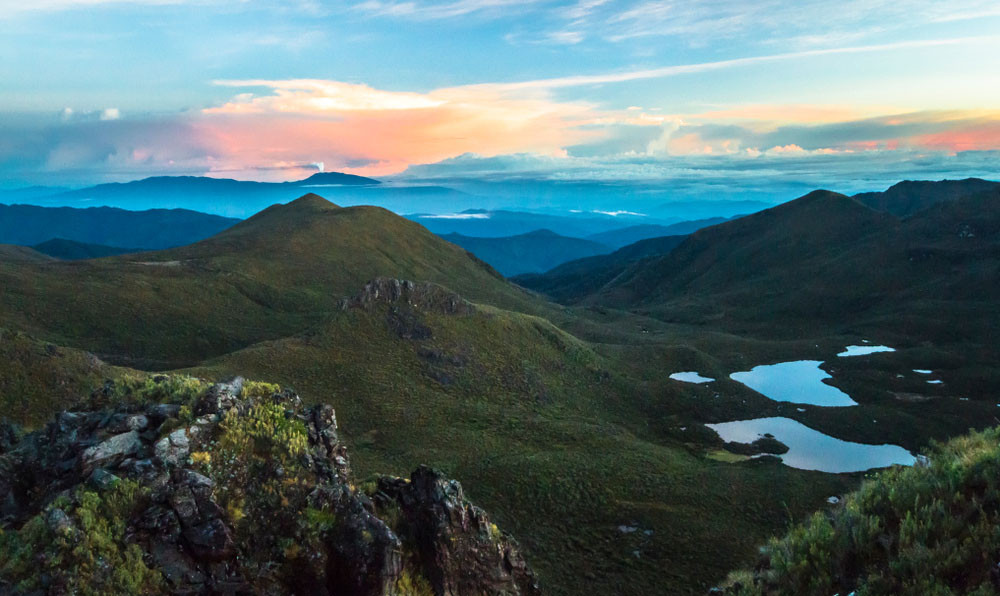
Turrialba Volcano , located in the Cartago province, made headlines in October of 2014 when it woke up after more than a century of near-inactivity and spewed a dark ash cloud across central Costa Rica, distributing travel and closing airports for weeks.
Since then, it’s continued activity has led the authorities to close the park to the public — a loss to nature lovers, but nothing compared to tragedies of lost farms and livelihoods that have been suffered throughout the region. The volcano’s slopes used to be home to potato and cattle farmers alike, who along with avid trekkers suffer nostalgia from when Turrialba was green and vibrant.
Visiting Today: Turrialba is an excellent reminder that active volcanoes are, in fact, active and can at any point come back to life in all their fiery glory. To catch sight of this majestic monster at a distance, visitors can head to the town of La Central, located 6 kilometers from the crater, for views.
Arenal Volcano

Of all of Costa Rica’s volcanos, the one you’ve most likely seen on a postcard or an Instagram post is the picture-perfect Arenal Volcano . Sitting just behind the man-made Lake Arenal and next to the charming town of La Fortuna , this perfect cone is synonymous with adventure travel, suspended bridges, ziplining and hot spring spas.
For a while, Arenal regularly coughed up smoke, ash and blazing streams of molten rock, and volcano lovers would flock to the observatory lodges to watch the gleaming lava against the night sky. Although it has since stopped, that doesn’t make Arenal any less interesting if geology excites you.
Arenal’s last eruption — which wiped out three villages — took place in 1968, but the park system has done an excellent job of conserving the lava flow remains. Take a hike through the 1968 park to see the frozen flows, then head off to one of the many hot springs to soak your sore muscles.
Pro Tip: Leaving La Fortuna in direction of the hot springs, there is a small bridge just past Tabacon . Under the bridge is the natural hot river that feeds the spas, where all of the locals go to relax.
You might like
- Bucket List
27 Heart-Shaped Natural Wonders Around The World
4 amazing cave city destinations on the edge of europe, 5 off the beaten path travel destinations that will blow your mind.

Welcome to the official site of Costa Rica
Welcome to Costa Rica! This beautiful country is known for its stunning beaches, lush rainforests, and incredible wildlife. Whether you’re looking for adventure or relaxation, Costa Rica has something for everyone.
Some of the top attractions include Arenal Volcano, Manuel Antonio National Park, La Paz Waterfalls, Papagayo Peninsula, Tamarindo beach, Rio Celeste, Monteverde Cloud Forest and Corcovado National Park.
You can enjoy activities such as surfing, snorkeling, fishing, ziplining and hiking. Costa Rica is also home to many unique and diverse animal species such as sloths, monkeys, birds, turtles and more. We hope you enjoy your stay!

The Costa Rica Essentials
Essential Costa Rica is about promoting organic ingredients, unspoiled nature and authentic experiences.

Fill your calendar with the most wonderful natural and wildlife events.

Sun and Beaches
Costa Rica occupies a privileged spot with beaches in the Caribbean Sea and the Pacific Ocean.

Costa Rica is a land of volcanoes, rainforests and cloud forests, huge waterfalls and mighty rivers.

If stress is a part of your daily life, Costa Rica is the cure.

Costa Rica has a great place to experience nature’s wonders with your children; the country is a must for families!

Costa Rica is considered one of the most bio-diverse regions in the world.

Costa Rica in English, means rich coast. Every cruise ship visiting Costa Rica understands why.
Costa Rica has a wholesome environment and is an excellent place for families.

The richness of Costa Rica stems from the cultural diversity of its people.

Honeymoon & Weddings
Costa Rica is waiting for you to live this experience.

Where to Go?
Located on the central Pacific coast, the Puntarenas region extends from Punta Conejo south to Puerto Caldera to the mouth of the Bongo River. The region’s rich coastline overlooks small islands, inlets, beaches and beautiful natural wonders. The port town of Puntarenas serves as the center of the region and is home port to a ferry that carries visitors over to the tip of the Nicoya Peninsula.

South Pacific
The combination of breath-taking white-sand beaches, sweeping mountain views and an ideal tropical climate has made Guanacaste one of Costa Rica’s most popular regions. It boasts many of the country’s popular beaches, including Playa del Coco, Playa Flamingo, Playa Conchal and the Papagayo Peninsula. By day visitors can challenge themselves with a surf lesson, cool off under a waterfall at Rincón de la Vieja National Park, discover the craters of an active volcano with the same name and more before enjoying the active nightlife in Tamarindo.

Northern Plains
Recognized as home of Arenal Volcano National Park, which boasts 75% of Costa Rica’s bird population, the Northern Plains present endless activities for visitors. Excursions range from hiking and waterfall rappelling to canopying and exploring via a hanging bridge tour. Those looking for activities on the water will find that Lake Arenal is an ideal location for canoeing, fishing and kite surfing.

Central Valley
Those in search of cultural and natural attractions will find both in the Central Valley region. Home to the destination’s capital city, San José, many of Costa Rica’s most popular museums can be found in this urban setting including the Gold Museum, Jade Museum, National Museum and Children’s Museum, in addition to the architectural jewel of San José, the National Theatre.

Central Pacific
Beautiful beaches, wildlife sanctuaries, lagoons, rivers and waterfalls make the Central Pacific region an ideal destination for visitors in search of variety. The region stretches from the city of Puntarenas to Dominical de Osa and is made up of some of Costa Rica’s most visited areas including Monteverde, Quepos, Jacó, Bahía Ballena and Manuel Antonio. The region’s climate creates a unique landscape that transitions from tropical wet forest to tropical forest to tropical dry forest, providing the opportunity to observe a wide range of plants and animals.

The diverse coastline of the Northern Caribbean region attracts anglers, naturists and water enthusiasts in search of unique experiences. The North Caribbean region is famous for its interconnected canals and for Tortuguero National Park, where visitors have the opportunity to witness green turtles nesting. Limón City, the largest city on the country’s Caribbean coast, is perched in the center of the coast. The Southern Caribbean boasts some great beaches and picturesque parks, which are complemented by the area’s inviting culture.
Planning your Trip to Costa Rica
Suggested itineraries
Accommodations
Restaurants
Other Activities
Local Travel Agencies
Travel Tips

Costa Rica Blog
Latest news and articles about costa rica.

Costa Rica National Parks
Explore our world famous national parks.

Costa Rica's traveler tips
First hand information for your dream vacaction, #essentialcostarica, share your experience, .


Discovering Paradise: The Best Places to Visit in Costa Rica
- Costa Rica hosted 1.7 million tourists in 2019, mostly from the US and Canada.
- This nation boasts five UNESCO World Heritage sites.
- From Manuel Antonio's beaches to Arenal's hot springs, Costa Rica is a melting pot of adventures.
Why Costa Rica Tops Every Traveler’s Bucket List
According to the Costa Rican Tourism Board, over 1.7 million international tourists flocked to this Central American gem in 2019. The majority? Well, our fellow North Americans from the United States and Canada. And it's no wonder why!
Discover the Gems of Costa Rica
What makes Costa Rica a must-visit? Let's dive into some spots Kevin Erickson swears by!
Manuel Antonio National Park
Imagine stepping into a vibrant world where tropical forests melt seamlessly into the Pacific. This is Manuel Antonio National Park, a gem on Costa Rica's Central Pacific coast. Spanning just over 16 square kilometers, it may be one of the country's smallest parks, yet it's undeniably among the most popular — and for good reasons.
As you traverse its well-maintained trails, you're embraced by dense rainforests teeming with diverse flora and fauna. It's a haven for birdwatchers aiming to catch a glimpse of motmots, tanagers, and toucans. But the show-stealers here? Monkeys! Four different species call this park home: the mischievous white-faced capuchins, the laid-back howlers, the elusive squirrel monkeys , and the nocturnal night monkeys.
The park doesn't just cater to wildlife enthusiasts. Beachcombers are in for a treat, too. With its crescent-shaped, white-sand beaches backed by coconut palms, the coastline here is right out of a postcard. Playa Manuel Antonio, with its tranquil waters, is ideal for swimming or simply lounging under the sun. But if you fancy something more secluded, Playa Gemelas and Playa Puerto Escondido, though a bit more of a hike, are worth every step.
With its mesmerizing combination of rich biodiversity, panoramic views, and pristine beaches, Manuel Antonio National Park embodies Costa Rica's pura vida spirit in every way. Whether you're an adventurer, a nature lover , or a relaxation seeker, this national park promises an experience you won't easily forget.
Arenal Volcano
Set against the verdant backdrop of Costa Rica's Northern Plains, the majestic Arenal Volcano stands tall, commanding awe and admiration from all who venture near. This stratovolcano, characterized by its almost symmetrical conical shape, has been one of the country's most active volcanoes, with its most notorious eruption occurring back in 1968. Since then, it's become a beacon for travelers, researchers, and adventure enthusiasts worldwide .
Surrounding the mighty Arenal is a lush rainforest that harbors a rich array of wildlife. From the elusive jaguar and vibrant toucans to the mischievous coatis, nature thrives in this fertile region. It's not just the wildlife that's abundant here; the flora is equally captivating. Giant ferns, orchids , and countless other tropical plants create a vibrant tapestry, making every trek a sensory delight.
But Arenal isn't just about the spectacle above ground. Below the earth's surface, geothermal activity heats up numerous springs, leading to the creation of natural hot springs. These mineral-rich waters , found in luxury resorts and hidden river spots alike, offer the perfect antidote to a day of hiking or adventuring.
As night descends, if you're lucky, you might even witness the orange glow of lava flowing down the volcano's slope or the sky lit up by its fiery eruptions. These natural fireworks have diminished in recent years, but the very possibility adds an element of suspense and thrill to any visit.
With activities ranging from white-water rafting in the nearby rivers, hiking around the lava fields , or simply soaking in a hot spring while gazing up at the imposing silhouette of the volcano, Arenal provides a quintessential Costa Rican experience that blends adventure with nature's tranquility. It's a testament to the raw, untamed beauty that Costa Rica encapsulates.
Monteverde Cloud Forest Reserve
Unlocking hidden secrets.
Kevin Erickson reveals some lesser-known wonders of this paradise:
Tortuguero National Park
Dubbed the "Amazon of Costa Rica", it's where sea turtles take center stage. A nesting spectacle you shouldn't miss!
Rio Celeste
Tucked away in the heart of Tenorio Volcano National Park, Rio Celeste is one of Costa Rica's best-kept natural secrets . This river, translating to " Sky Blue River ," isn't named whimsically. Its waters boast an ethereal, almost surreal, shade of turquoise that looks as though the heavens themselves lent their color to it.
Legend has it that when the gods finished painting the sky, they dipped their brushes into this very river, giving it its celestial hue. But science offers a more grounded explanation: a unique chemical reaction between sulfur and calcium carbonate, which results in the mesmerizing blue tint.
As you embark on the trail that leads to Rio Celeste, every step becomes a sensory experience. The rustling of leaves, the distant call of birds, and the underfoot crunch—all culminate in the breathtaking view of the river, especially at "Los Teñideros," where two clear water streams meet and magically transform into the vivid blue spectacle.
But Rio Celeste isn't just about the river alone. Along its course, there's the magnificent Rio Celeste Waterfall, where the azure waters cascade down with fervor, creating a sight so magical it seems straight out of a fairy tale. Nearby are the hot springs and the "Borbollones" or bubbling spots, where you can witness the earth's raw geothermal power .
For those seeking an experience that's both mystical and grounding, Rio Celeste offers just that. It serves as a powerful reminder of nature's uncanny ability to surprise and enchant, and why places like these deserve our utmost respect and protection.
La Amistad National Park
One of the five UNESCO World Heritage sites, this park is a testament to Costa Rica's commitment to conservation and biodiversity.
The Costa Rican Appeal
The Costa Rican Appeal is best described in a quote from Lonely Planet!
"Costa Rica is a wonderland of natural attractions, with volcanoes, beaches, cloud forests, and unique wildlife. This is a country that appeals as much to birdwatchers and luxury-focused travelers as it does to surfers and backpackers." - Lonely Planet
Which national park is the best in Costa Rica?
It’s subjective, but Manuel Antonio, Arenal, and Corcovado often top the lists!
How safe is it for tourists in Costa Rica?
Costa Rica is generally safe for tourists. Like anywhere, it's wise to take common-sense precautions.
When is the best time to visit Costa Rica?
For lesser crowds and good deals, May to November (rainy season) is ideal. For sunny days, December to April (dry season) is preferred.
What's the primary language in Costa Rica?
Spanish is the official language, but English is widely spoken in tourist areas.
Can I use US dollars in Costa Rica?
Yes, many places accept US dollars, especially in touristy areas. However, it's good to have some Costa Rican colones on hand.
Costa Rica’s allure lies in its diversity - from surfing at Santa Teresa to embracing Afro-Caribbean vibes at Puerto Viejo de Talamanca. It’s an escapade every traveler deserves.
Pack your bags , the pura vida lifestyle awaits!
- Costa Rican Tourism Board
- Lonely Planet
- UNESCO World Heritage Sites List
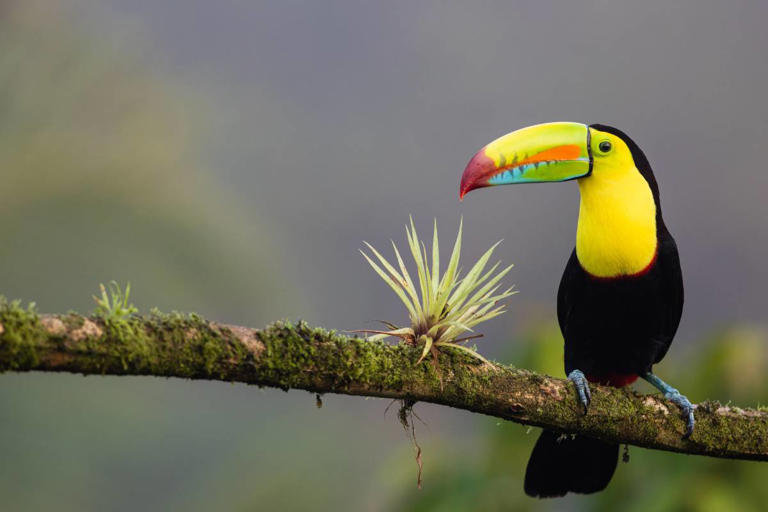
Costa Rica’s Natural Heritage
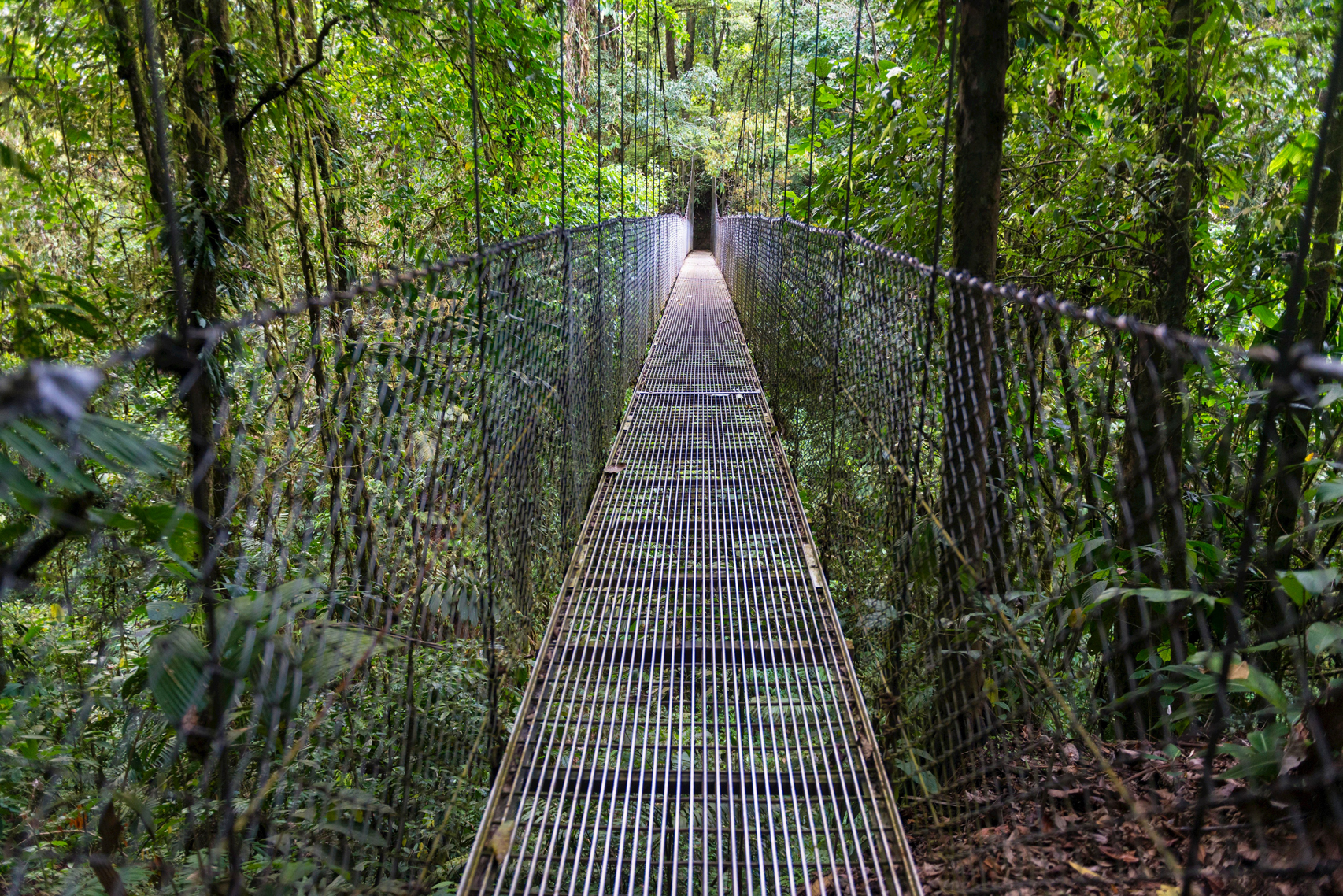
February 15-25, 2025
From $4,781 per person based on double occupancy. (airfare included from select cities.).
In this small, nature-kissed Central American democracy, your small group sets out on a relaxed yet comprehensive 11-day exploration to discover staggering biodiversity in four distinct regions, from cloud forest to rainforest, Central Valley to Pacific Coast. Take an excursion to Irazú Volcano, the country’s tallest volcano, and learn about Costa Rica’s prized export at the Doka Coffee Estate. In Carrizal, admire wondrous orchids. During a three-night Arenal region stay, enjoy magnificent vistas of Arenal Volcano. After meeting students at an elementary school, encounter the natural splendor of the remarkable Ecocentro Danaus Biological Reserve. Experience the rainforest from the canopy level on Arenal’s hanging bridges Sky Walk. Continuing on to the amazing Monteverde Cloud Forest Reserve, explore this “green cathedral.” Spend three final nights at a beautiful Guanacaste beachfront resort, and take an extraordinary Tempisque River float safari.
Discover more ecological wonders with a 4-day/3-night Tortuguero National Park pre-tour option.
Call (615) 322-3673 or contact us to learn more and register.
- Round-trip air transportation from listed cities
- 10 nights’ accommodations in Superior First Class and First Class hotels
- 23 meals: 10 breakfasts, 6 lunches, 7 dinners
- Extensive sightseeing, as described, including all entrance fees
- Services of an expert Costa Rica naturalist as your Odysseys Unlimited Tour Director
- Private motorcoach transportation throughout your trip
- Luggage handling for one bag per person
- Gratuities for dining room servers, airport and hotel porters, and all drivers
- Request More Information
- Trip Brochure
Quick Links
- Upcoming Events
- Update My Information
- Find Alumni
- Skip to primary navigation
- Skip to main content
- Skip to primary sidebar
- Skip to footer

Costa Rica Travel Information
What is Costa Rica Like in January?
April 16, 2024 By Sammi Leave a Comment
January is a fantastic time to visit Costa Rica as Christmas crowds have disappeared, everything is drying up and high season is in full swing. In this post, you’ll learn what January in Costa Rica is like and why it’s a wonderful time to see Costa Rica.
If you’re looking to save some $$ on your trip, check out our Mytanfeet deals page! We partnered with a rental car company, hotels and tour operators to give discounts exclusively for our readers. Click here to enter our deals page.
Costa Rica Quick Facts
- Sunrise and sunset is roughly the same all year round, with a difference of around 15 minutes. Sunrise is generally 6 AM and sunset is 530 PM, dark by 6 PM.
- Costa Rica uses 110 V and drives on the right hand side of the road.
- Local currency is called the colón. Exchange rate ~500 CRC to 1 USD.
- Spanish is the main language.
- Costa Rica is 8-12 degrees from the equator.
January in Costa Rica Weather
First and foremost, the weather . Average day time and night time temperatures do not vary greatly throughout the year in Costa Rica, so temperatures in January won’t be drastically different the rest of the months.
Costa Rica experiences two tropical seasons: dry and rainy. Dry season is generally December through April, rainy is generally May through November. January is the second month of dry season so most of the country is drying up with high temperatures, sunny blue skies and minimal rain.
Since the first month of dry season, December, is more like a transition month, dry season really starts picking up in January and is truly the first dry month in Costa Rica. In January, the northern winds come in, giving a nice, continuous breeze.
Below are short descriptions of weather in January for popular tourist destinations in Costa Rica.
Guanacaste and Nicoya Peninsula
Dry tropical areas such as the Guanacaste coast ( La Cruz , Papagayo Peninsula , Tamarindo , Samara , Nosara ) and Nicoya Peninsula ( Montezuma , Tambor, Santa Teresa ) will see their last hard rains around end of November/beginning of December so don’t expect any rain in January.
By end of January, dry forest covered mountains start turning yellow and bare and humidity levels decrease greatly. Sun is out bright and strong during the day with constant winds, evenings are warm and sultry.

Average day time temperatures are 95 degrees Fahrenheit (35°Celsius) and average night time temperatures are 78 degrees Fahrenheit (26° Celsius).
If you visit the higher elevation areas in the Guanacaste province such as Tilaran, Mirvalles , Nuevo Arenal and around the Bijagua areas, they may still see some rain.
Central Valley
The GAM ( San Jose, Alajuela, Heredia and Cartago ) has lovely weather in January with warm sunny days, fresh air, constant breezes and cozy nights. Average day time temperatures are 80° F (27° C) and average night time temperatures are 65° F (18° C). If you’re up in the high mountains of the Central Valley, expect much cooler temperatures.
La Fortuna sits in the Northern Lowlands, part of the tropical rainforest which has the possibility to still rain randomly. It could be intermittent sprinkles or ten minute downpours in the late afternoons and evenings.

Average day time temperatures are 85 degrees Fahrenheit (29° Celsius) and average night time temperatures are 72° Fahrenheit (22° Celsius). Humidity levels are around 60%.
Jaco, Manuel Antonio
Jaco and Manuel Antonio weather is similar to La Fortuna as this area is also tropical rainforest. The coast does tend to be a tad hotter, so daytime is more around 88° F (31° C) but humidity level are very similar. If it rains, it will be most likely at night and for short bursts. Humidity levels around 60%.
Costa Ballena and Osa Peninsula
These areas, Costa Ballena ( Dominical , Uvita and Ojochal) and Osa Peninsula ( Drake Bay , Matapalo, Carate and Puerto Jimenez) are tropical rainforest areas, so there are possibilities of intermittent rain in January still. Average day time temperatures are 90° F (32° C) and average night time temperatures are 80° F (27° C). Humidity levels around 60%.
Monteverde , the mountain town in the Tilaran Mountain Range experiences high winds, intermittent sprinkles, fresh crisp air and comfortable nights in January. It can still sprinkle but generally for short periods of time and then the bright rainbows come out (hence the nickname, town of rainbows). Average day time temperatures are 72° Fahrenheit (22° Celsius) and average night time temperatures are 60° Fahreinehit (16 C). Low humidity.
Caribbean (Tortuguero, Limon and Puerto Viejo)
The Caribbean coast ( Puerto Viejo de Talamanca , Limon and Tortuguero ) tends to follow a different weather pattern than the rest of Costa Rica. January can still have some days of hard rain, so you may run into storms and wet days. Average day time temperatures are 90° F (32° F) and average night time temperatures are 75° F (24° C). Humidity levels around 60%.
Prices in January in Costa Rica
As January is the start of the normal high tourism season, prices are high but not as high as peak season. Peak season is the week of Christmas and New Years, where hotel nights on December 24-31st are easily twice as much as normal times and can have a 3 night minimum. But after the first few days of January, prices go back down to normal high season prices.
Airfare usually goes down after the first week of January. I have found relatively cheap flights from Seattle to Costa Rica mid to end of January (~$500 USD basic economy).
Crowds in January in Costa Rica
The first week of January is generally still very busy due to lingering Christmas and New Years crowds. By the second week of January, it will have gone back to normal high season crowds.
January is the second month of the Costa Rica schools’ summer vacation so there will be lots of families on vacation. Weekends are generally very busy at popular national parks and beaches, with local families enjoying their days off. Purchase your national park tickets early if required, such as Tenorio Volcano National Park and Manuel Antonio National Park.
Best Things to Do in January in Costa Rica
January is a great month to experience all Costa Rica has to offer in terms of culture, nature, adventure and wildlife. Here are some of the best things to do in January in Costa Rica.
The surf in January is fairly consistent. The Pacific Northwest coast (Guanacaste) picks up NW swells so beaches like Tamarindo , Playa Langosta , Playa Grande, Playa Negra and Playa Avellanas have days where the waves are firing. The famous Witch’s Rock (Roca Bruja) can have good waves when there is a north swell, otherwise it’s generally small in January. For the highly experienced, big wave chaser, the Caribbean coast spot Salsa Brava can boast some of the heaviest barrels and reef breaks.

Water temperature is nice and warm, in the high 70s to low 80s F ( 25-28°C).
If you’re not into surfing, no worries! Try to visit many beaches as it’s one of the best things to do in January in Costa Rica. Take a walk, watch the sunset, play in the waters, boogie board and get your tan on (safely, because the sun is strong so make sure to apply and reapply reef safe sunscreen).
January is a great time to visit national parks and private reserves for a hike or two thanks to the drier weather. Landscapes are still somewhat green in dry tropical forests from the last rains so it doesn’t look too arid and desert like.
Great options are Rincon de la Vieja National Park , Barra Honda National Park , Carara National Park , Manuel Antonio National Park and Corcovado National Park . Make sure to bring good sun protection like a hat, sunglasses and sunscreen, mosquito repellent and an insulated water bottle to have cold water.
White Water Rafting
As rivers will still be full from the rainy season, white water rafting is very good in January. Raft down pristine rivers like Pacuare River Class 3, 4 and 4+ rapids, Sarapiqui River Class 3 and 4, Savegre River Class 2 and 3 and Tenorio River Class 3 and 4.
January is the start and end of several wildlife seasons in Costa Rica. First, January is a bit after the start of the Northern Hemisphere humpback whale season in Costa Rica. If you’re in the Central or South Pacific, you can take a whale watching tour from Uvita for good chances to see humpback whales and dolphins.
Second, January is the end of the arribadas , or mass nesting of Olive Ridley sea turtles on Playa Ostional in Ostional Wildlife Refuge . The arribada in January has diminished considerably compared to the previous months, but there are still chances to see nesting mothers and baby turtles hatching. For leatherback turtles, January is the start of their nesting season in Marino Las Baulas National Park (sadly their numbers have decreased greatly and it’s not super common to see them anymore).
Water clarity in January greatly improves due to the disappearance of torrential rains, run off and storms. Snorkeling and scuba diving are great, with an abundance of colorful tropical fish and other marine life like turtles, rays and sharks to be seen. Snorkeling at Tortuga Island , Isla Caño Reserve , Gulf of Papagayo and Catalinas Islands are wonderful.

As January is winter up north, the migrating birds will be in Costa Rica. It’s a fantastic time to see these million mile fliers as well as other river birds. Caño Negro Wildlife Refuge and Palo Verde National Park are two excellent places for safari boat rides to see birds and other wildlife.
Interested in booking tours like the Ca ñ o Negro Wildlife Refuge, Tortuga Island cruise or other activities? Check out our Costa Rica deals and discounts to save some $$ on your excursions.
Local Festivals and Parties
Costa Ricans like to party and they do by throwing fiestas civicas which are the local parties. Nearly all towns, especially in rural areas, have local parties and it’s a really fun way to immerse yourself into Costa Rican culture.
Local parties normally have the typical party activities: street food, rides and games. Costa Rican local parties also have bull riding. They do not partake in bullfights like Mexico or Spain, rather they let a bull loose in a stadium and everyone runs around from it. They’ll do gimmicks like tying money to the bull horns and everyone will try to grab it. They also do bull riding and they’ll have competitions.
Another aspect of local parties are the topes which are the horse parades. This is very common in the Guanacaste province as this is the land of the Costa Rican cowboys. Hundreds of local dress up in cowboy flair and parade around their best horses. To cool off during the hot day, they drink lots of ice cold Costa Rican beer.
Notable Festivals and Days in January in Costa Rica
New Years Day: Generally outside with family, enjoying the last days before going back to work. Or nursing the hangover from the countdown the night before.
Palmares: The local parties of the town of Palmares are famous and are the biggest in the country, attracting nearly 1 million visitors (out of a total country population of 5.2 million). They happen every second Friday in January for around 10 days.
Santa Cruz: Known as the town of folklore, local parties in Santa Cruz get more popular year after year. You’ll see the proud Guanacasteco cowboys of all ages braving the bulls, showing off their steeds and throwing back Chiliguaro shots like there’s no tomorrow.
Alajuelita January 15: This religious festival pays homage to the Black Christ of Esquipulas. This pilgrimage is very important to dedicated Catholics as Catholicism is the main religion of Costa Rica.
Other Things to Know About January in Costa Rica
- Road conditions are usually not great during this month after they have suffered through several months of rain and storms. Although some remote/rural places may only need a sedan or high clearance car in dry season, check with your host if a 4wd will be required/recommended instead due to the worsened road condition. Check our renting a car in Costa Rica tips and get our Costa Rica car rental discount here!
- Waterfalls are still very full so it’s a great time to do a waterfall tour. However, some places in the tropical rainforest that may still rain in January, may still have lots of run off and be a murky brown color. For example, Rio Celeste Waterfall in Tenorio Volcano National Park may be more green/brown than the beautiful sky blue color if it has been raining as that area can still rain in January.
- It is generally quite windy in January so it may not be the best time for a catamaran or sailing tour if you are prone to seasickness. Afternoons are normally windier than mornings. If it is too windy, activities like ziplining may be cancelled due to safety concerns.
- January is not the cheapest time to travel in Costa Rica but it is the most lively. Everything is open, everyone is excited for the high tourism season once more and it is easy to find tours to join if you’re a solo traveler.
January is excellent time to visit Costa Rica for fun, festivities, adventure, relaxation and an escape from the start of the Northern Hemisphere winters. Soak up all the sun in Costa Rica you need to make it through the rest of the winter days back home.
What to Pack for Your January Vacation in Costa Rica
Essentials: Valid passport, valid drivers license if you plan to rent a car, credit card with no foreign transaction fee, travel insurance , medicines
Must brings: Sunscreen (SPF 30 and higher), after sun gel, mosquito repellent, insulated water bottle, microfiber towel, reusable shopping bags, hair ties, swimsuits, sandals, sunglasses, hat, small first aid kit, light weight water proof rain jacket if visiting rain forest areas, dry fast, sweat wicking clothes and closed toed shoes for activities.
Get our full Costa Rica packing list here.
Itineraries
Ready to plan your trip to Costa Rica in January? Check out our recommended itineraries which will be great for January!
8 Days Itinerary: Playas del Coco and La Fortuna. Fly in/out of LIR Airport.
Tamarindo 5 Days
11 Days Itinerary : La Fortuna, Monteverde and Manuel Antonio
14 Days Itinerary : La Fortuna, Monteverde, Santa Teresa and Playas del Coco
Other Months
Click the links below to see what Costa Rica in other months are like.
Costa Rica Vacation Checklist
- First time to Costa Rica? Read our First Time in Costa Rica guide.
- Not sure how to move around Costa Rica? Read our How to Get Around Costa Rica guide to find the best transportation method for you.
- Click the link to get our detailed Costa Rica Packing List so you know what essential items to bring.
- Do not forget to purchase Travel Insurance for your trip to Costa Rica.
- Stay connected by purchasing a prepaid SIM Card in Costa Rica. Get 10% off your Airalo eSIM package with our promo code “mytanfeet”
- Save money with Mytanfeet Deals for tours and hotels. Save more money with our Costa Rica Car Rental Discount.
Join our mailing list and get our free Costa Rica eBook!
Reader Interactions
Leave a reply cancel reply.
Your email address will not be published. Required fields are marked *
Exclusive deals
First-timer’s guide to Hawaiʻi Volcanoes National Park

Apr 18, 2024 • 11 min read
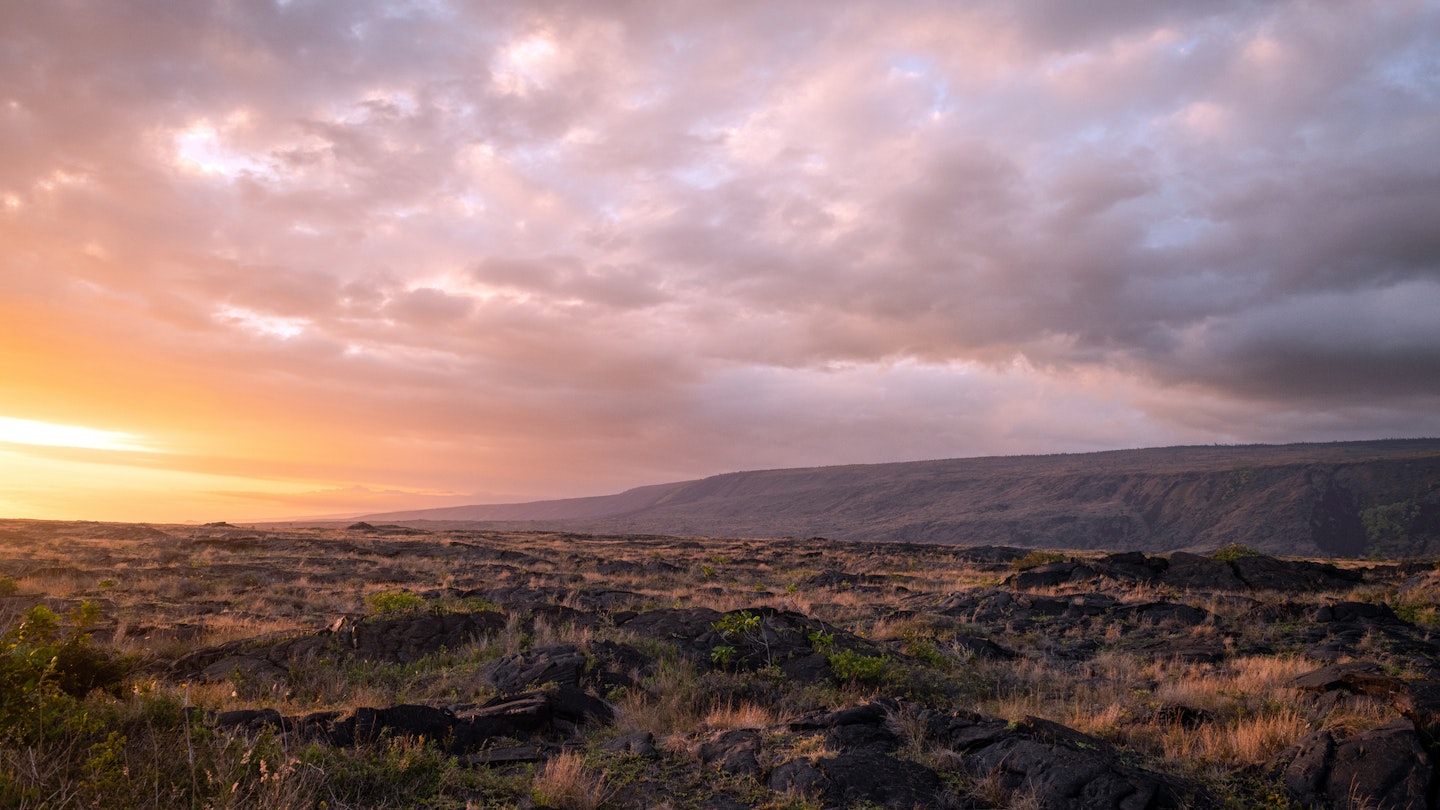
The scale and ferocity of Hawaiʻi Volcanoes National Park is a wonder to experience © Yiming Chen / Getty Images
Unsurprisingly, Hawaiʻi Volcanoes National Park on Hawaiʻi Island is one of the state’s most popular attractions.
This incredible landscape is home to two massive volcanoes – Kīlauea being one of the world’s most active – and stretches from sea level to the summit of Mauna Loa, one of the world’s largest. Sprawling across 333,259 acres on the island's southeastern side, the park is one of the most dynamic and diverse in the US.
Its ever-changing landscape boasts an assortment of terrain, from lush rainforests and barren lava fields to a volcano often dusted with snow every winter. Yes, even in Hawaiʻi!
So grab those hiking boots and binoculars and use our insider guide to get the most out of your first trip to this unique national park.
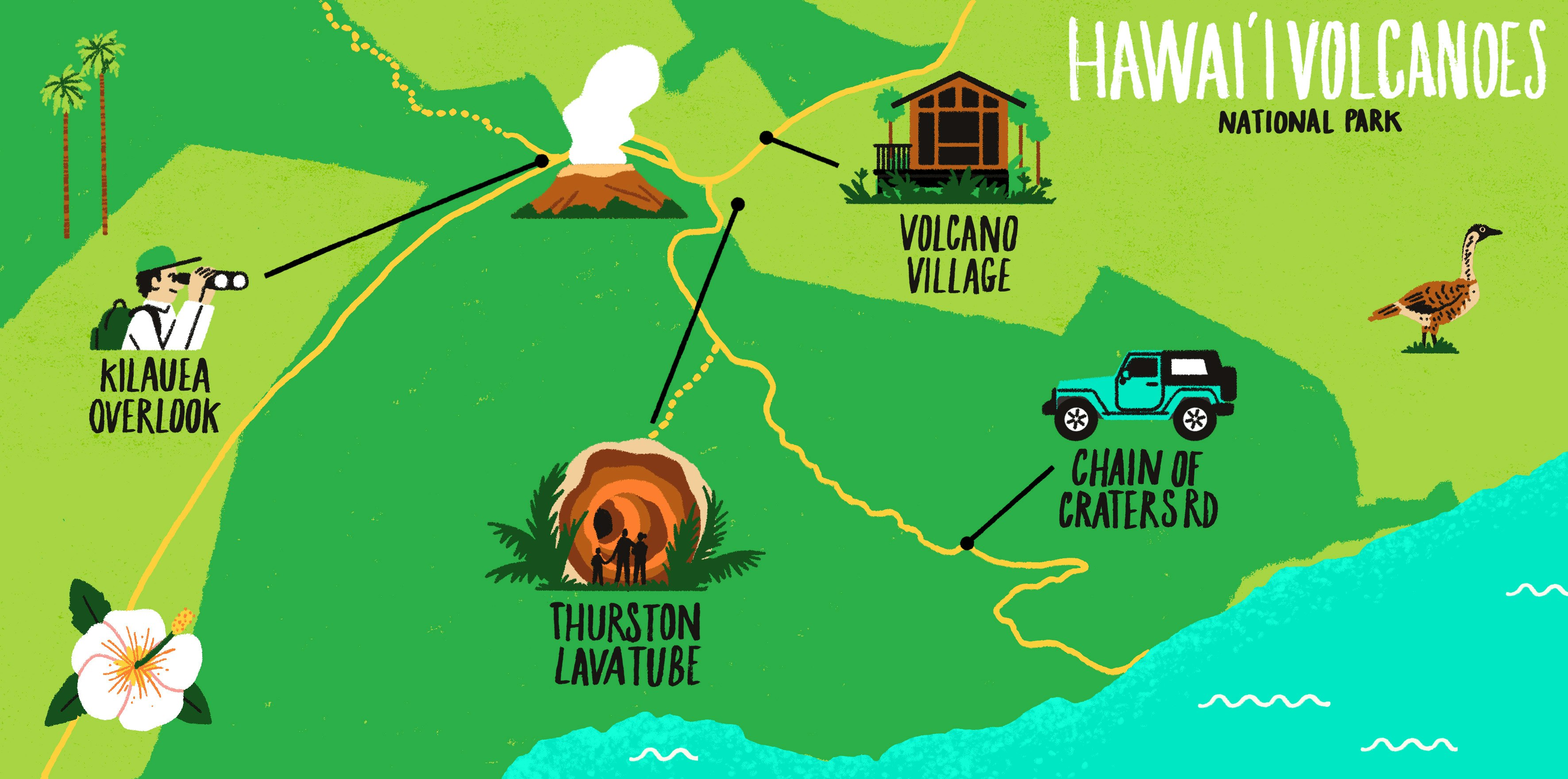
When is the best time to visit Hawai‘i Volcanoes National Park?
There isn’t an especially bad time to visit the park, which sees nearly two million visitors annually. The weather on the Islands doesn’t vary much, with temperatures fluctuating between 66-85°F throughout the year. Winter and early spring, though, tend to be rainier and cooler than other times of the year and hurricane season runs from June to November, which can mean tropical storms, whipping winds and torrential rain.
The busiest travel seasons in Hawaiʻi are summer and winter – summer is peak vacation time for families and winter lures travelers eager to escape colder climes. Expect more people on trails and longer waits for parking during these periods.
Spring and fall are slower travel months and ideal times to visit the park. Trekking conditions are much more comfortable without the intense summer heat and you’ll likely find better airfare prices and hotel rates at nearby hotels. The park does get a surge of visitors during spring break and around the weekend of the annual Merrie Monarch Festival , a week-long hula competition based in Hilo around late March or early April.
Tuesday is the busiest day at the park – pick another day if at all possible. This is when the Pride of America , a cruise ship that sails around the Islands, docks in Hilo. Many of its 2000 passengers head to the national park, hitting popular stops like the Kīlauea Visitor Center , the Kīlauea Iki Trail , and Nāhuku (otherwise known as Thurston Lava Tube ). Winter brings yet more cruise ships to Hawaiʻi Island as thousands of North Pacific humpback whales migrate annually from Alaska to the warmer waters surrounding the Islands.
Though Kīlauea stopped erupting on Sept 16, 2023, the volcano still attracts visitors despite no visible lava fountains or flows. And it’s likely it will erupt again – the Puʻuʻōʻō eruption, which began in 1983 and lasted 35 years, ranks as the longest and most voluminous known outpouring of lava from Kīlauea’s east rift zone in more than 500 years. “If there is an eruption,” says Jessica Ferracane, the park’s spokesperson, “it is busy all day, every day, especially if it’s at the summit of Kīlauea.”
Planning tip: The park is currently undergoing a big disaster recovery project following the 2018 Kīlauea eruption and summit collapse. There could be temporary area closures, lane closures, reduced parking and other limited services for the next two years. Check the park website to check for construction closures and delays .
Find out everything you need to know about what's happening in Hawaii throughout the year in our guide to the best time to visit the Aloha State
How much time should I plan to spend at the park?
Hawaiʻi Volcanoes National Park may not be as huge as Alaska’s 13.2-million-acre Wrangell-St. Elias National Park & Preserve – larger than Yellowstone National Park, Yosemite National Park and Switzerland combined – but it does stretch from sea level to the summit of 13,681-ft Mauna Loa and across seven different ecological zones. You’ll need at least a full day to explore all the best parts of the park but two days are even better.
Park staff recommend that visitors arrive by sunrise to hit the park’s most popular trails first – it's open 24 hours to allow everyone to maximize their time. Dusk is also a wonderful time to go exploring – the lack of light pollution provides dark skies that are perfect for stargazing.
There are a variety of hikes within the national park, from the easy 1.2-mile Kīpukapuaulu Trail to the challenging backcountry treks up Mauna Loa that can take two days. And having an extra day means you can visit the park’s quieter and less crowded Kahuku Unit on the southerly slopes of Mauna Loa. This 116,000-acre former ranchland is about an hour's drive from the Kīlauea Visitor Center and is open to the public five days a week. You can hike to the top of an old cinder cone, trek through a pristine Hawaiian rainforest or bike through scenic pastures with panoramic views of the ranchlands.
The tiny town of Volcano Village just outside the park is also well worth a visit, with its laid-back eateries and food trucks, art galleries, and a vineyard and winery .
Is it easy to get in and around the park?
The nearest airport is Hilo International, about 30 miles northeast of the park (you can fly into the Ellison Onizuka Kona International Airport at Keāhole, but the drive from Kailua-Kona will take about two hours). Getting to the park from Hilo is easy – take Route 11 (Hawaiʻi Belt Road) west until you reach the main entrance. The drive takes about 45 minutes.
Hele-On Bus is the island’s only public bus service, operated by Hawaiʻi County. The No. 11 Red Line runs between Hilo and Hawaiʻi Volcanoes National Park, stopping daily at the Kīlauea Visitor Center. The bus schedule is subject to change, so check ahead. There is no public transportation or shuttle service within the park, so you’ll need a car to get around.

Top things to do at Hawaiʻi Volcanoes National Park
Kīlauea iki trail.
One of the most popular hikes in Hawaiʻi Volcanoes National Park is the 4-mile roundtrip Kīlauea Iki Trail. The terrain is varied – it starts in a forest of native ʻōhiʻa trees and hapuʻu (Hawaiian tree fern) and ends with a walk across an otherworldly crater floor – and it’s short enough to complete in a few hours, giving you plenty of time to visit other parts of the park.
The trailhead is at an overlook of the crater formed from an eruption in 1959 that was marked by fountaining lava over a half-mile long and a plume reaching a world-record 1900ft high. The first part of the trail is a descent through a lush rainforest lined with native ʻōhiʻa and koa trees. Look for the white-rumped ʻapapanae , a nectarivorous Hawaiian honeycreeper, often found flitting from tree to tree. The switchbacks end at the crater floor, a vast moonscape that sharply contrasts with the surrounding native forests.
This lava tube – also known as Thurston Lava Tube – was created by a river of 2000°F (1093°C) molten lava about 500 years ago. Discovered in 1913, this massive lava cave is very accessible, with a flat rock floor and ceiling height of more than 20ft in places. Electric lights illuminate most of the path, though you may want to bring a flashlight – it takes about 20 minutes to stroll through the tube. The rainforest that surrounds Nāhuku is brimming with native birds, including the scarlet ʻiʻiwi , a Hawaiian honeycreeper listed as threatened under the Endangered Species Act.
Hōlei Sea Arch
At the end of the Chain of Craters Road – about 18 miles from the Kīlauea Visitor Center – is the Hōlei Sea Arch , a 90-ft-tall rock formation cut into the cliff of an ancient lava flow about 550 years ago. In 2020, the park opened a new viewing area about 1000ft past the gate at the end of the road and set back away from the cliff edge.
Puʻuloa Petroglyphs
There’s an area of Pānau Nui on the southern flank of Kīlauea with numerous pecked images, or petroglyphs, in the hardened lava. Puʻuloa, which translates to “long hill” in ʻōlelo Hawaiʻi (the Hawaiian language), is a sacred place to Native Hawaiians. The archaeological site here boasts more than 23,000 petroglyphs – the largest collection in Hawaiʻi – with motifs of circles, canoe sails, human forms, feathered capes and other geometric shapes.
Devastation Trail
This half-mile hike is suitable for everyone as it's wheelchair and stroller accessible. The paved path meanders through a stark yet beautiful landscape buried by falling cinder from lava fountains of the 1959 Kīlauea Iki eruption. You might find volcanic debris in the form of glass-like droplets and strands called Pele’s Tears and Pele’s Hair, respectively, named after the revered Hawaiian goddess of fire and volcanoes. Nēnē (Hawaiian geese) frequent this area; refrain from feeding or interacting with this threatened species.

My favorite thing to do at Hawaiʻi Volcanoes National Park
Unfortunately, there aren’t many places in Hawaiʻi where you find native forest birds anymore. Their populations have plummeted due to habitat destruction, predators like feral cats, mongoose and non-native mosquitoes that spread avian pox and avian malaria.
But at Hawaiʻi Volcanoes National Park, where native habitats are protected and able to thrive, you can see – and hear – a variety of these special birds, from the friendly ʻelepaio (Hawaiian flycatcher) to the elusive ʻōmaʻo (Hawaiian thrush), which can only be found in the montane rainforests on Hawaiʻi Island. The bright orange ʻākepa , an endangered Hawaiian honeycreeper with an odd-shaped beak, can be spotted in the high-elevation forests of the park’s Kahuku Unit. And if you’re lucky, you might catch a glimpse of the endemic ʻio , the only hawk species native to Hawaiʻi.
I love wandering along the 1.2-mile Kīpukapuaulu Trail, an easy loop through pristine native forestland in an area known as a “bird park.” A kīpuka is an area of land that’s surrounded by younger lava flows, like an “island” within a sea of lava. There are more native tree species per acre here than any other forest in the national park, which means you’ll find native forest birds that rely on the native trees that grow here.
How much money do I need?
Park entry costs $30 for a private car, $25 for a motorcycle, and $15 for pedestrians and cyclists. The park has gone cashless, so payment has to be made with debit or credit cards in person or online .
If you're also planning to visit Puʻuhonua o Hōnaunau National Historical Park near Kailua-Kona or Haleakalā National Park on Maui, consider buying the Hawaiʻi Tri-Park Annual Pass for $55. This allows you to enter all three of these parks in a single, private vehicle.
The National Park Service offers free admission to everyone on the following days: Martin Luther King Jr. Day, the first day of National Park Week in April, Juneteenth, the Great American Outdoors Act, National Public Lands Day and Veterans Day.
Average costs at Hawaiʻi Volcanoes National Park
- Basic room for two at Volcano House: $80 to $385 per night
- Airbnb in Volcano: $150 average per night
- Cup of coffee: $3.50
- Midrange meal: $15-$20 per person
- Local beer: $10
- Gas (regular) in Hilo: $4.81 per gallon

How to travel in the park consciously
With two active volcanoes and ongoing construction to repair damage caused by the 2018 Kīlauea eruption, it’s important to stay on marked trails and overlooks and keep out of closed areas. And no matter what you may have seen on social media, please leave the rocks alone and unstacked. Park staff often use ahu (stacked rocks) to mark trails; it’s not an invitation to do the same. Not only is it culturally insensitive but it can be disorienting to hikers who rely on the ahu to guide them along trails. It’s also long believed that taking lava rocks brings bad luck. Hundreds of people return rocks they’ve taken from the park every year.
There are many culturally significant sites within the park, itself a Unesco World Heritage Site. These include petroglyphs, historic trails, fossilized footprints, shelter caves, heiau (Hawaiian temples) and stone walls of canoe sheds and corrals. Many of these sites are listed in the National Register of Historic Places – please be respectful when you get the chance to see them close up.
The land within the park is sacred to Native Hawaiians, with moʻolelo (stories) and mele (songs) tied to this area. They believe Pele, the Hawaiian goddess of fire and volcanoes, lives in Halemaʻumaʻu Crater at the summit of Kīlauea. If you come across Native Hawaiians performing cultural rituals in the park, keep a respectful distance. Let them – and others – connect undisturbed with nature.
This article was first published September 2021 and updated April 2024
Explore related stories
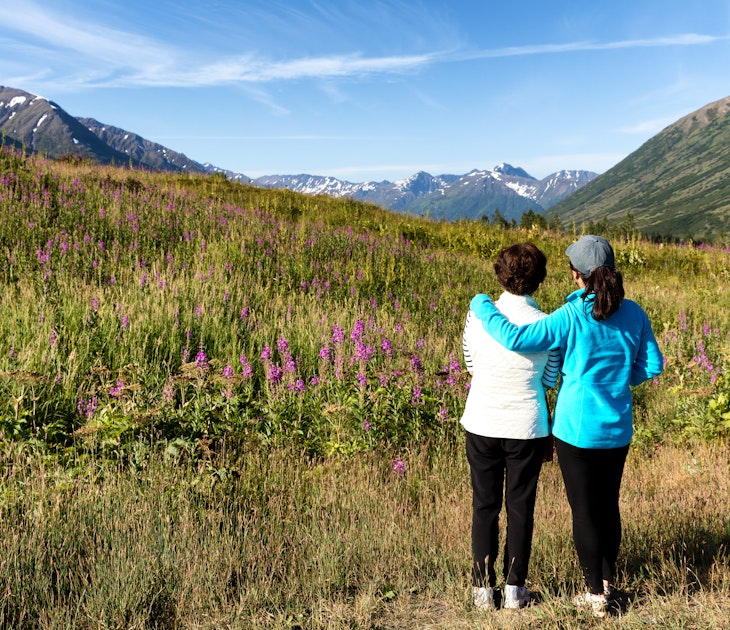
Festivals & Events
Mar 29, 2024 • 5 min read
From freezing darkness and empty ski slopes to endless sunshine and cruise crowds, each Alaskan season has its pros and cons. Find your perfect time to go.

Mar 25, 2024 • 8 min read
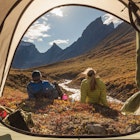
Mar 24, 2024 • 7 min read

Mar 19, 2024 • 5 min read

Mar 5, 2024 • 12 min read

Feb 2, 2024 • 6 min read

Dec 27, 2023 • 8 min read

Dec 1, 2023 • 6 min read

Oct 4, 2023 • 9 min read

Aug 3, 2023 • 7 min read
Watch hammerhead sharks swim in 'cyclones' around ancient volcano in rare footage
Filmmakers have captured hundreds of hammerhead sharks circling a volcanic island off Costa Rica for a new Netflix wildlife series.
Hundreds of hammerhead sharks gather around an ancient volcano in the Pacific Ocean, drawn by secret signals radiating from the seabed, a new clip reveals.
The footage, which features in the third episode of Netflix's new wildlife documentary series "Our Living World," shows a school of hammerhead sharks ( Sphyrnidae ) circling Cocos Island — a volcanic island in the eastern tropical Pacific about 310 miles (500 kilometers) southwest of mainland Costa Rica.
Cocos Island is a known haven for endangered hammerhead sharks, but scientists still aren't sure how and why so many sharks navigate across swathes of ocean to convene there every year.

"We don't really know how these sharks are doing this," Ben Roy, the series producer of Our Living World, told Live Science. "We know that they've got sensors in their heads and we know that these sensors pick up on the magnetic signature of these cool volcanic rocks."
The island formed when lava erupted from an ancient underwater volcano and solidified, until it eventually rose 12,000 feet (3,660 meters) above the seabed.
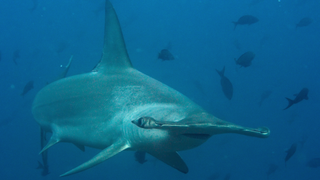
For the episode, film crews followed a young female hammerhead shark as she left her coastal nursery and traveled 300 miles (480 km) across the Pacific Ocean to the volcanic oasis, where scientists think the sharks assemble to relax, socialize and find a mate. The female instinctively knew the way to Cocos Island thanks to electromagnetic signals emanating from hardened volcanic rocks on the island's slopes.
Related: Watch great white shark get mobbed by gang of seals in 'incredible and surprising' footage
Sign up for the Live Science daily newsletter now
Get the world’s most fascinating discoveries delivered straight to your inbox.
In the clip, the young female joins hundreds of other hammerhead sharks as they form a vortex around the island. At "the actual moment when all those hammerheads aggregate and start to swim in those cyclones," Roy said his team "got lucky with some cracking behavior."
This isn't the first time sharks have been seen mysteriously congregating. Scientists previously documented a hammerhead shark gathering in the tropical waters of French Polynesia, in the South Pacific Ocean, but that assembly attracted only females.
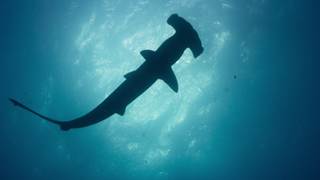
Our Living World
The hammerhead shark gathering is just one astonishing scene among many featured in the four-part nature series, which premieres Wednesday (April 17) on Netflix. The show highlights the intricate links that support the huge web of life on Earth, from the invisible fungal networks that nourish forest ecosystems to transatlantic clouds of nutrients that blow from Africa to South America and rain down on the Amazon.
— Watch a great white shark devour a seal off the coast of Cape Cod, shocking nearby whale watchers
— 'One of the holy grails of shark science': Watch 1st ever footage of baby great white shark moments after birth
— Watch 2 megamouth sharks caught on video for the 1st time ever
"The links are what makes this series totally different to anything I've been involved with or seen in terms of wildlife nature shows on the TV, because what we've tried to do is tell a story that shows how individual animal lives and animal behaviors are connected to a much bigger picture," Roy said.
In telling these stories, "we were really looking for the wow," Roy said. "We are potentially the first generation to be able to fully grasp the connectivity of what's going on here and potentially the last generation to be able to put that knowledge to good use."
The hammerhead shark assembly footage fulfills every expectation Roy had for the show, he said. "Talking about those 'wow' revelations — for me that was one of them," he said. "Sharks need volcanoes? Who knew!"

Sascha is a U.K.-based trainee staff writer at Live Science. She holds a bachelor’s degree in biology from the University of Southampton in England and a master’s degree in science communication from Imperial College London. Her work has appeared in The Guardian and the health website Zoe. Besides writing, she enjoys playing tennis, bread-making and browsing second-hand shops for hidden gems.
There's 5 times as many bull sharks off Alabama now — but don't worry about shark bites
Elusive prickly sharks spotted gathering at underwater mountain off Panama — but why remains a mystery
Scientists are one step closer to knowing the mass of ghostly neutrinos — possibly paving the way to new physics
Most Popular
- 2 'Gambling with your life': Experts weigh in on dangers of the Wim Hof method
- 3 'Exceptional' prosthesis of gold, silver and wool helped 18th-century man live with cleft palate
- 4 NASA spacecraft snaps mysterious 'surfboard' orbiting the moon. What is it?
- 5 AI pinpoints where psychosis originates in the brain
- 2 NASA's downed Ingenuity helicopter has a 'last gift' for humanity — but we'll have to go to Mars to get it
- 3 2,500-year-old skeletons with legs chopped off may be elites who received 'cruel' punishment in ancient China
- 4 Modern Japanese people arose from 3 ancestral groups, 1 of them unknown, DNA study suggests
- 5 The universe may be dominated by particles that break causality and move faster than light, new paper suggests
News from the Columbia Climate School
Columbia Beautiful Planet 2024
Tara Spinelli
Every year, the Climate School honors Earth Day by sharing images that celebrate the beauty and magic of our planet as captured by the Columbia community. A few highlights from this year’s selection include the towering Annapurna mountain range in Nepal; a Red eft in the lower Hudson Valley, New York; the spectacular Grey Glacier in Torres del Paine National Park, Chile; and an “exploding” lake in Costa Rica’s Poás Volcano.
Please enjoy our Columbia Beautiful Planet selections and visit our Earth Day website for more on this year’s theme, Planet Vs. Plastics.

Related Posts

Army Veteran and Environmental Advocate: A Sustainability Science Student’s Journey to Columbia

In New Jersey’s Ancient Rocks, Hunting for Clues to an Earthquake in 2024

Plugging the Leak on Laundry Pollution

Celebrate over 50 years of Earth Day with us all month long! Visit our Earth Day website for ideas, resources, and inspiration.
Get the Columbia Climate School Newsletter →

IMAGES
VIDEO
COMMENTS
Group & solo packages include expert-led activities, lodging, meals, & educational tours. Discover white-sand beaches, dense tropical rainforests, volcanic peaks, & cloud forests
Discover lush rainforests, breathtaking coastlines, and vibrant wildlife. Dive into the heart of Costa Rica's natural wonders!
There are five active volcanoes in Costa Rica: Turrialba Volcano, Poas Volcano, Arenal Volcano, Rincon de la Vieja Volcano, and Irazu Volcano. To be categorized as active, volcanoes must have erupted in the last 10,000 years. Why does Costa Rica have so many volcanoes?
The Rincon de la Vieja Volcano is 1,916 meters (6,286 feet) tall and is one of the most-visited volcanoes in Costa Rica. It is located within the Rincon de la Vieja National Park, an hour's drive from the city of Liberia in the province of Guanacaste.This national park is interestingly also home to another volcano, the dormant Santa Maria Volcano.
Costa Rica's volcanoes are astounding! Furthermore, they are easily accessible, making it practical to travel to these steamy giants. Amazing Volcanoes to Explore. Poas, Irazu, Turrialba, Rincon de la Vieja, and Arenal are the most beloved volcanoes in Costa Rica. Arenal is currently dormant but still a magnificent sight to behold and one of ...
Written by Nikki Solano. Nikki is the CEO of Pura Vida! eh?Inc. (Costa Rica Discounts), and the author of the guidebooks Moon Costa Rica (2019, 2021, 2023, and 2025 editions) and Moon Best of Costa Rica (2022 edition) from Moon Travel Guides.Together with her Costa Rican husband, Ricky, she operates the Costa Rica Travel Blog, created the online community DIY Costa Rica, built the Costa Rica ...
Further south in Guanacaste lies the iconic Arenal Volcano, towering at an elevation of 1,657 meters and historically one of the most active volcanoes in Costa Rica. Although its eruptive phase has paused since 2010, Arenal's symmetrical cone shape still dominates the local skyline, offering a majestic backdrop to the surrounding rainforest ...
Best Volcanoes to Visit in Costa Rica. 1. Arenal Volcano. Arenal is the most famous volcano in Costa Rica. That's because, between 1968 and 2010, it ejected a steady stream of lava and hot rocks. This delighted visitors, who watched the glowing eruptions safely from afar, then relaxed in natural hot springs nearby.
The 5 active volcanos in Costa Rica. In Costa Rica, a volcano is considered active if it has erupted in the last 10,000 years. Currently, there are 5 active volcanos in Costa Rica, and they're popular for their steaming craters and sometimes lava flows. The big names here are Arenal, Poás, Rincón de la Vieja, Irazú, and Turrialba, which ...
Drive up Crater. At times Costa Rica has had three drive up volcanoes. Currently Poás and Irazú are open. Visits to Irazú tripled in 2017 after the closure of Poás and Turrialba. Although the colossus dominates the eastern skyline and appears close enough to touch from downtown San José it takes over an hour and a half to wind up the paved ...
Arenal. Arenal Volcano is probably the most renowned volcano in Costa Rica because of its multiple eruptions between 1968 and 2010. It is located 3 hours from San Jose and stands at 5,436 ft (1,657 m). It is illegal to climb to the top of Arenal, but many people still make the 10 to 11-hour hike.
The 7 Best Volcanoes to See in Costa Rica. 1. Irazu Volcano. Volcan Irazu, or simply Irazu, is an active volcano located on the Cordillera mountain range in central Costa Rica, near the city of Cartago. Its name is thought to have been a combination of "ara", or point, and "tzu", or thunder. Others believe the name came from an ...
The iconic Arenal Volcano is located in the northwestern part of Costa Rica, towering beautifully over the town La Fortuna. The most well-known active volcano in Costa Rica is surrounded by the Arenal Volcano National Park and Lake Arenal. The Arenal Volcano is still considered active, but there hasn't been an eruption since 2010.
Discover Arenal Getting a clear of view Arenal is like hitting the jackpot. La Fortuna is a town of just 15,000 people located north of Costa Rica's capital of San José, in the central lowlands.Yet some 1.5 million people visit it every year. That means this little hamlet is perpetually bursting at the seams with visitors eager to witness the most famous volcano in a country with no shortage ...
The volcanoes of Costa Rica can be divided into 3 volcanic range systems. The Guanacaste Range is home to the Ricon de la Vieja, Orosi Volcano, Miravalles Volcano, Tenorio Volcano & Arenal Volcano. The Central Volcanic Range is made up of the Poás Volcano, Barva Volcano, Irazú Volcano, & Turrialba Volcano.
Arenal Volcano Experience Full-Day Tour from San Jose. ⭐️ RATING: 5/5 | ⏳ LENGTH: 14 hours | Book it! Costa Rica is known for its national parks and lush natural resources. In this full-day tour, you explore the Arenal Volcano region effortlessly, departing from San Jose and taking scenic routes.
Poas Volcano National Park. Boasting one of the world's most intense volcano craters, Poas is a sight to behold. The mountain-top lake shimmers an iridescent shade of blue and regularly shoots our steam from its bubbling core. Geysers offer an abundance of entertainment, as do the in-house museum and café.
Arenal Volcano. Arenal, at 1,670 meters above sea level, is undoubtedly the most well-known of Costa Rica's volcanic giants since it is one of the world's top ten most active volcanoes. It is in the nation's northern region and towers above the lush surroundings, where the best coffee globally is grown on plantations.
One of the most popular draws for tourists to Costa Rica is all of the amazing volcanoes. Costa Rica volcanoes exist all over the country. Some are dormant, but there are plenty of active ones ... Costa Rica Volcanoes - Visit Up Close. By Sarah McArthur January 5, 2020 March 25, 2024.
Poas Volcano. Located north of San José, in the province of Alajuela, Poas Volcano is one of Costa Rica's most famous active volcanoes to visit. Because it is only an hour and a half from the capital, visiting this volcano and the national park makes for a great day trip. Standing at almost 8,900 ft above sea level, Volcan Poas National Park ...
Arenal Volcano National Park. Located 15 kilometers from Fortuna in the northwest part of Costa Rica, between the foothills of the Cordillera de Tilaran mountain range and the San Carlos plains, Arenal Volcano National Park is one of the most visited destinations in the Northern Zone. Several trails—Heliconias, Coladas, Tucanes and Los ...
Irazú Volcano. Costa Rica's tallest volcano sits just 23 kilometers from San José, and is another excellent day trip if you're spending time in the country's capital. At a whopping 3,432 meters above sea level, the Irazú Volcano 's summit is so high up that the wind-whipped landscape is eerily moon-like. On a rare clear day, when the ...
Irazu Volcano Costa Rica. Volcanoes in Costa Rica are a must-see attraction for any visitor to the country. One of the most popular volcanoes to explore is Irazú Volcano, located in the Central Valley. Rising to an elevation of 3,432 meters, Irazú Volcano is the highest active volcano in Costa Rica.
The Poas is a volcano that rises to 2,708 metres above sea level, since 1989 has increased markedly the emission of gases causing acid rain phenomena that have damaged the flora in some sectors of the Park and surrounding agricultural plantations to the area. At the top there are two craters, the principal of 1.5 km in diameter and 300 deep, and the Botos lagoon, cold water and source purely ...
Some of the top attractions include Arenal Volcano, Manuel Antonio National Park, La Paz Waterfalls, Papagayo Peninsula, Tamarindo beach, Rio Celeste, Monteverde Cloud Forest and Corcovado National Park. You can enjoy activities such as surfing, snorkeling, fishing, ziplining and hiking. Costa Rica is also home to many unique and diverse animal ...
"Costa Rica is a wonderland of natural attractions, with volcanoes, beaches, cloud forests, and unique wildlife. This is a country that appeals as much to birdwatchers and luxury-focused travelers ...
Spend three final nights at a beautiful Guanacaste beachfront resort, and take an extraordinary Tempisque River float safari. Discover more ecological wonders with a 4-day/3-night Tortuguero National Park pre-tour option. Call (615) 322-3673 or contact us to learn more and register. February 15-25, 2025From $4,781 Per Person Based on Double ...
Cloudy but dry skies over Arenal Volcano beginning of January. Average day time temperatures are 85 degrees Fahrenheit (29° Celsius) and average night time temperatures are 72° Fahrenheit (22° Celsius). ... January is excellent time to visit Costa Rica for fun, festivities, adventure, relaxation and an escape from the start of the Northern ...
Unsurprisingly, Hawaiʻi Volcanoes National Park on Hawaiʻi Island is one of the state's most popular attractions. This incredible landscape is home to two massive volcanoes - Kīlauea being one of the world's most active - and stretches from sea level to the summit of Mauna Loa, one of the world's largest. Sprawling across 333,259 ...
Filmmakers have captured hundreds of hammerhead sharks circling a volcanic island off Costa Rica for a new Netflix wildlife series. Hundreds of hammerhead sharks gather around an ancient volcano ...
Credit: Ajit Subramaniam, Lamont-Doherty Earth Observatory The sprawling flanks of Costa Rica's Poás Volcano are lush, thanks in part to the nutrient-rich soil left by past eruptions; coffee and strawberries are major crops. Pictured is a farm where scientists recently planted a seismometer to detect underground disturbances.